Public Pier — No Fishing License Required
“But now farewell. I am going a long way
With these thou seëst—if indeed I go
(For all my mind is clouded with a doubt)—
To the island-valley of Avilion;
Where falls not hail, or rain, or any snow,
Nor ever wind blows loudly; but it lies
Deep-meadow’d, happy, fair with orchard lawns
And bowery hollows crown’d with summer sea,
Where I will heal me of my grievous wound.”
—Idylls of the King: The Passing of Arthur, Alfred, Lord Tennyson
Such is the way Lord Tennyson describes Avalon, the mystical island where King Arthur’s sword Excalibur was forged and where Arthur would go after his final battle. Etta M. Whitney used the poem to name the city when her brother, realtor George R. Shatto, developed Avalon in the late 1880s. Of course this is Santa Catalina Island, the town is Avalon, and the wind can blow very hard (and loudly) at times. Nevertheless, it truly can be a mystical, magical island at times.
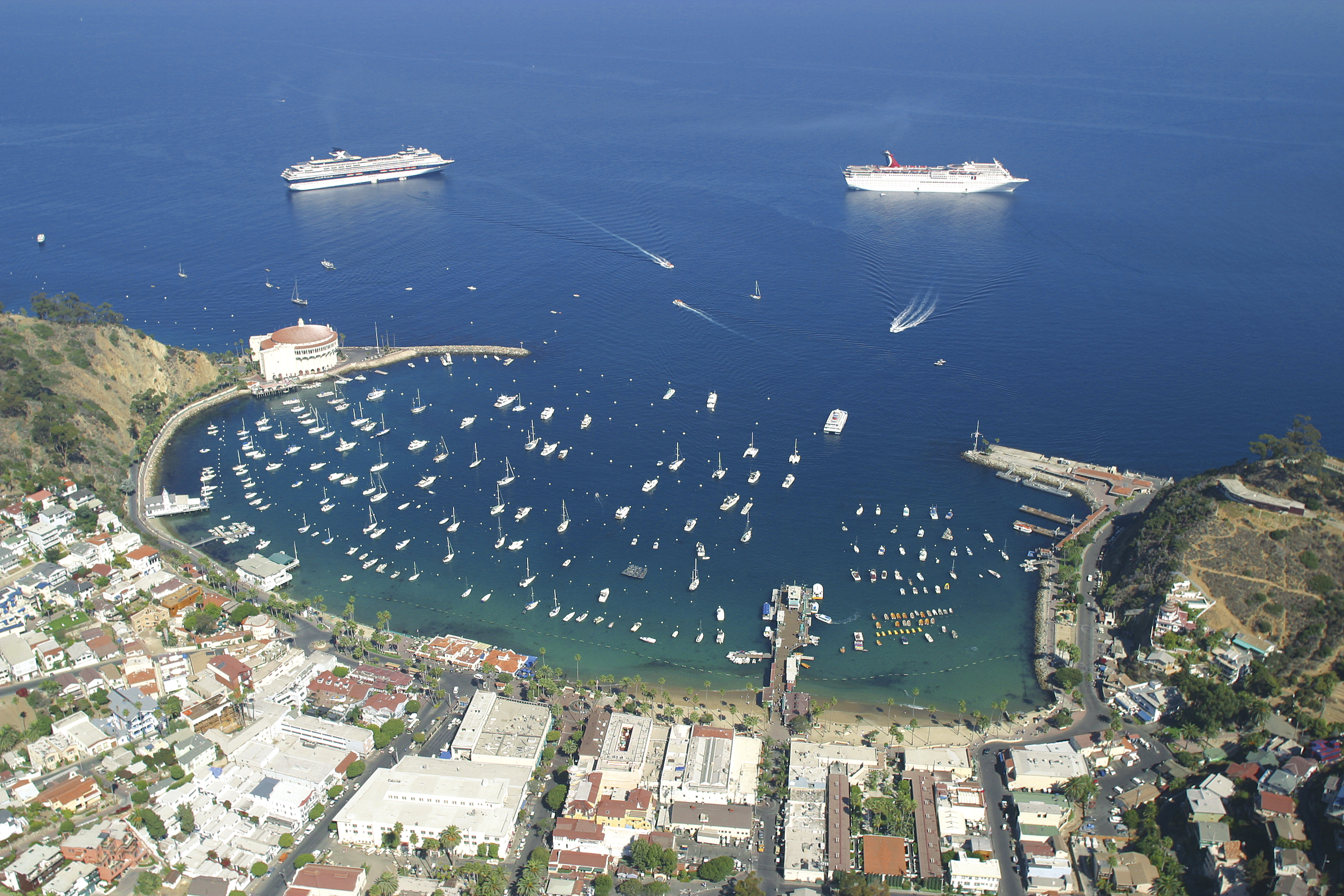
Avalon Bay with the Casino at the left entrance to the bay and the Cabrillo Mole at the right entrance to the bay. (Photo courtesy of Avalon Chamber of Commerce)
Imagine yourself just arrived at Santa Catalina Island and the romantic city of Avalon. Just twenty-two miles from Long Beach, the short, one-hour ride on the high-speed catamaran ferry was smooth and, as you neared the island, a vast school of dolphin surrounded the ferry. They followed you nearly into the bay and seemed to be offering a greeting to your arrival. The landing itself was almost anti-climatic. You haul your bags up the plank from the ferry and see, upon touching dry ground, a group of anglers directly across from you.
Intrigued, you amble the hundred or so feet over to where they are reeling in fish and are startled by the sight. Straight down from the railing is deep, crystalline water, water so clear that the image presented is that of an aquarium rather than being at the edge of a Pacific island.
In that water is a forest, a kelp forest, and amidst the tidal surge the leaf-like glades of the giant kelp are pushed into your view, leaves several yards long and attached to a plant whose size would seem to rival that of Jack-in-the-Beanstalk fame. And while the leaves reach up and kiss the surface of the water, the main body of the plant disappears down to the bottom of the sea more than 20 feet below.
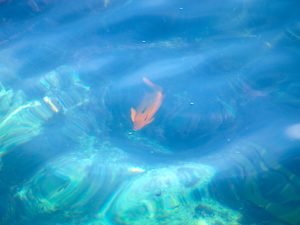
Soon you spot the fish as they languidly swim from frond to frond: beautiful, bright, orange-colored garibaldi, blue-colored halfmoon and greenish-blue opaleye.
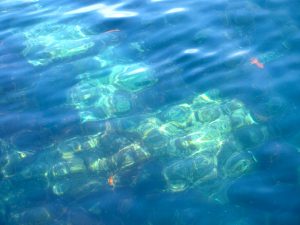
If you’re lucky you might even spot the amber-colored kelp bass, kelp perch and kelpfish whose colors so closely mimic the brownish-gold colors of the kelp and are nearly indistinguishable from the vegetation itself. Sometimes those species are found in the dense canopy that can form near the surface, sometimes they’re hanging out on the bottom just a little out of sight.
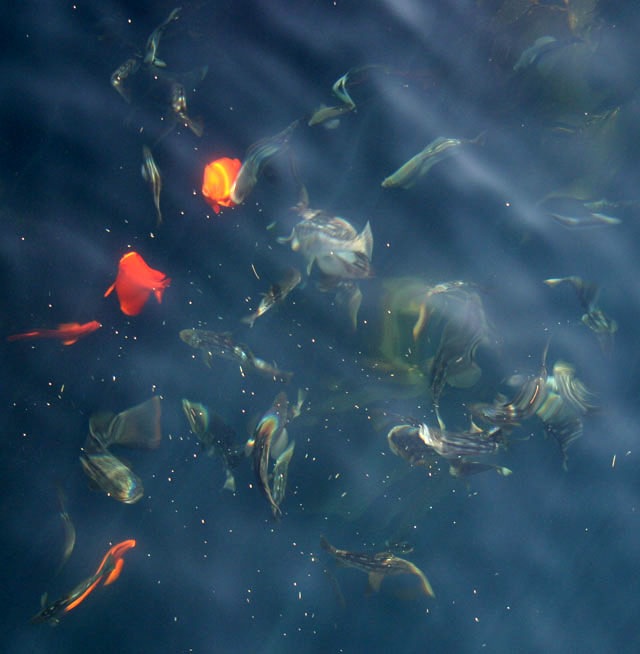
Rarely is a California angler presented such a sight, especially a California “pier rat,” but here that view is the norm. Rare is the time when Catalina’s waters aren’t clear and the fish not present in somewhat unbelievable numbers.
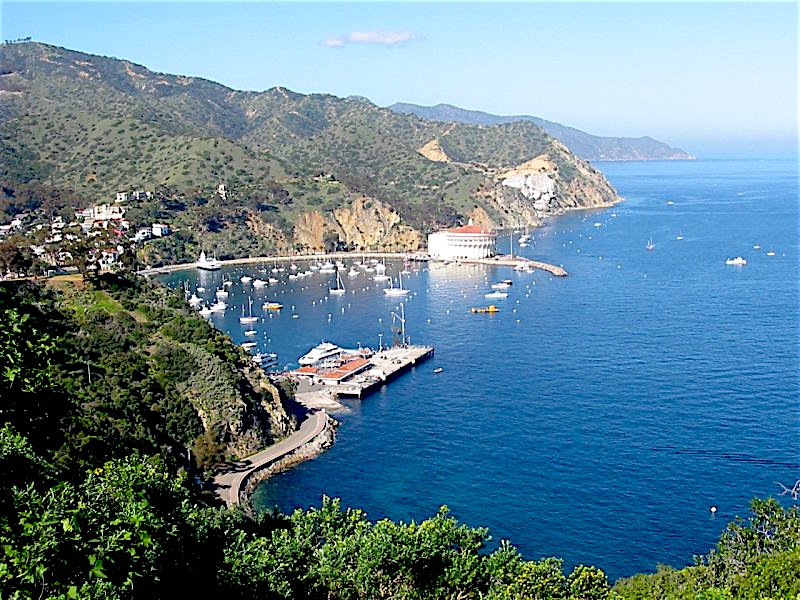
A road winds along the shoreline from Pebble Beach to Avalon Bay, past the Mole, and into the city.
Environment. In the late 1960s Avalon decided to tear down the old “Steamer Pier” that had been used for over 60 years to unload passengers from the S. S. Catalina (and other ships). The pier, located near the Green Pleasure Pier, was old, in need of repair, and took up too much space — space on the small beach that could be used by bathers; space in the bay’s waters that could be used for additional yacht moorings.
Instead a Mole (basically a jetty or breakwater) would be built at the southwest corner of the bay. A concrete pier would then be placed over the Mole, which would be the new “pier” for landings. The S. S. Catalina would tie up on the ocean side of the Mole and disembark passengers directly onto the pier. That was the plan! However, almost from day one, the landings were both difficult and, at times, unsafe.
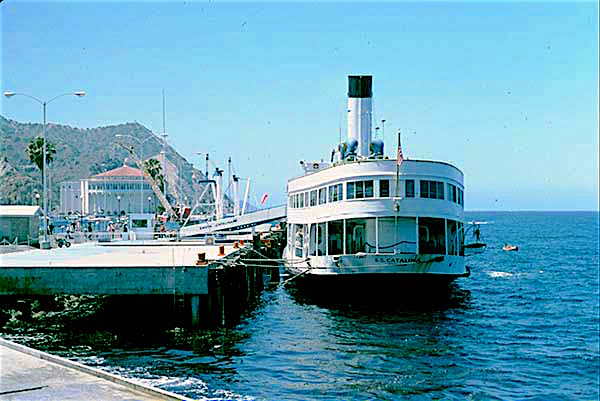
A scene at the Mole
New pier problem surges at Avalon
Members of the Avalon City Council, cringing after viewing damage to their new $2 million steamer dock caused by two accidents in the past 11 days, are perturbed by the prediction, “the worst is yet to come.”… On July 19 as the 299-foot cross-channel cruise ship was tied up at the new wharf surging seas shoved the vessel against the pilings, causing nine of them to snap like matches. Fearing for his ship, Capt. Lloyd Fredgren ordered crewmen to use a fire axe to chop the eight-inch nylon stern line as so he could head for the comparative safety of the open sea. —Long Beach Independent, July 28, 1969
The piles were fixed but the problems continued. What to do? The Steamer Pier was now gone but the city still had the Mole. Why not make the landings on the inside or bay side of the Mole since the Mole provided protection against wave and surge?
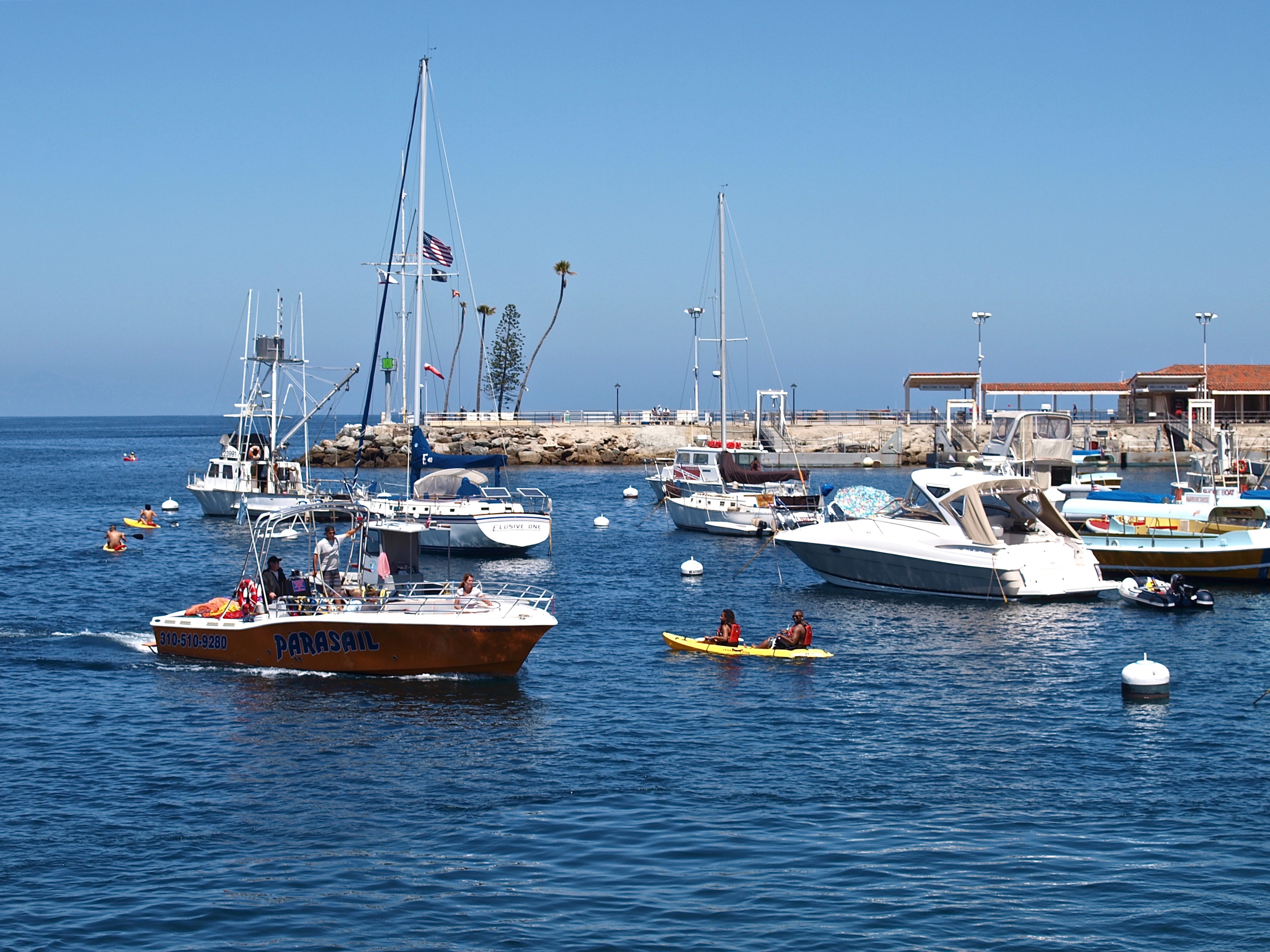
The Mole’s backside as seen from the Green Pleasure Pier. Landings for the various ferries are on the inside of the Mole.
Ultimately a number of landings (floating docks) were constructed just inside the Mole—which is what is seen today. They vary in size and can handle all of the various ferries and landing craft that are too big for the Green Pleasure Pier.
The Cabrillo Mole is still used by passengers on the largest ferries (since the main and largest landing is adjacent to the Mole). Well-kept restrooms, storage lockers, ticket offices, and a snack shop are all located on the Mole.
Most important for our story is the fact that the ocean side of the Mole, the part deemed unusable for boats, offers great public access for recreational fishing—in an environment unique for a California pier. A bonus for both in-state and out-of-state visitors is the fact that the pier is considered a public pier and no license is required.
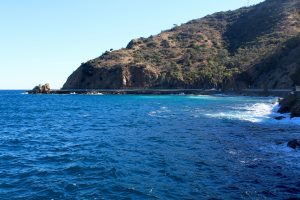
To the right of the Mole (when looking seaward), just a short distance away, sits Lover’s Cove; a long established state reserve (and now marine protected area) filled with an abundance of sea life—fish, anemones, sea stars, nudibranchs, etc. It runs to Abalone Point.
The cove is the favored home for the glass bottom boats and the so-called submarines that travel out from the Green Pleasure Pier. The favorite fish of these craft is the brightly colored garibaldi, the goldfish of the sea, fish that are easily spotted in the water by the tourists. Large sheephead and bass are also often spotted along with myriads of smaller species.
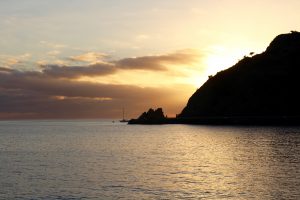
The fish are stuffed! Stuffed? No they aren’t artificial fish placed there to fool the tourists. No, they are simply stuffed with food. The glass bottom boats have tubes that allow passengers to drop fish pellets down to the fish. The fish also get a steady diet of goodies, especially peas, courtesy of the snorkelers who have made the cove their favorite spot. The daily feedings tends to concentrate fish in the area and helps explain the numbers of fish at the nearby Mole, it also explains why peas are readily accepted as bait for so many species at the Mole.
Many a visitor will wet his or her fishing line and hopefully, if the fish like what they see, they will grab one of the angler’s baits or lures. Of course then you have to keep the fish, line, and sinker out of the kelp, a nearly impossible task at times. It depends on the area you are fishing, the direction of the current (which affects the way the kelp is laying), the surge, the size of your fish, and the strength of your line, but it can be done—sometimes.
As in real estate, the key to the Mole’s success is location. Catalina Island has from its earliest days been a mecca for California saltwater anglers. The island is close to deep water and closer than the mainland to currents flowing north from Baja. Although water temperatures mimic those found along the coast, the “cleaner” water and associated currents seem to provide a beneficial home to many species, both resident and non-resident species. Thus a greater number of the more southerly pelagic species, i.e., bonito, barracuda and yellowtail show up at the island and some venture close in to shore (and the Mole). Occasionally, the warmer water may even attract a species that’s traveled north during an El Niño year and settled into the island’s environment (i.e., largemouth blenny). You just never know.
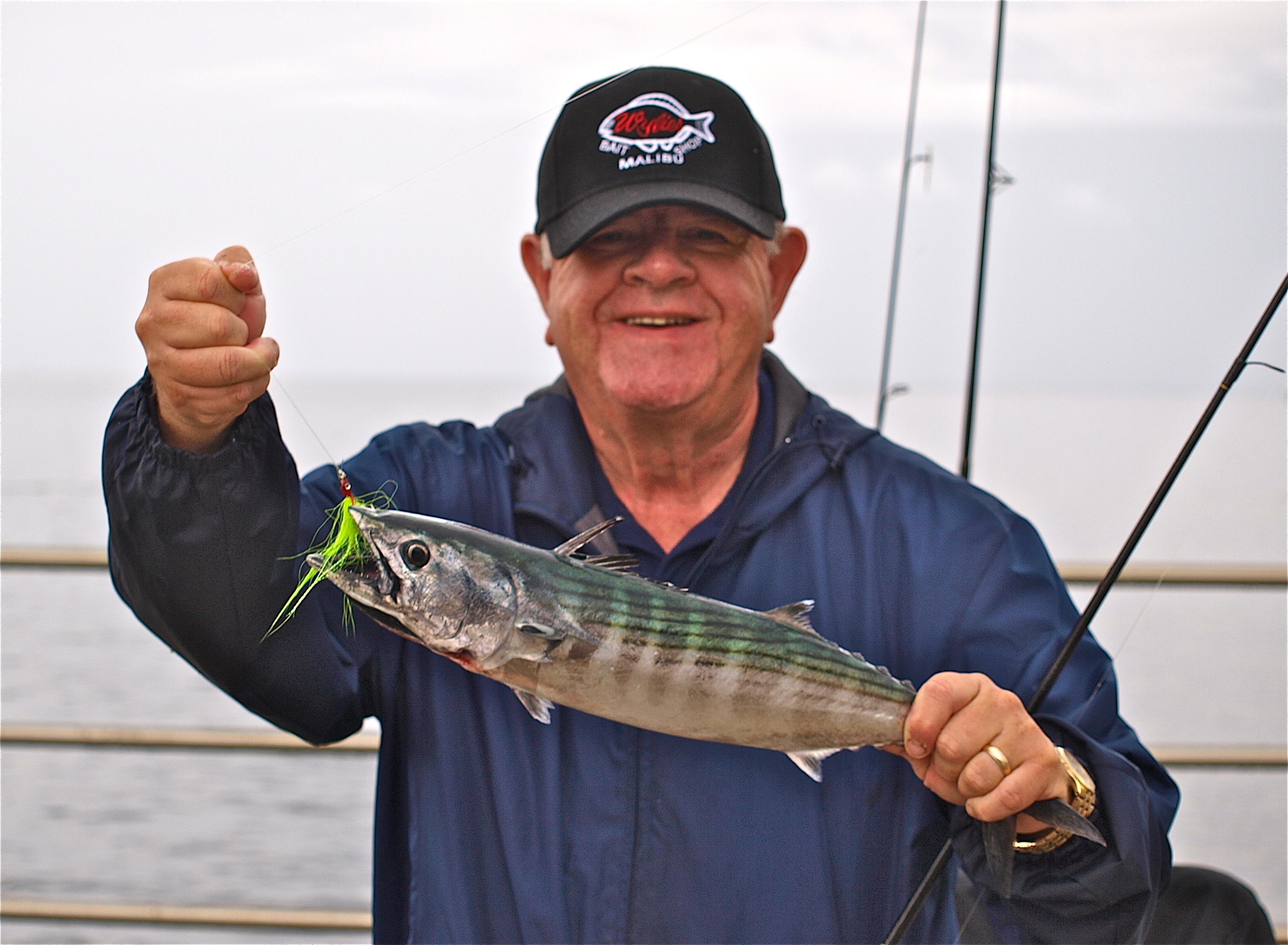
Pacific bonito by KJ
Important is the rocky shoreline structure under the Mole and the kelp that typically surrounds the Mole. The rocks attract rock-frequenting species while the kelp environment itself attracts many different species. Few mainland piers are built over or even next to rocks and none of the mainland piers see the numbers of opaleye, halfmoon, sheephead, ocean whitefish, kelp bass and several other species seen at the Mole.
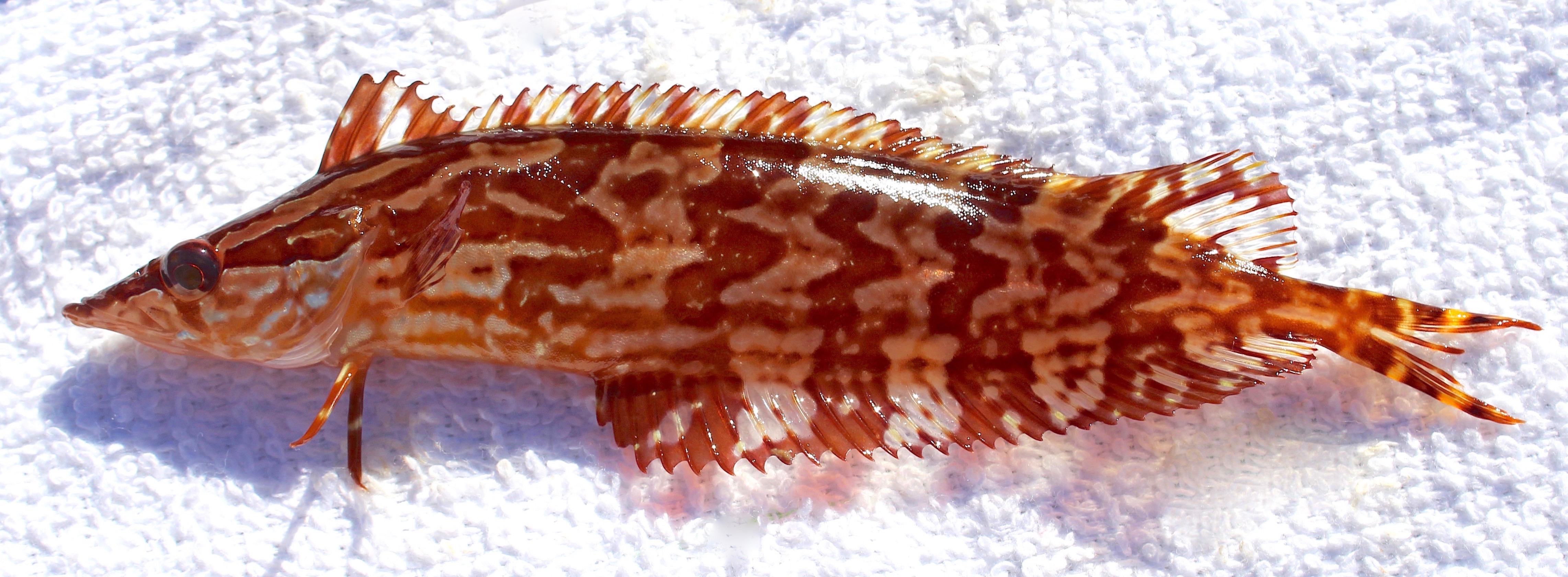
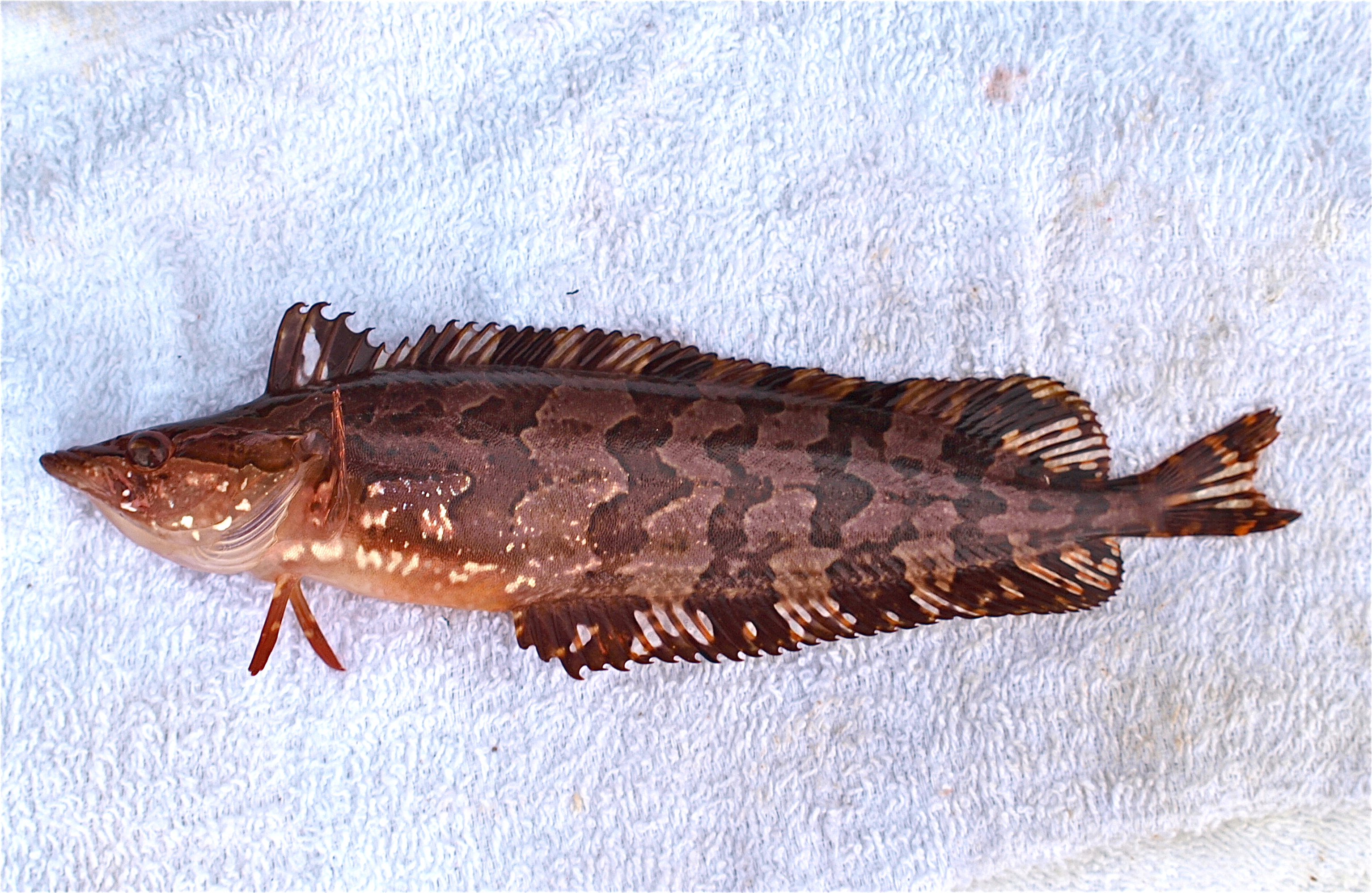
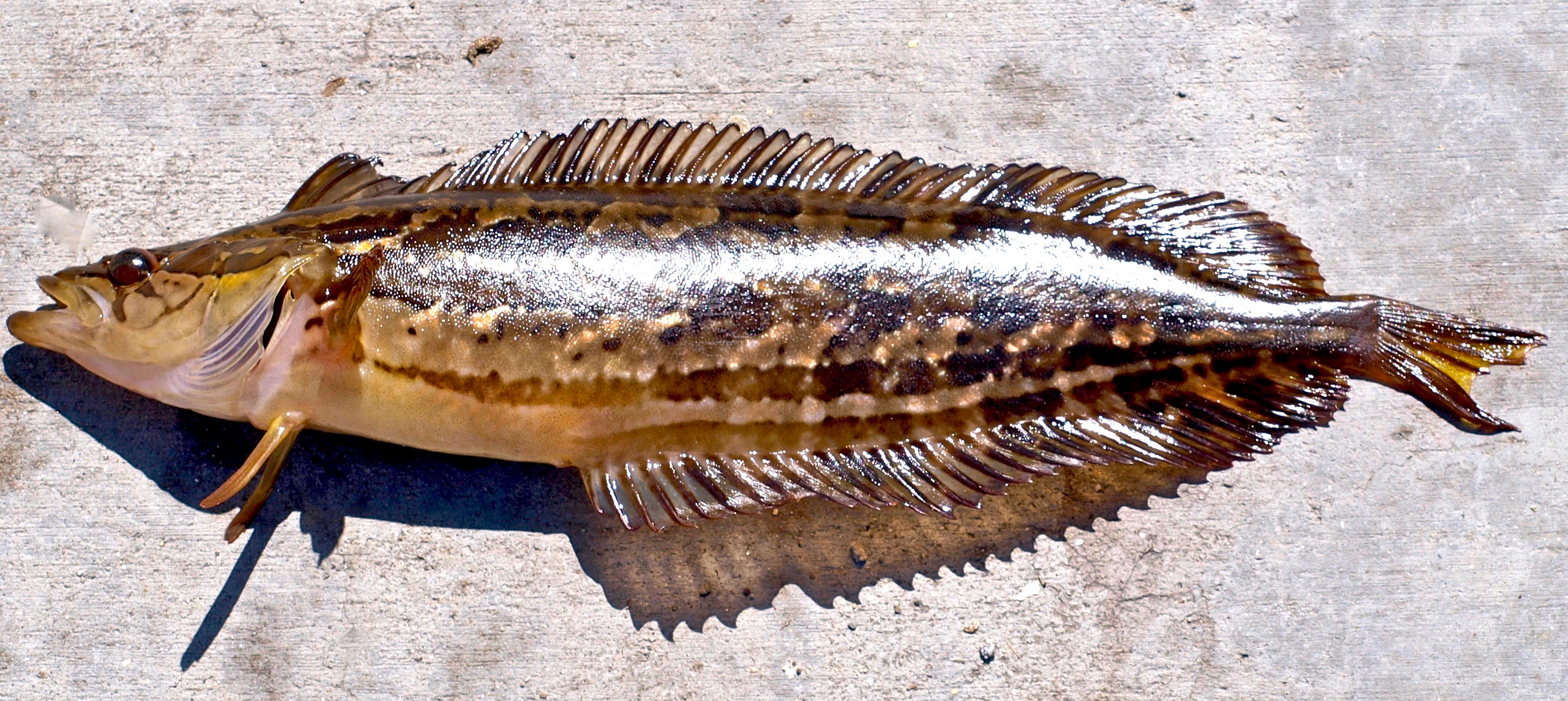
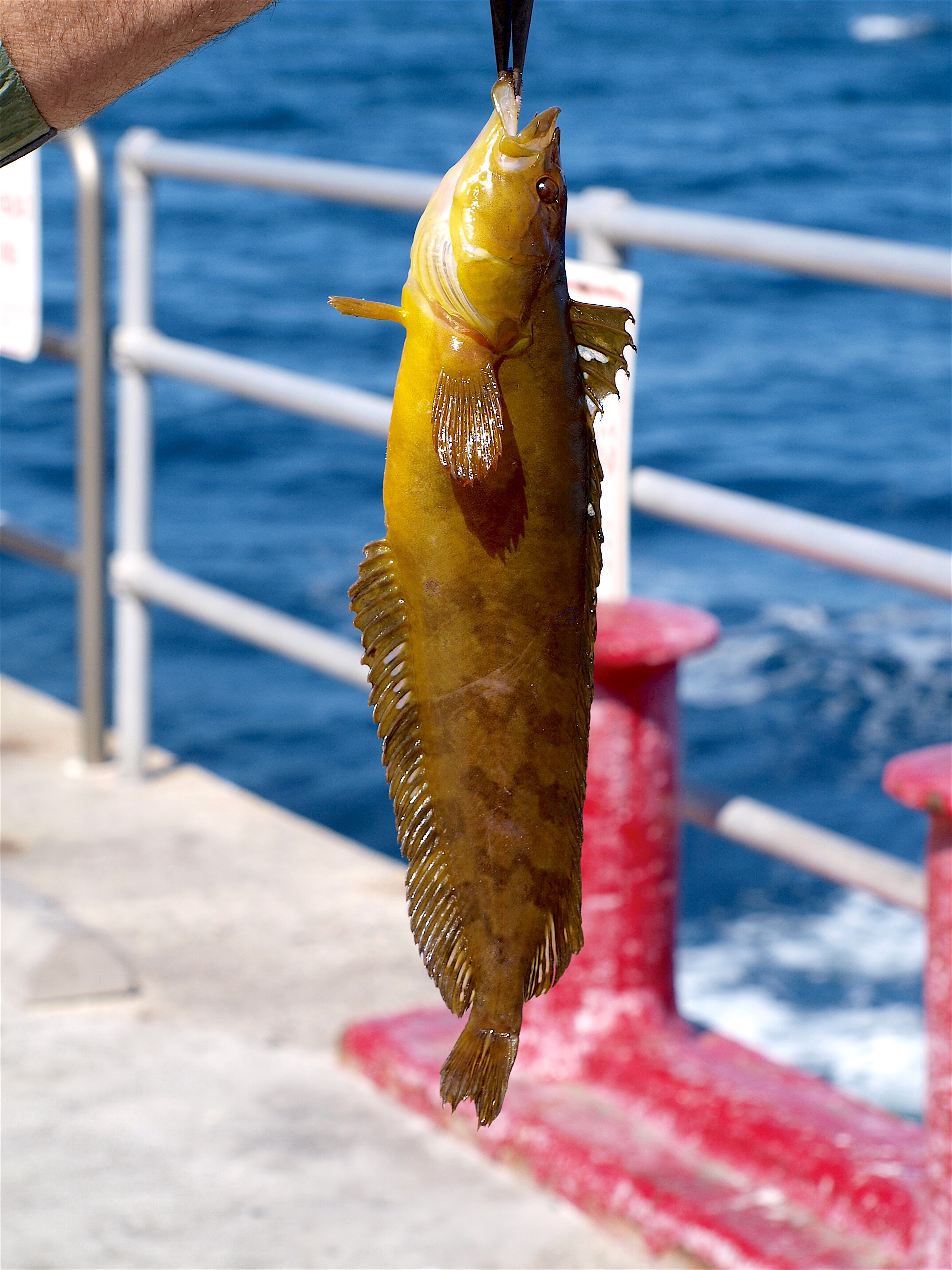
Giant kelpfish come in different colors
Lastly is water depth and while the bottom around the Mole is fairly shallow, Catalina is an island and sees a quick drop-off in depth. Water depth tends to be around 20 feet deep at the Mole and ranges between 20-30 feet deep in Lover’s Cove, between the Mole and Abalone Point. But, the depth drops to 70 feet and then to over a hundred feet deep not too distant offshore. If looking at the channel leading into Avalon Bay, the mid-point between the Mole and Casino shows a depth of 96 feet.
One result can be good runs of pelagic species and occasional sightings of the bigger species. Giant sea bass are common to the area and during 2015, an El Niño, warm-water year, two wahoo were spotted in the cove from one of the Catalina submarines. Unverified reports said a dorado (aka dolphinfish or mahi mahi) was also seen. Squid can spawn in nearby waters and when they do the white seabass may show in an early morning visit. Again, you just never know.
The fact that the Mole sits on a tourist island also yields an ambiance that is hard to describe but easy to feel. During the day it can be a crowded ocean. Passing through the Mole’s waters will be glass-bottom boats, the semi-submersible submarines (yellow and red), kayakers, and yachts of every size and shape.
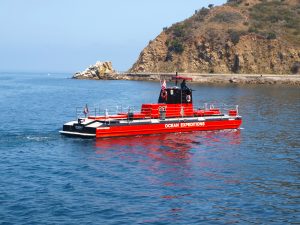
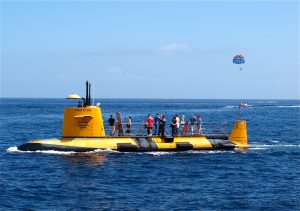
Up in the sky, often high in the sky, will be adventurous people hanging from their brightly colored parasails.
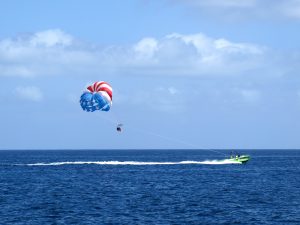
On cruise ship days, the large ships will be anchored slightly offshore. Eventually a flotilla of small craft (tenders) will invade the harbor, tie up to the smaller landings by the Mole, and the hoards will stream ashore. Soon the shops and restaurants along Crescent Avenue will be filled with happy visitors and smiling entrepreneurs.
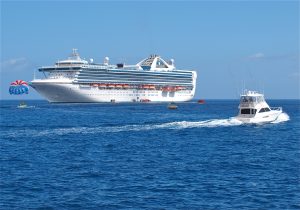
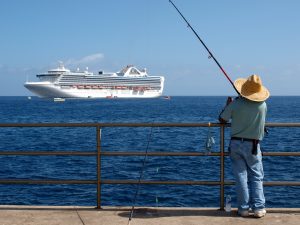
At the Mole there will be a parade of ferries coming into and leaving the bay. With them will be what at times seems to be a never-ending group of visitors to the island. Inevitably some of the visitors will wander over and ask a question or two. How’s fishing? What do you catch here? What’s that orange-colored fish? What equipment do you need? Most will be courteous.
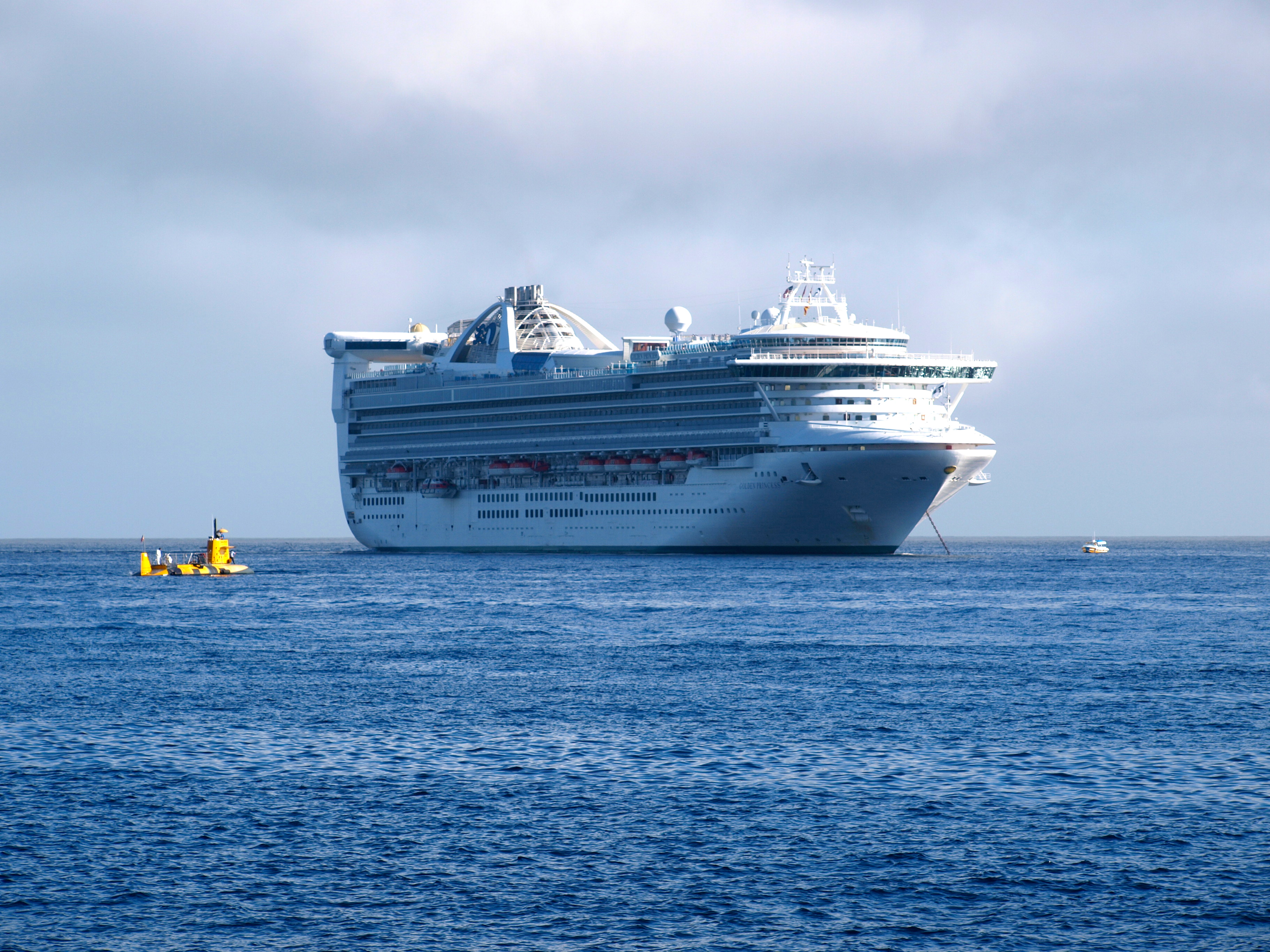
I hope the sub doesn’t try to sink the ship!
Luckily at night you’re usually alone or at least mostly alone. You’ll have the ocean to yourself, the stars in the night sky, and the lights surrounding the crescent-shaped bay to keep you company.
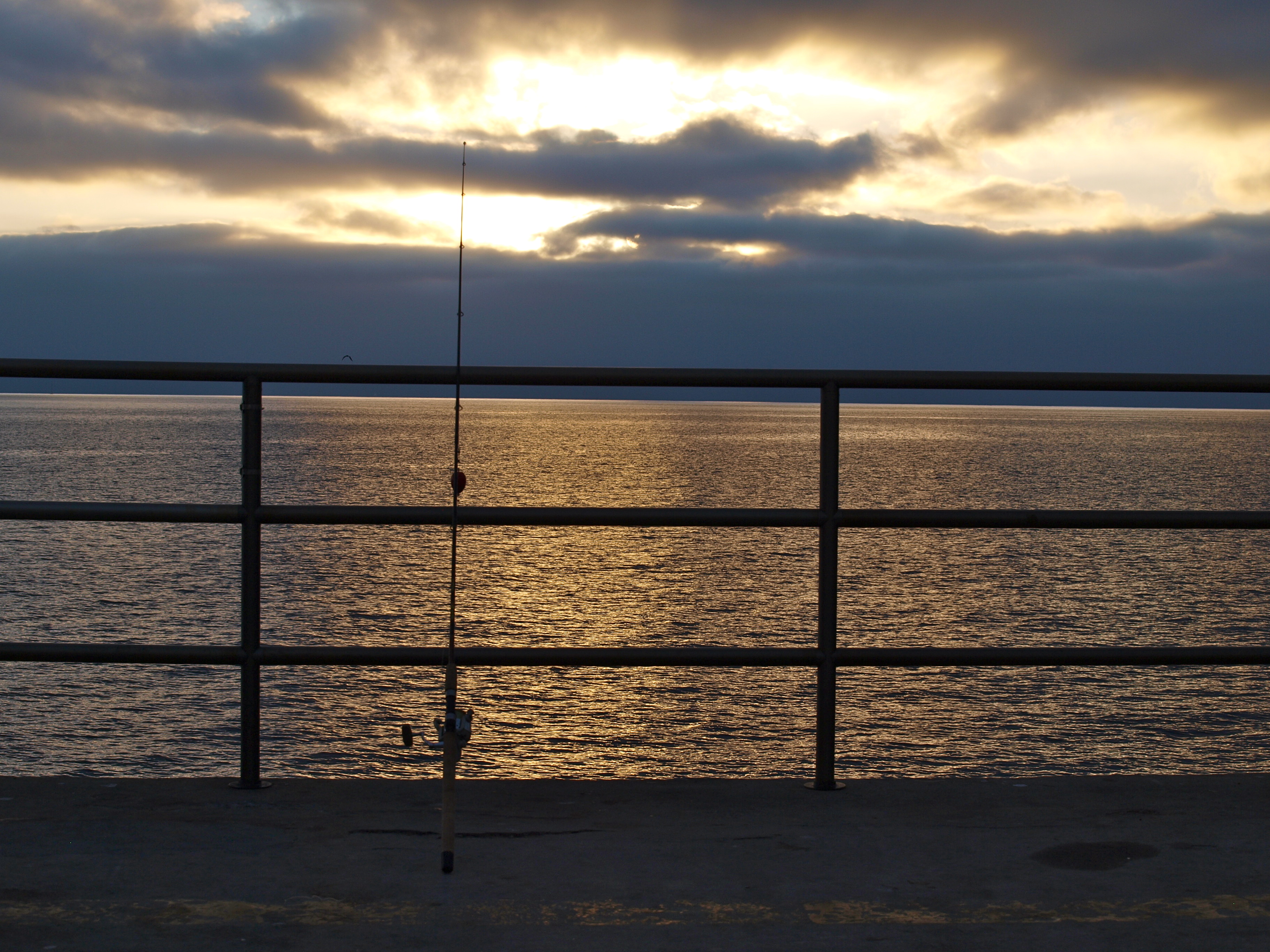
A word of advice: the Mole extends out at the entrance to the harbor and as such is wide open to the elements; it can get quite windy at times. A person can be on the Green Pleasure Pier in the bay, just a few hundred yards away, and be short sleeved and comfortable while a person on the Mole needs a jacket and is cursing the wind.
In Denmark there is a saying—“Det blæser en halv pelikan” (“It’s blowing half a pelican”) which simply means it is super windy. As far as I am concerned it was blowing a full pelican the night I spent on the Mole during a lobster expedition in March 2010. It was one of the coldest nights of my life and the memory still gives me goose bumps and chills. My friend Mahigeer (Hashem Nahid) had already made several trips for the bugs that winter and warned me to bring warm clothes—and I thought I had. However, I didn’t realize you sometimes might need a fur-lined parka, hand warmers, and three layers of clothing in Avalon. But when double red flags are blowing, ferry trips are cancelled, and a low 50-degree night is mixed with winds 30 mph and higher, it can feel like the low ‘20s. That night I didn’t follow the 7 P’s that I always preach—Proper Prior Planning Prevents Pi.. Poor Performance, and I suffered the consequences. The wussy suffering of that night is detailed in greater depth in the section (below) titled “Potpourri.”
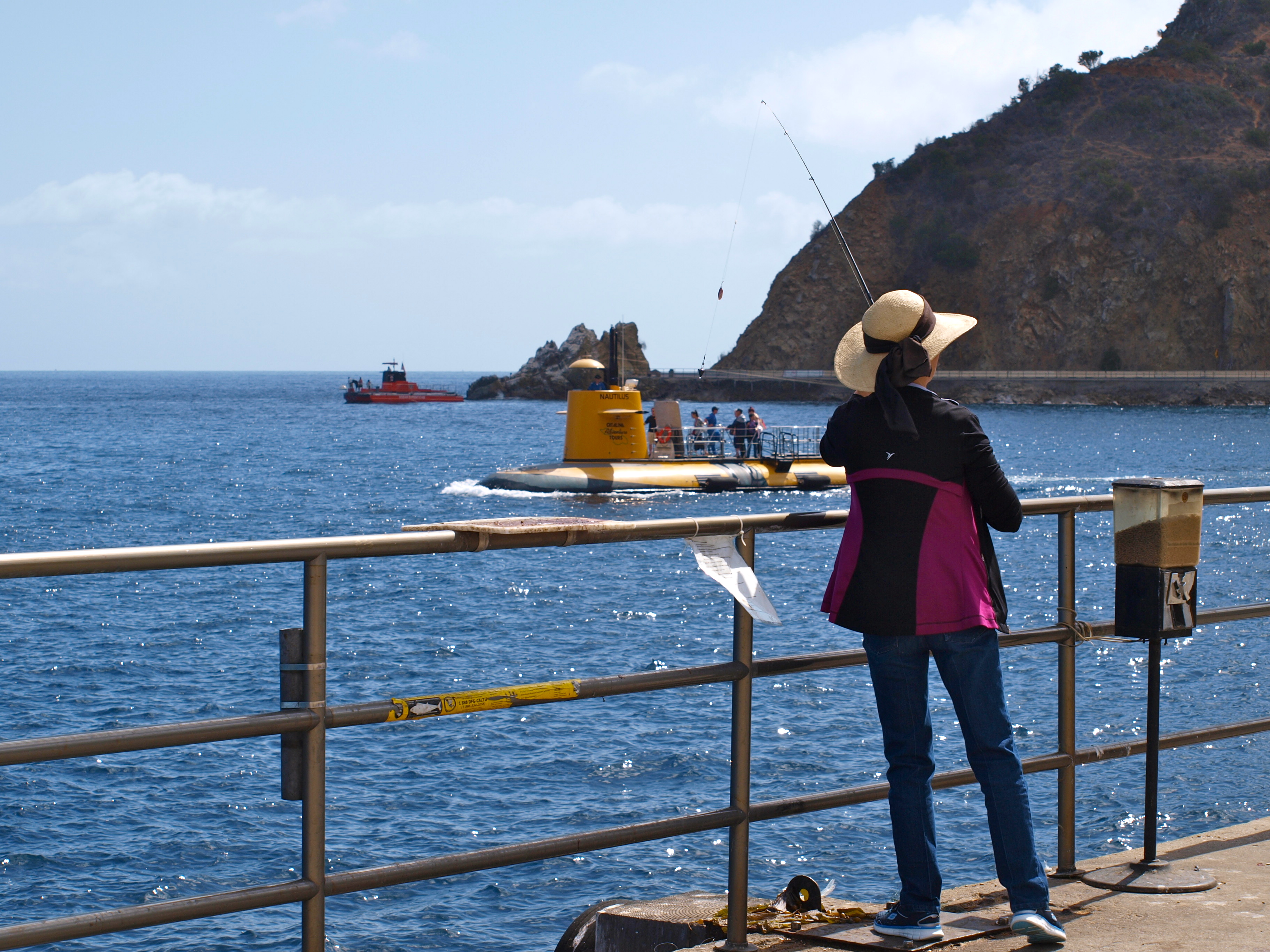
The Fish. The variety of fish, even more than size or quantity, is what most attracts me to the Mole and it’s a big reason why this pier is one of my favorite piers even though it’s not the prototypical pier.
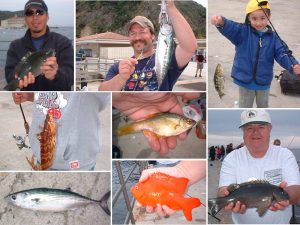
Variety—(top row—opaleye, bonito and kelp bass); (middle—giant kelpfish and kelp perch); (bottom—bonito, garibaldi and opaleye).
However, even if the variety is what I find most intriguing, the overall catch numbers at the Mole, and the chance to sometimes catch bigger fish, are pretty impressive in themselves.
Starting in 2002, Pier Fishing In California (pierfishing.com) began a yearly “Get Together” at Avalon (which later evolved into a joint “Get Together” with United Pier and Shore Anglers of California—UPSAC). Those trips prompted additional visits that occurred throughout the year. The results were several hundred hours of fishing and data that I feel is accurate even if anecdotal in nature. The result for slightly over 40 trips to the Mole is an average of 6.74 fish per hour and 14.89 points per hour (a figure using number and size of fish).
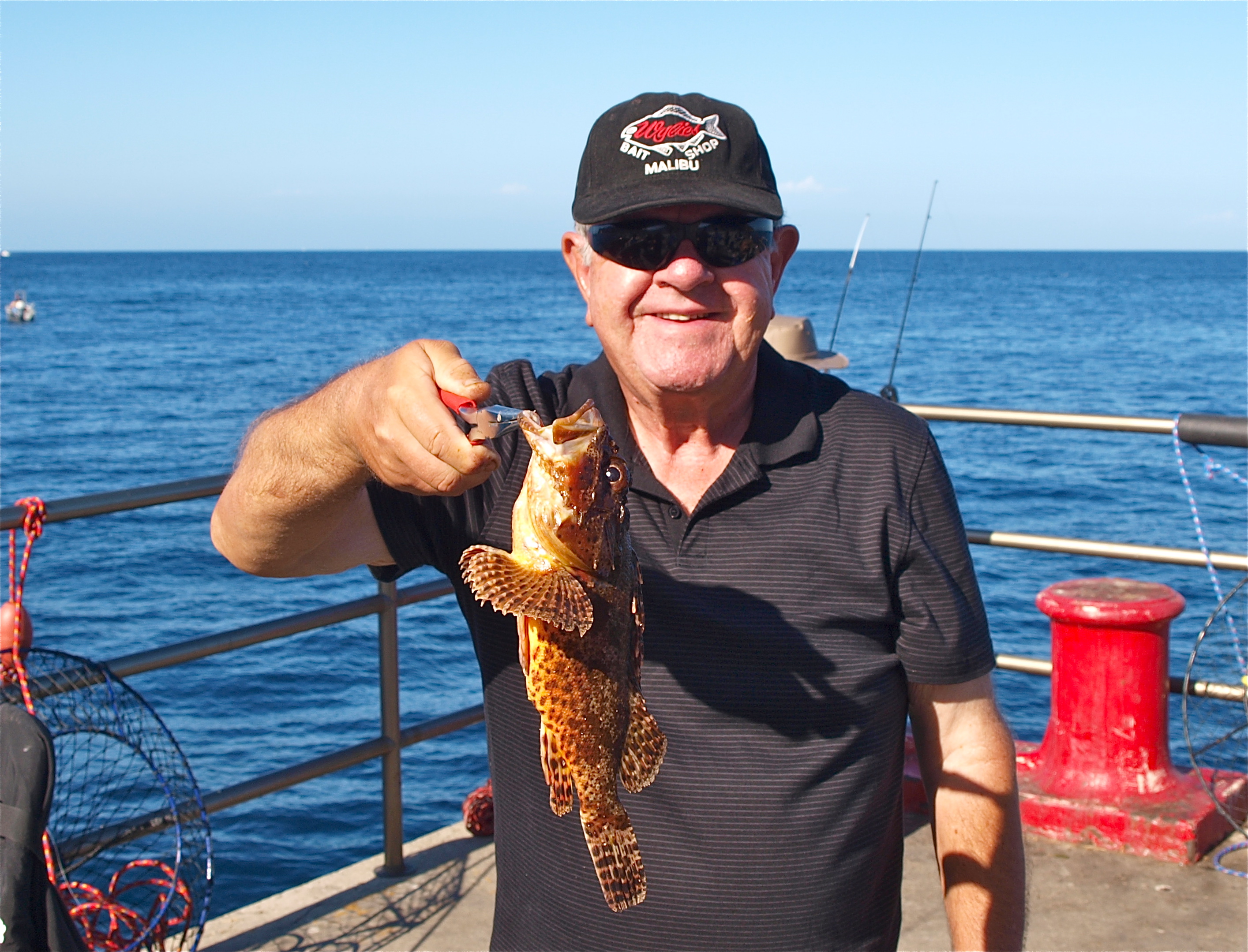
KJ and a scorpionfish
As to variety, I have landed 33 different species at the Mole and have seen many additional species landed (which I hope to get some day). The fish, in order that I caught them, include kelp (calico) bass, giant kelpfish, senorita, striped kelpfish, rock wrasse, kelp perch, garibaldi, blacksmith, Pacific mackerel, sheephead, opaleye, halfmoon, jacksmelt, treefish, California scorpionfish (aka sculpin), crevice kelpfish, Pacific bonito, brown rockfish, kelp rockfish, rubberlip seaperch, Mexican scad, olive rockfish, spotted kelpfish, ocean whitefish, salema, jack mackerel, black seaperch, finescale triggerfish, Pacific sardine, cabezon, grass rockfish, moray eel and largemouth blenny. An occasional spiny lobster also latched onto a baited hook.
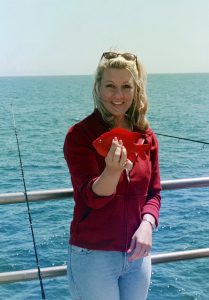
My daughter Kim and a garibaldi
In addition, I have also seen several other species caught at the Mole including barracuda, yellowtail, horn sharks, swell sharks, bat rays, and giant sea bass. Again, you just never know what you’ll get.
Lastly, when looking at my records for single day, single pier, multi-species trips, the Mole is at the top of the list with a 16 species day, 15 species day, 14 species day, and numerous 13 species days. Only one mainland pier showed a 13 species trip, and just once—the Avila Beach Pier.
Most of these are regular, resident species that you should be able to catch on most trips to the Mole. These include kelp bass, opaleye, halfmoon, blacksmith, sheephead, ocean whitefish, scorpionfish, treefish, jacksmelt and several varieties of kelpfish. Less common but also resident species include cabezon, moray eel and finescale triggerfish.
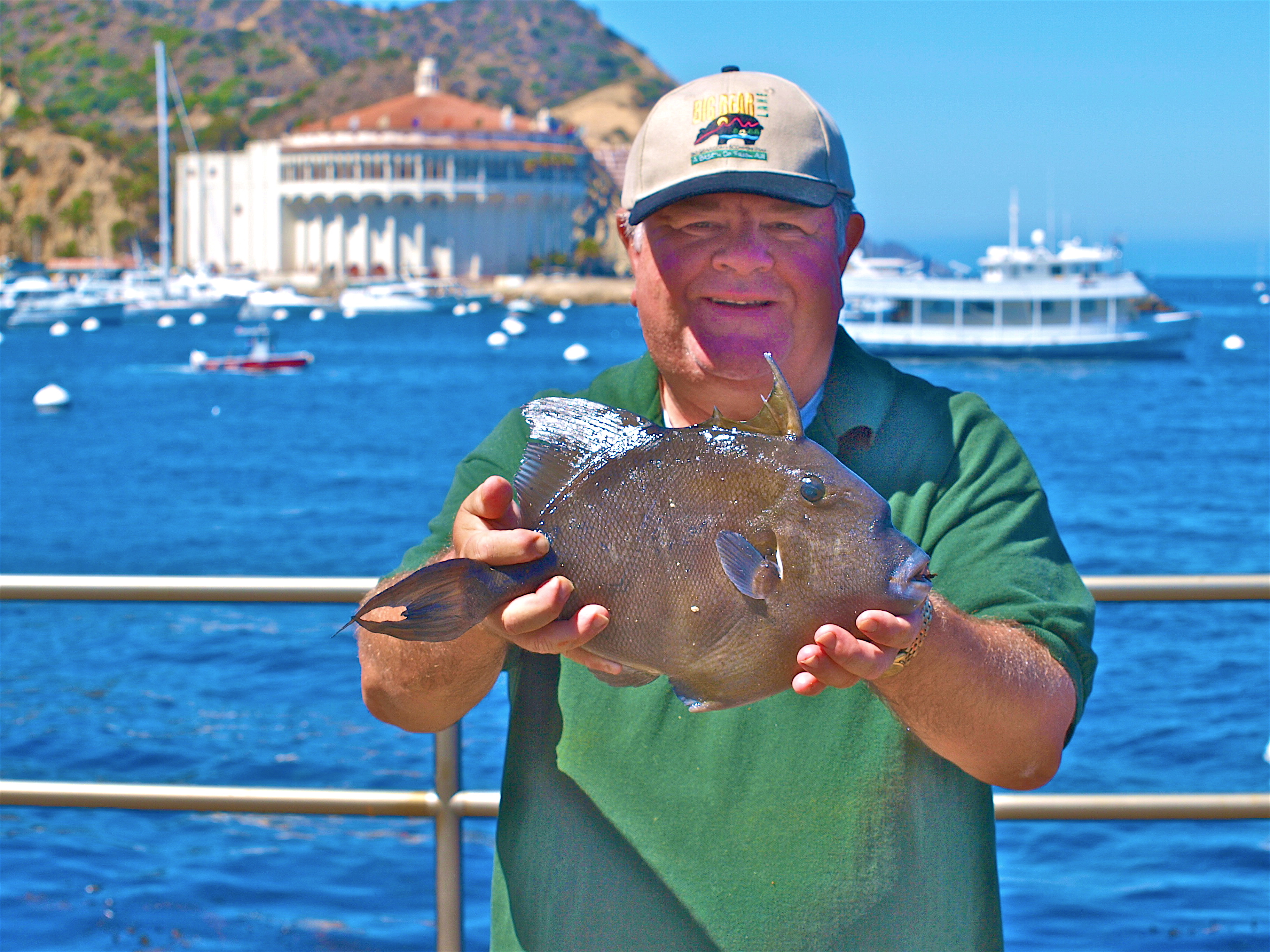
Finescale triggerfish caught by KJ in 2010
Pelagic species that can vary upon year and season include Pacific mackerel, jack mackerel, Pacific sardine, Pacific bonito, California barracuda and yellowtail.
Unusual/Rare Species. An unusual species that now seems to have made Avalon a home is the largemouth blenny, Labrisomus xantia, a fish that didn’t show up in California until 2015 when it was spotted in La Jolla. Since that initial sighting, it’s only been seen north of the border in La Jolla and Catalina. I’ve managed to catch four of the blennies, three at the Cabrillo Mole (June and December 2017) and one at the Green Pleasure Pier ( June 2017).
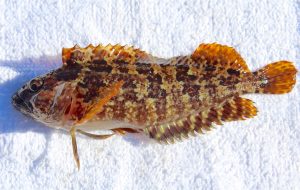
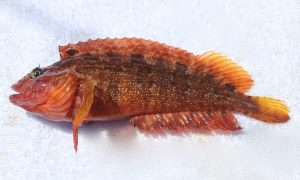
Largemouth Blenny
A rare fish was one I saw in December 2017. I was with my friend Hashem for a two-day combination fish and lobster fest—me fishing and he hoop netting. Hashem wanted some lobsters for Christmas and I was just “Jonesing” for a fish.
The last afternoon was spent fishing on the Cabrillo Mole with the usual species being caught. At 5:30, with darkness descending, I stopped fishing and headed over to get a cup of hot chocolate. Upon my return I packed up the gear and sat down to relax and wait for the last ferry back to the mainland.
My rest was interrupted when I saw a nearby angler pull in a fish. I walked over to see what he had caught which, I expected, would be a type of rockfish or a salema, both of which hit well at the Mole after it is dark.
The angler showed us the fish that he said he had caught on a small piece of market shrimp. It was a species that was new to me (and a quick check of my reference book did not reveal a picture). My first thought had been of a juvenile giant sea bass (it was only 5-6 inches long) but the fin structure was wrong. My next thought was of a popeye catalufa, the fin structure was about right but the color was wrong. My friend Hashem and I talked the angler into letting us take a couple of quick photos before returning the fish to the water. Since I am always seeking out new species, that fish, even though I didn’t catch it, highlighted the trip.
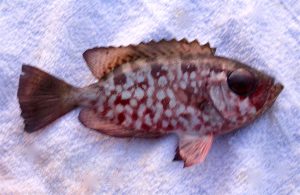
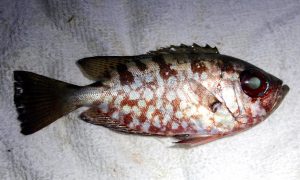
The “mystery fish” showing signs of stress and changing color.
Upon returning home I sent a copy of the pictures to Milton Love at UC Santa Barbara for identification but he said he’s never seen it before. He said he would send the pictures out to a network of experts who should be able to identify it. It took a while (with input from both scientists and members of the Pier Fishing In California community) but eventually it was decided that the fish was probably a Pacific glasseye, Heteropriacanthus carolinus, a fish more common to Indo-Pacific waters like Hawaii and Australia. Unfortunately, we had returned the fish to the water which Mr. Love let me know is generally a good thing to do but in this case might have been a mistake (me bad). Given that it may have been the first recorded sighting of the fish in California the scientists would have loved to get the actual fish for study.
An uncommon fish to SoCal waters, though one seen occasionally at the Channel Islands, is the rainbow scorpionfish, Scorpaena xyris. I have heard mention of the possible catch at the Mole several times and finally, in August 2021, got the picture of one that had been caught by Evan Yeh.
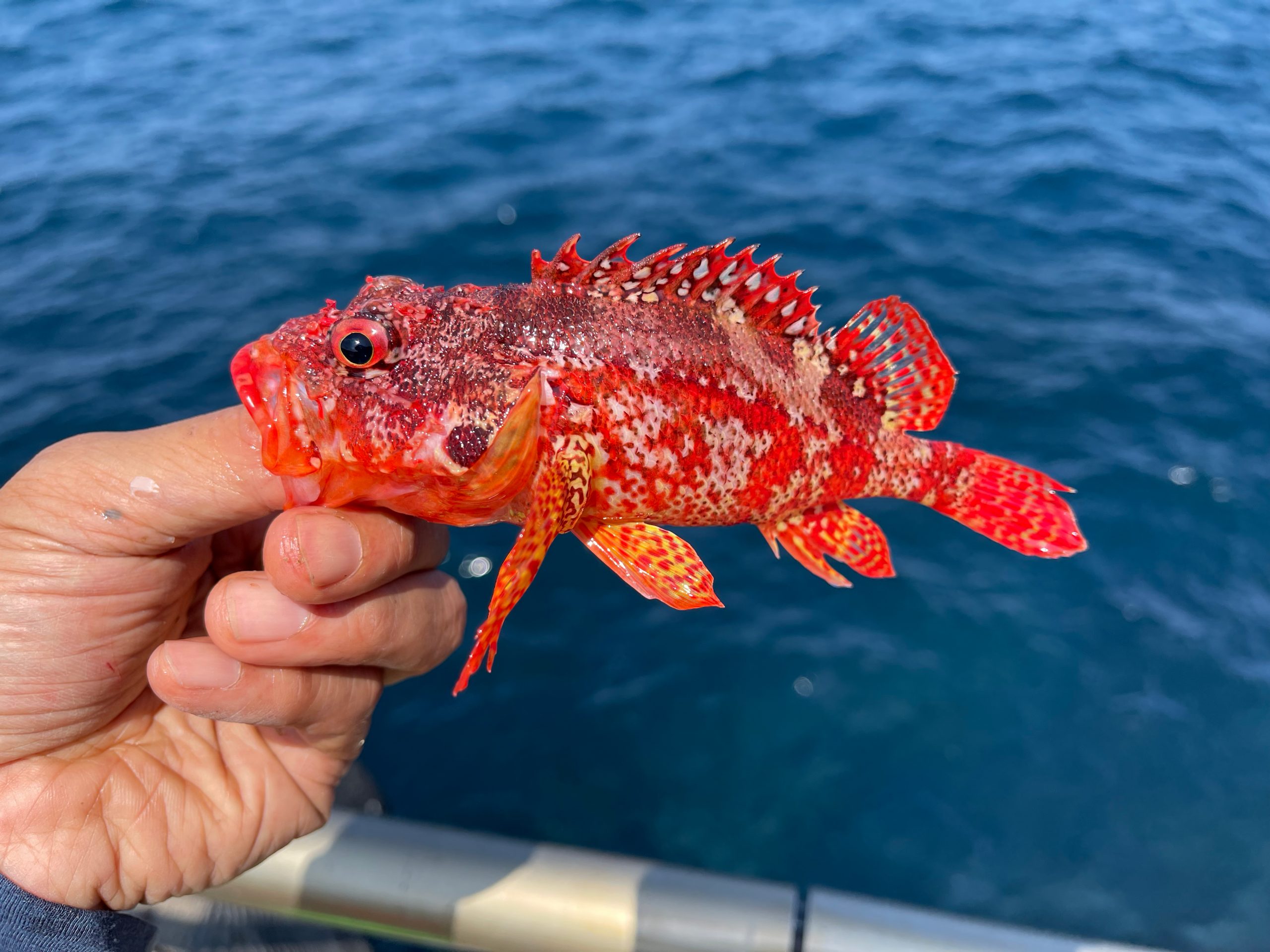
Rainbow Scorpionfish — Photo courtesy of Evan Yeh.
Fishing Tips. Perhaps somewhat surprisingly, not a lot of different techniques or riggings are required to successfully fish the Mole. A high/low rig will essentially catch any fish at the Mole excepting perhaps bonito (although I have caught a couple on high/low riggings at other piers). Nevertheless, more specialized rigs are better for certain species—specifically opaleye and bonito.
- High/Low Rig —The most common rigging used is a high/low rigging; it is the rig that I primarily use and it has probably caught 95% of my fish at the Mole. The rig is simple: a sinker at the bottom, one hook on a short leader about a foot up from the bottom, and a second hook about 12-18 inches above the bottom hook. I use two variations depending upon where I am fishing and what fish I am trying to catch.
- Light Tackle High/Low —Several of the main species—opaleye, halfmoon, blacksmith, rock wrasse, kelpfish and several other smaller species are both hook and line shy. Best hook size is no. 6 or even no. 8 with 6-8 pound line (and I always use fluorocarbon line that is nearly invisible). I use a ½-1 oz. torpedo sinker depending upon the rod I am using.
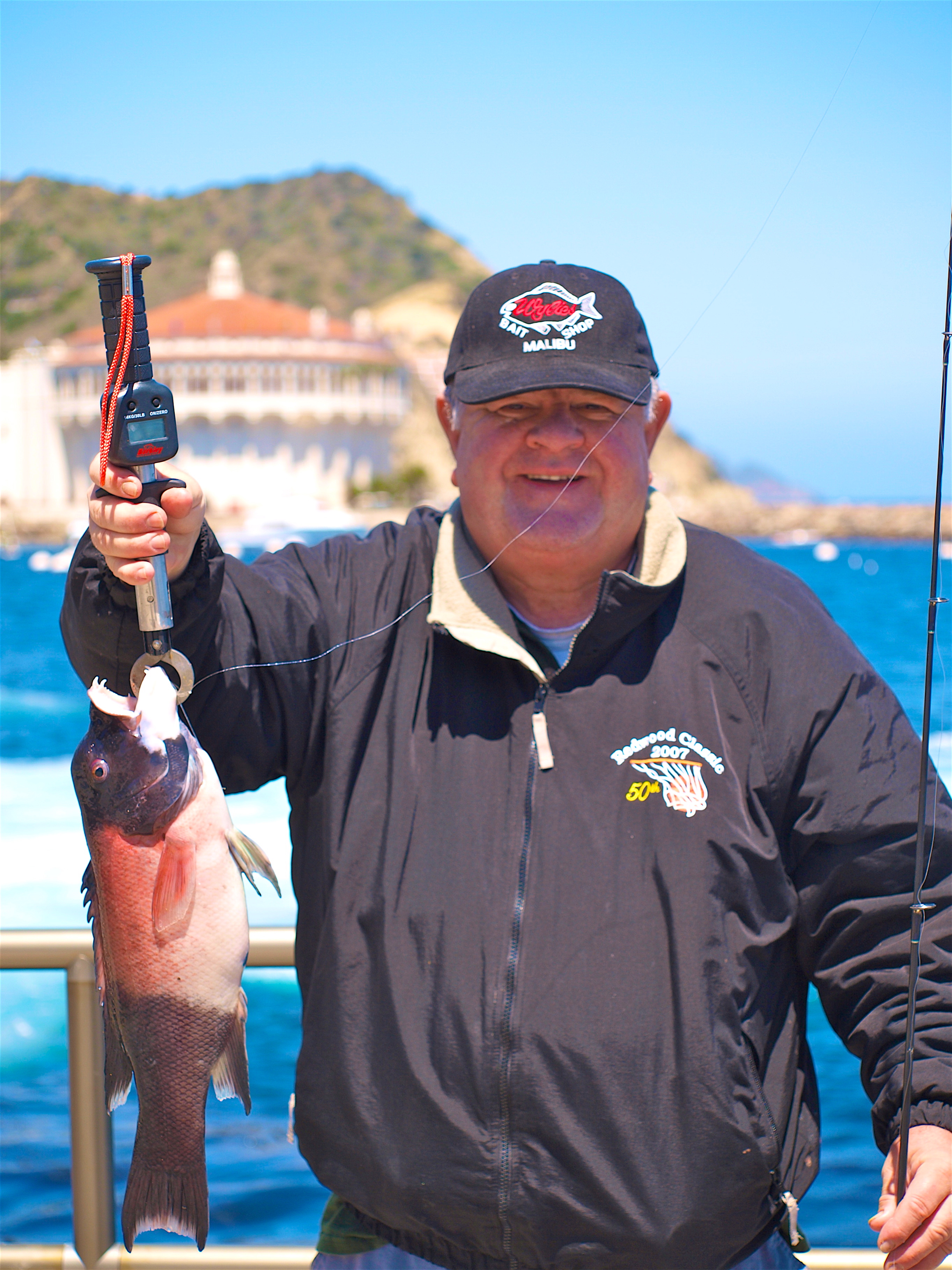
Sheephead caught by KJ on a high/low rigging baited with ghost shrimp
For the bottom-dwelling species—sheephead, kelpfish, scorpionfish, whitefish, rockfish, bass, etc., I fish straight down from the railing or I make a fairly short cast under or out from the pier.
To date, I have not found an area that is particularly better along the end railing although the left corner is close to the deep-water channel into the harbor and the cut-out section, mid-way on the right side, has a lower level near the water that some people like.
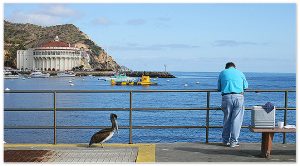
Fishing the end section with a pelican buddy keeping me company
A favorite area for me is the inshore rocky areas found at both ends of the Mole. Here you can drop your bait down into the crevices between the rocks. I look for channels between the rocks and rocks that may have holes under them. Both areas often hold fish. Drop your bait down between the rocks, let the current sweep it under the rocks, and be prepared for a quick strike. Unfortunately these inshore areas can be unfishable at times depending upon the tide and surge conditions. High water with minimal surge is the ideal time to fish the rocks.
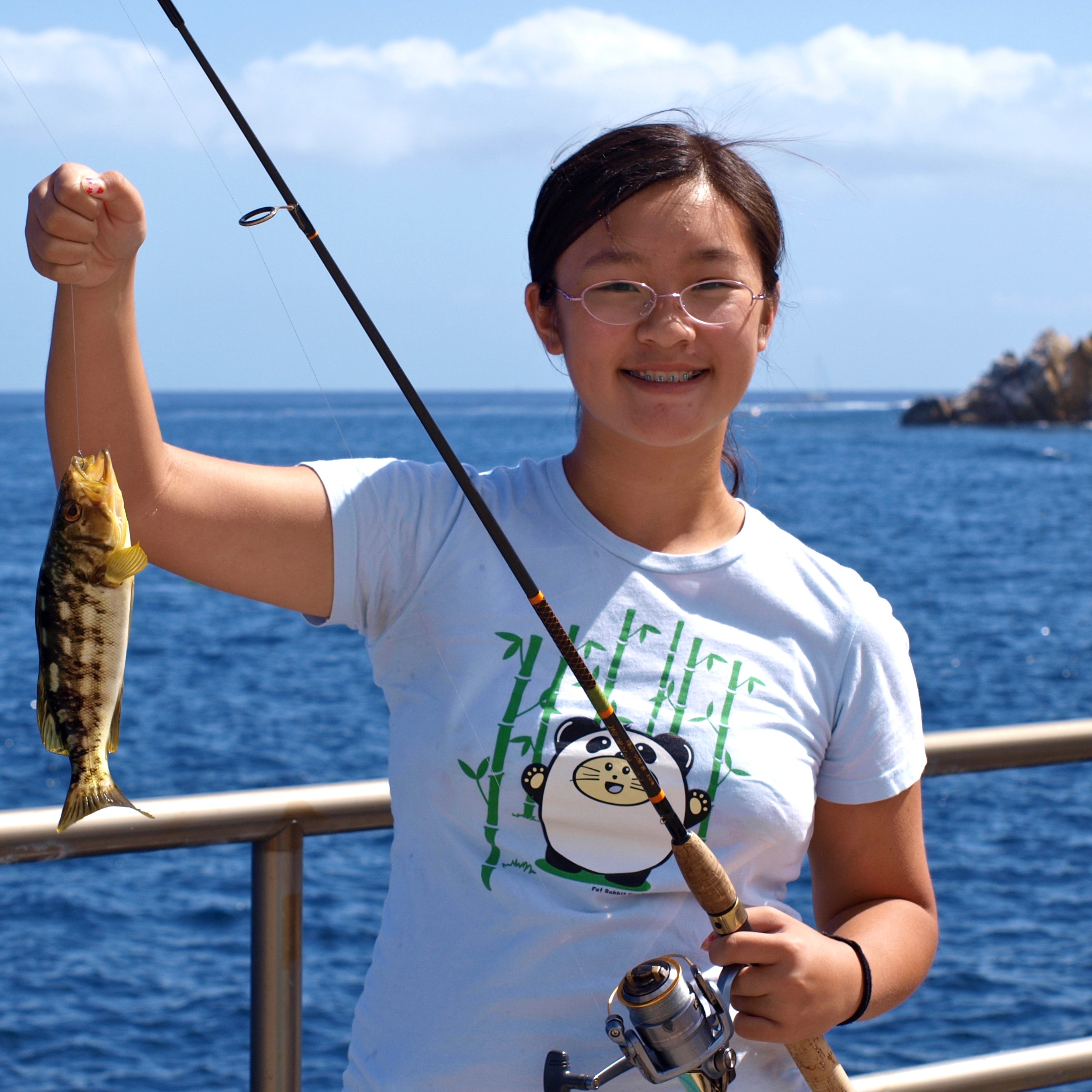
Amanda Liu (one of the nicest girls I have ever met) and a small kelp bass
If I am seeking out mid-water species, fish such as opaleye, halfmoon and blacksmith (and sometimes bass), I generally will drop the rig down 5-10 feet under the surface. If I can see the fish I will try to drift the bait into their area. At other times I try to drop the bait next to kelp fronds since the fish often hang just under the fronds and will dart out to get the bait.
You can usually tell fairly easily where the schools of fish are hanging out and it often varies depending upon light/shadow conditions (afternoon sees the Mole in shadow) and tidal conditions (are the fronds drifting toward or away from the Mole?).
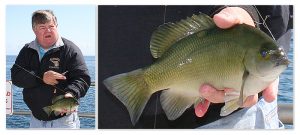
Your truly with an opaleye
As for technique, I keep the rod in my hand at all times so that I can strike quickly if there is a bite and keep the fish headed in toward me. Give the fish a chance to get to the kelp and you might lose them. I want to be able to feel every nibble or if the line is tangling in kelp or among the rocks. Although it is bait fishing, it’s not a cast and wait type of fishing and I probably cast and retrieve as much as if I was using an artificial lure.
Usually if you are using the right bait you will feel a bite almost as soon as you reach your desired depth and then it’s a matter of hooking the fish or losing your bait (and this is where experience can come into play). If you are not feeling bites after having experienced initial bites it probably means you no longer have bait. If in doubt, pull in your line. An empty hook rarely catches fish.
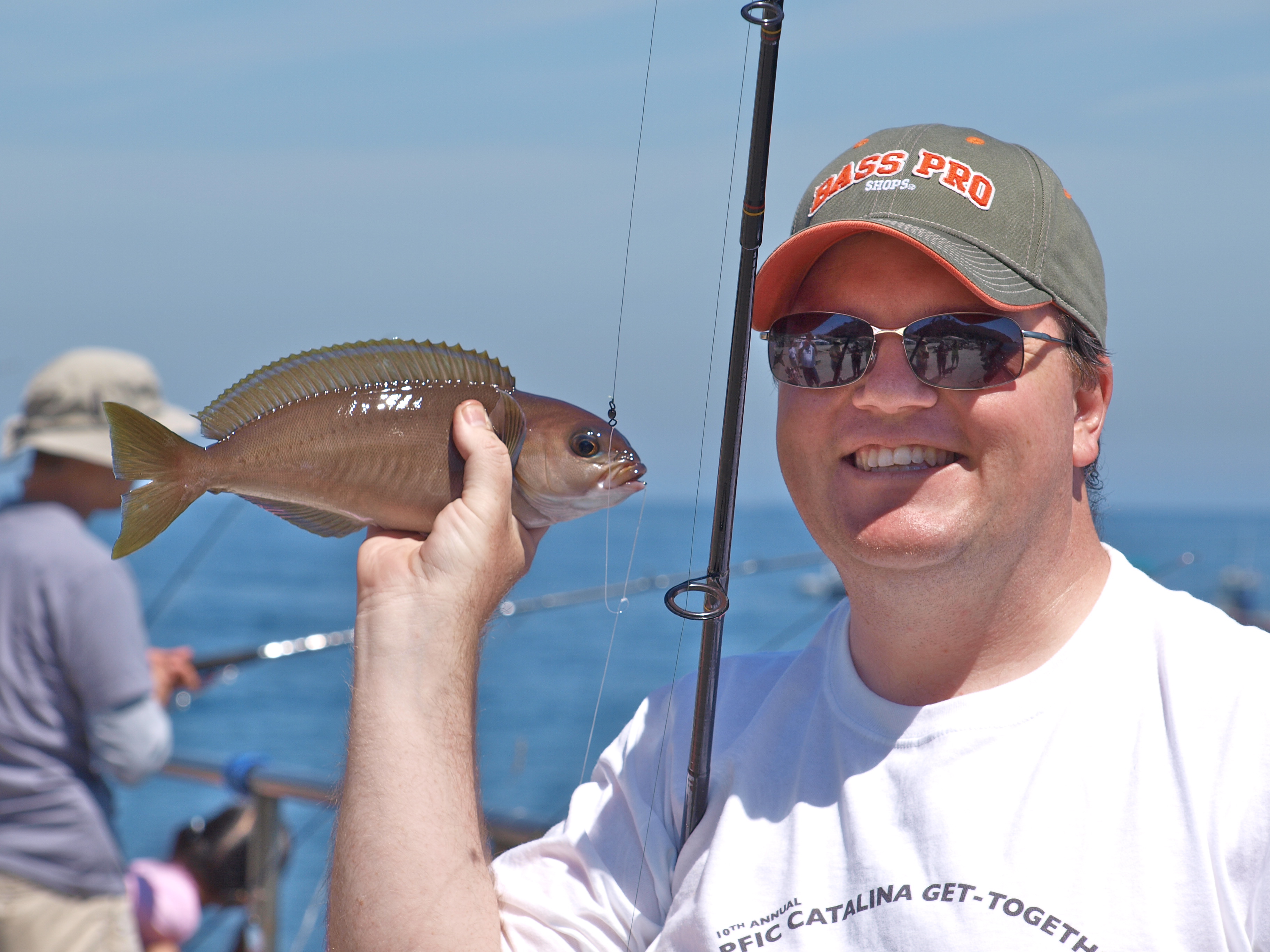
A small ocean whitefish caught by Baitfish (Adam Cassidy)
The high/low is the rig on which I catch the majority of fish. However, the light line can mean the loss of a larger fish and the inevitable clash between line and kelp can be in the kelp’s favor. Also, always have extra hooks and sinkers because you cannot fish the rocky (or kelp) structure without losing some gear (although the amount will depend to some degree on tidal conditions and if the surge is pushing your rig into/under the rocks).
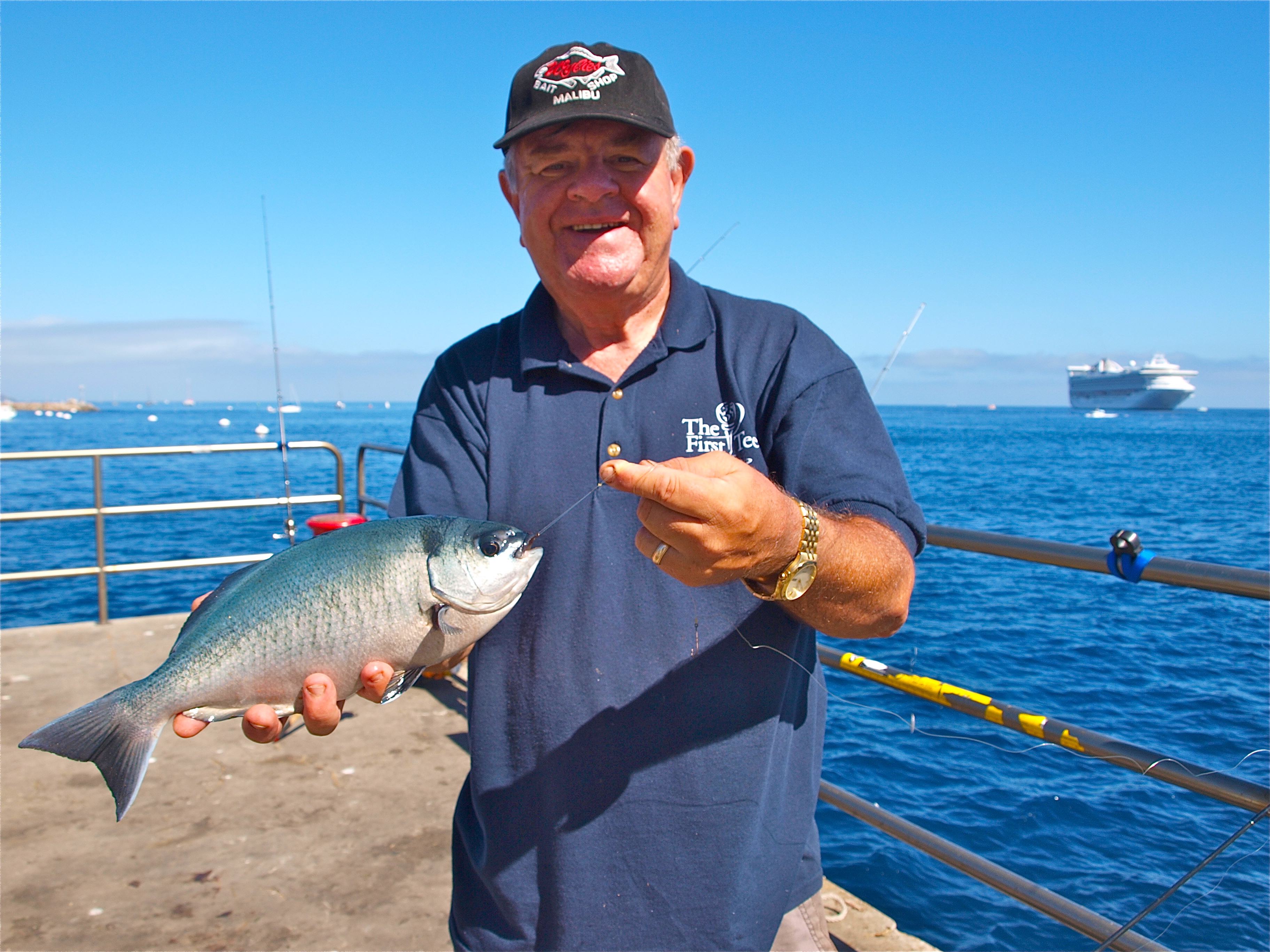
Halfmoon fight very well for their size and are a favorite fish — KJ and a halfmoon
- Heavy High/Low —Sometimes you want to concentrate on the bigger fish and/or test the deeper waters past the kelp. For both I recommend a heavier line, 10-30 pound test, bigger hooks, no. 2 to 2/0, and heavier 2-3 oz. torpedo sinkers. I will use larger bait but generally the same type of baits as the lighter rigs with the exception of the worms.
Generally I will drop straight to the bottom since most of the larger sheephead and bass are down toward the bottom (as are moray eel). Typically, since I am using two rods, the heavier rod is in more of a cast-and-wait mode. Do make sure you have your rod attached to the railing; it’s no fun when a big fish pulls your outfit over the railing. If using a baitcasting reel set the drag at a very low pull mark and be sure to set your clicker. If using a spinning reel, a Baitrunner or Baitfeeder-type reel is advantageous since it safely lets out line when there’s a strike. If you don’t have such a reel set the drag at a very low mark.
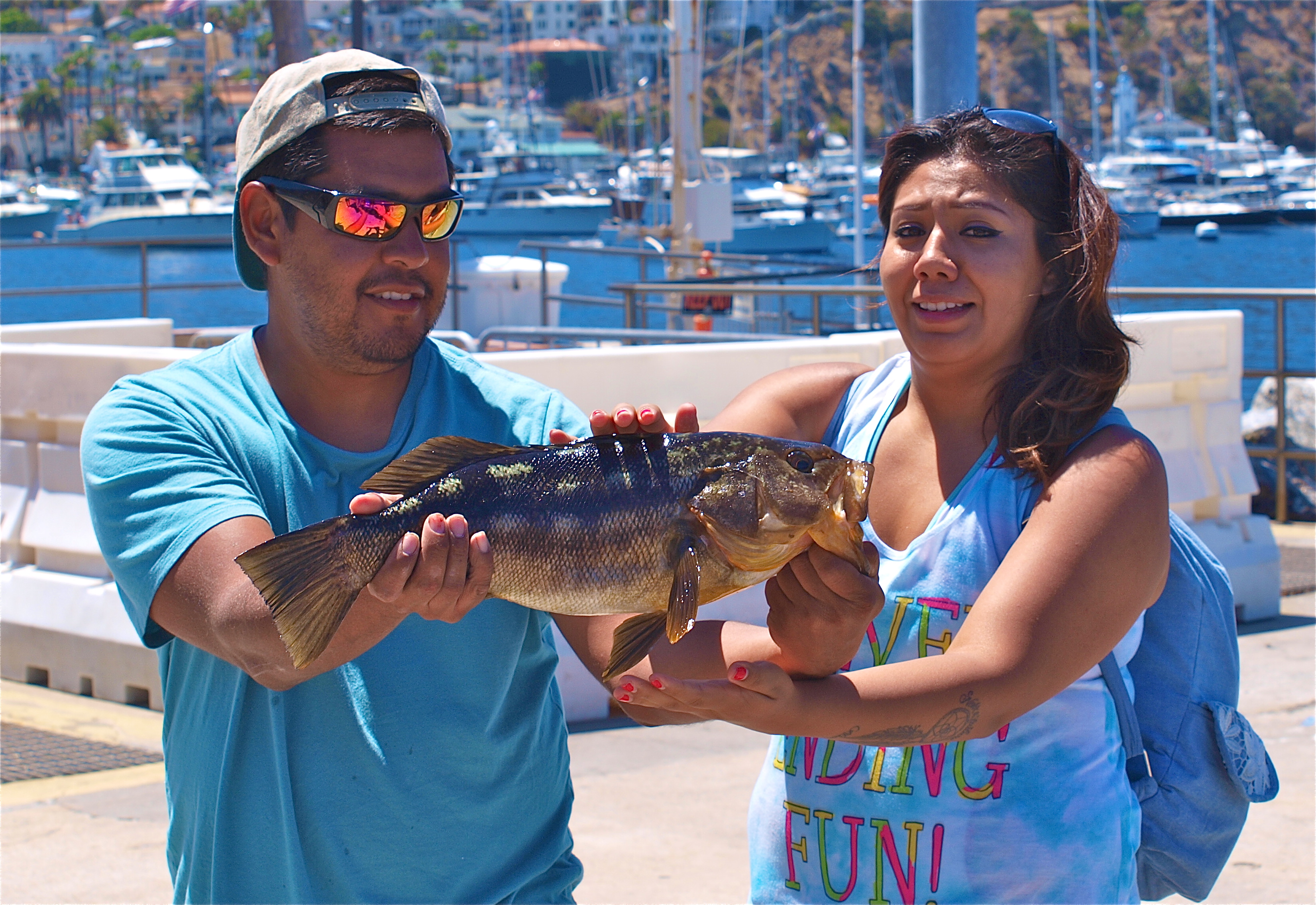
She doesn’t seem too interested in the calico (kelp) bass
Garibaldi are one of the favorite fish at Avalon and are usually the first fish spotted by visitors to the island (since you usually can see a few next to the ramp as you’re coming off a ferry).. They are illegal to target or keep but it can be hard to keep them off your hook when your fishing for other species such as opaleye and halfmoon.
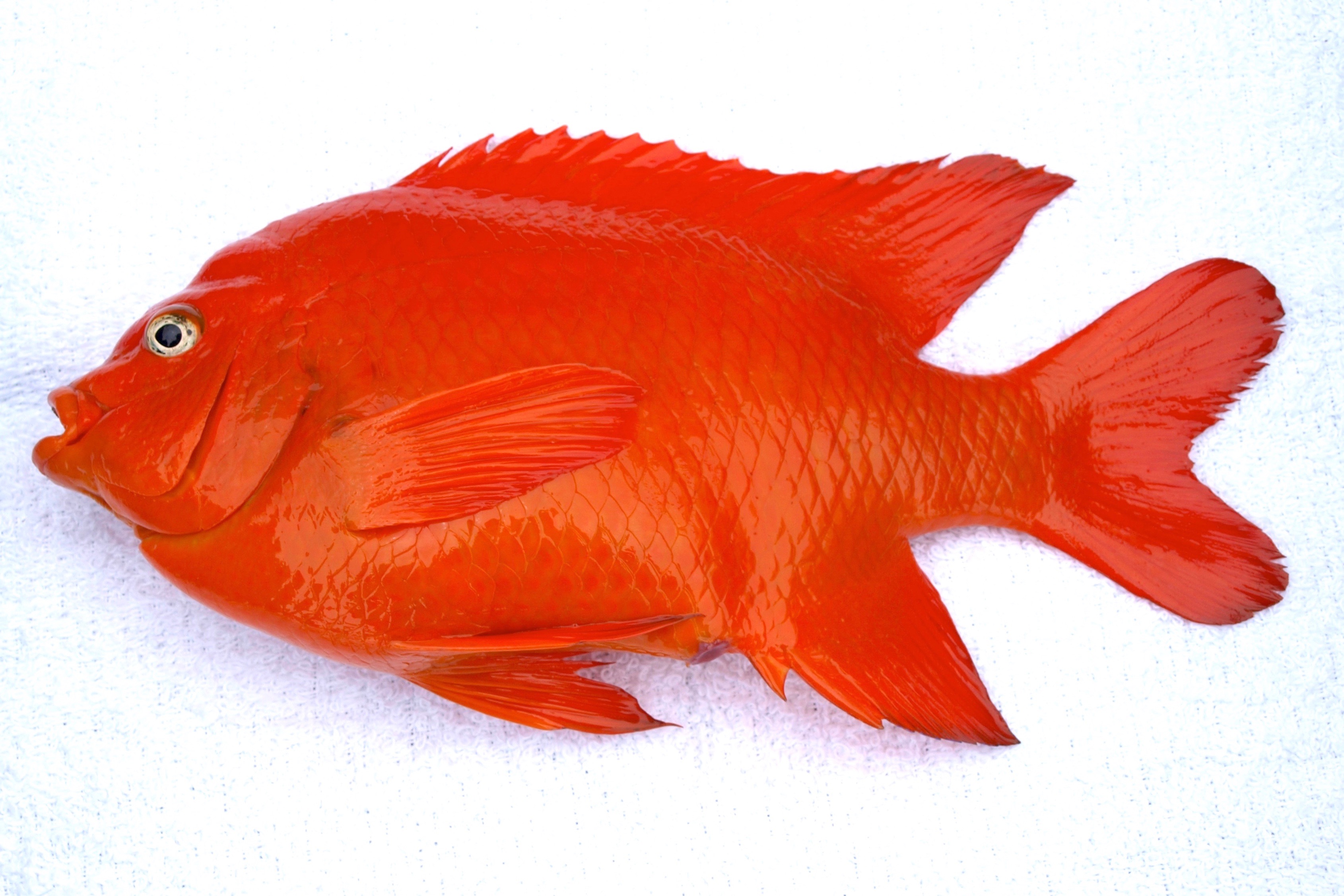
Adult garibaldi are a bright orange
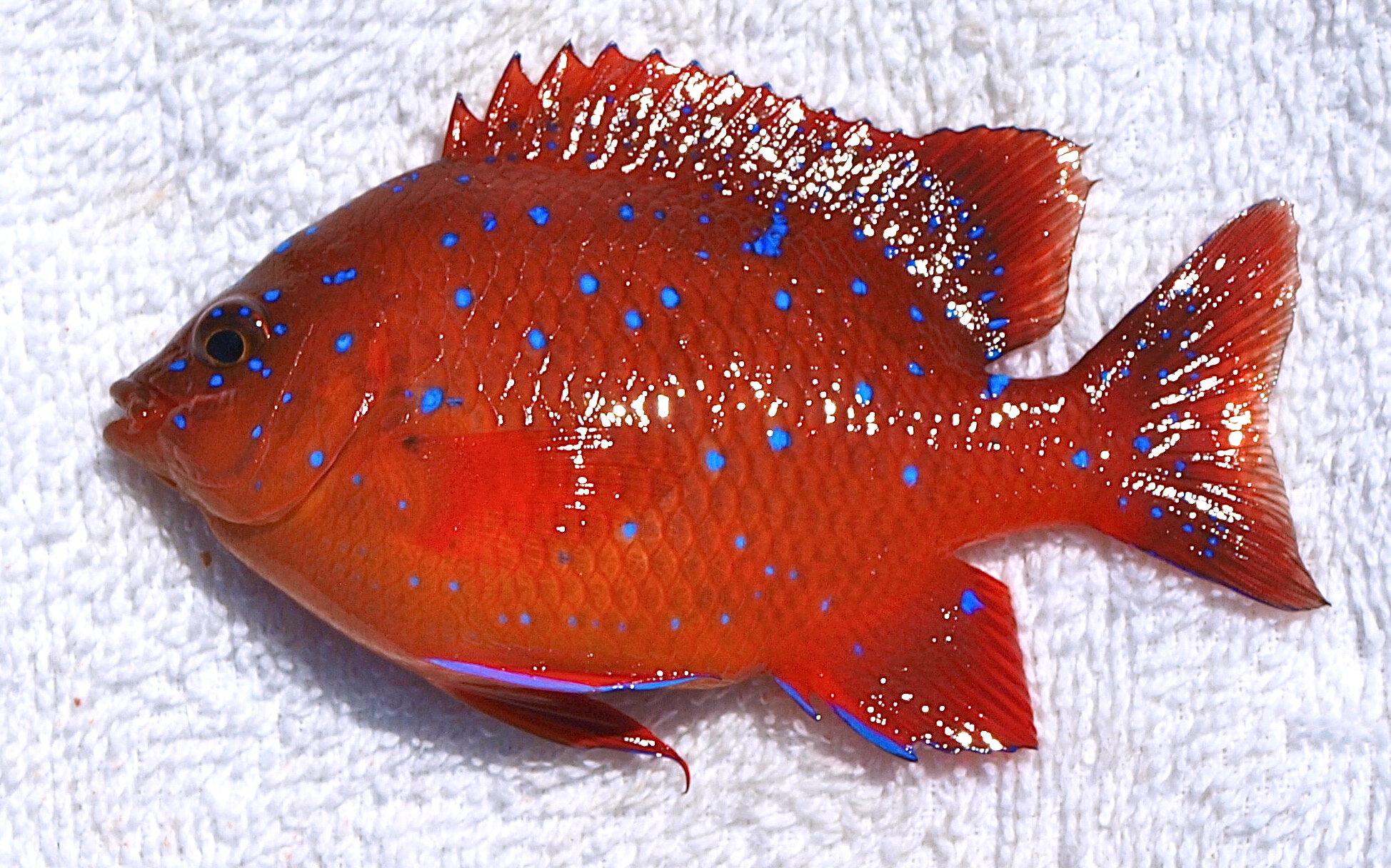
Juvenile garibaldi have bright blue spots
A slight variation is used if you want to make a long cast out past the kelp. Daring the Gods by such a cast guarantees your line will have to go through the kelp during your retrieve and it means, as often as not, that you will get snagged. It also means you may want to modify your rig. One change is to only use one hook (so it’s no longer a high/low). It means that if you hook a fish you only have to worry about the fish and the sinker getting through the kelp, you do not have to worry about the second hook grabbing some kelp. Another addition is to use braid as your line since it may cut through the kelp. Many anglers use braid with a fluorocarbon leader; hopefully the braid will cut a path through the kelp for your fish. One final technique is to have a lighter breakaway leader line attached to the sinker. If the sinker snags the kelp, the lighter line can break without you losing your fish. Nevertheless there are no guarantees.
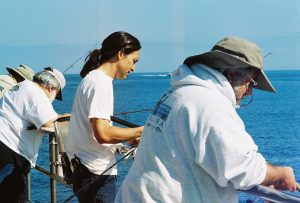
Anglers at the railing — PFIC regulars Graybeard, Jimbojack and Gordo
- Bait —Best baits are bloodworms, lugworms, pile worms, ghost shrimp, market shrimp, peas, mussels, squid, anchovies and mackerel. Moss is specialized bait for opaleye.
Worms are one of the favorite baits and will often yield non-stop strikes when using small hooks. However, small fish, especially senorita and rock wrasse, will often strip the hooks in a matter of seconds so be ready to strike. You will have to bring worms with you from the mainland, and they are somewhat expensive, but remember you only need to use a piece of worm large enough to cover your hook. A box of lugworms or a dozen bloodworms should last you most of a day.
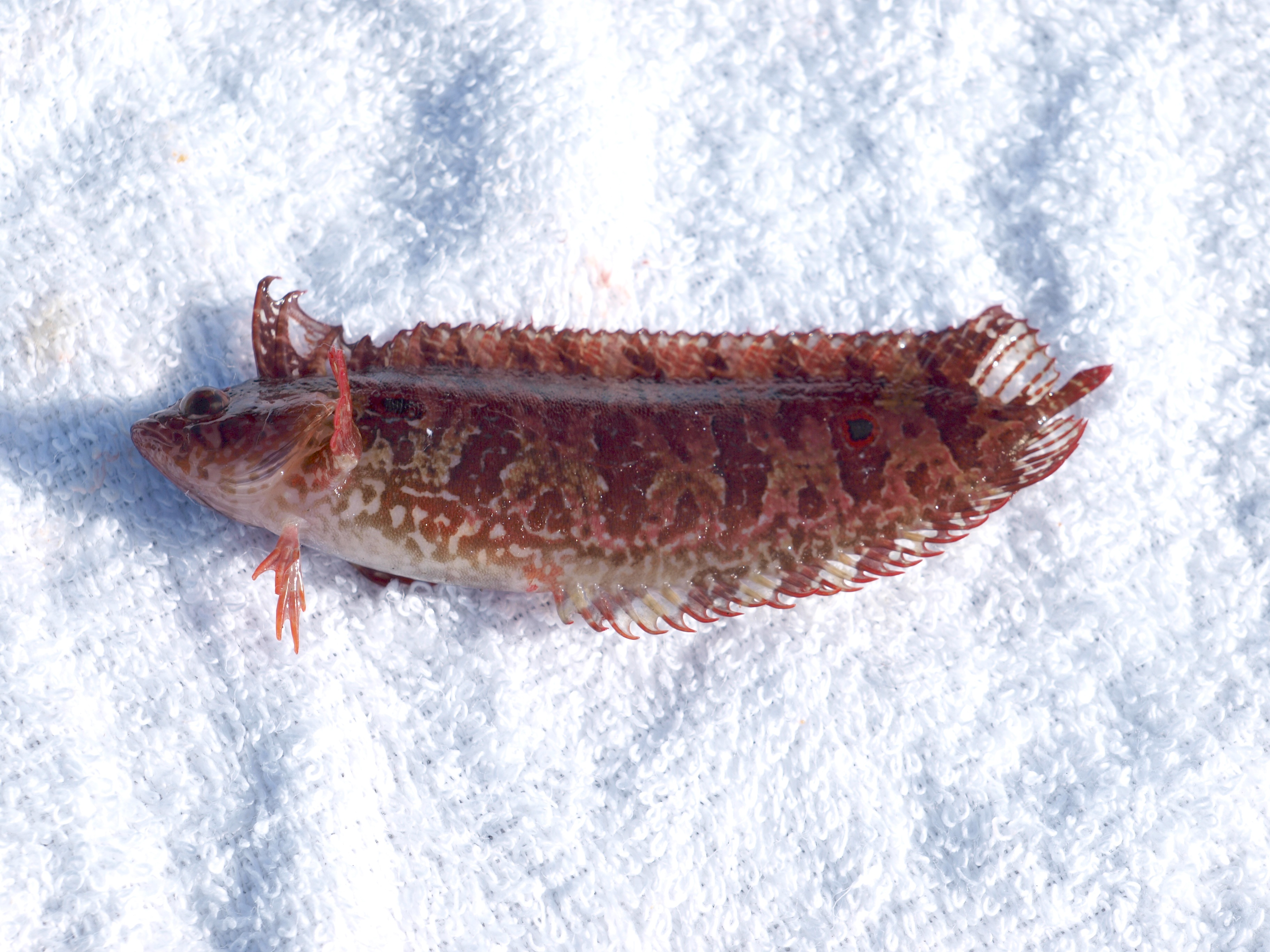
Spotted kelpfish
As for the ghost shrimp, break them into a couple of pieces and use a size 6 or 4 Kahle-type hook. Switch to a larger size Kahle hook if you want to use them whole. Ghost shrimp are excellent bait for many species, including sheephead and opaleye, but they also can be readily torn up by some of the fish. Considering the cost, and that you’ll have to bring them from the mainland, they are a somewhat luxury bait. There was a time when bait shops in the LA carried live red shrimp and they were excellent bait. But, I haven’t seen them in any shops for years.
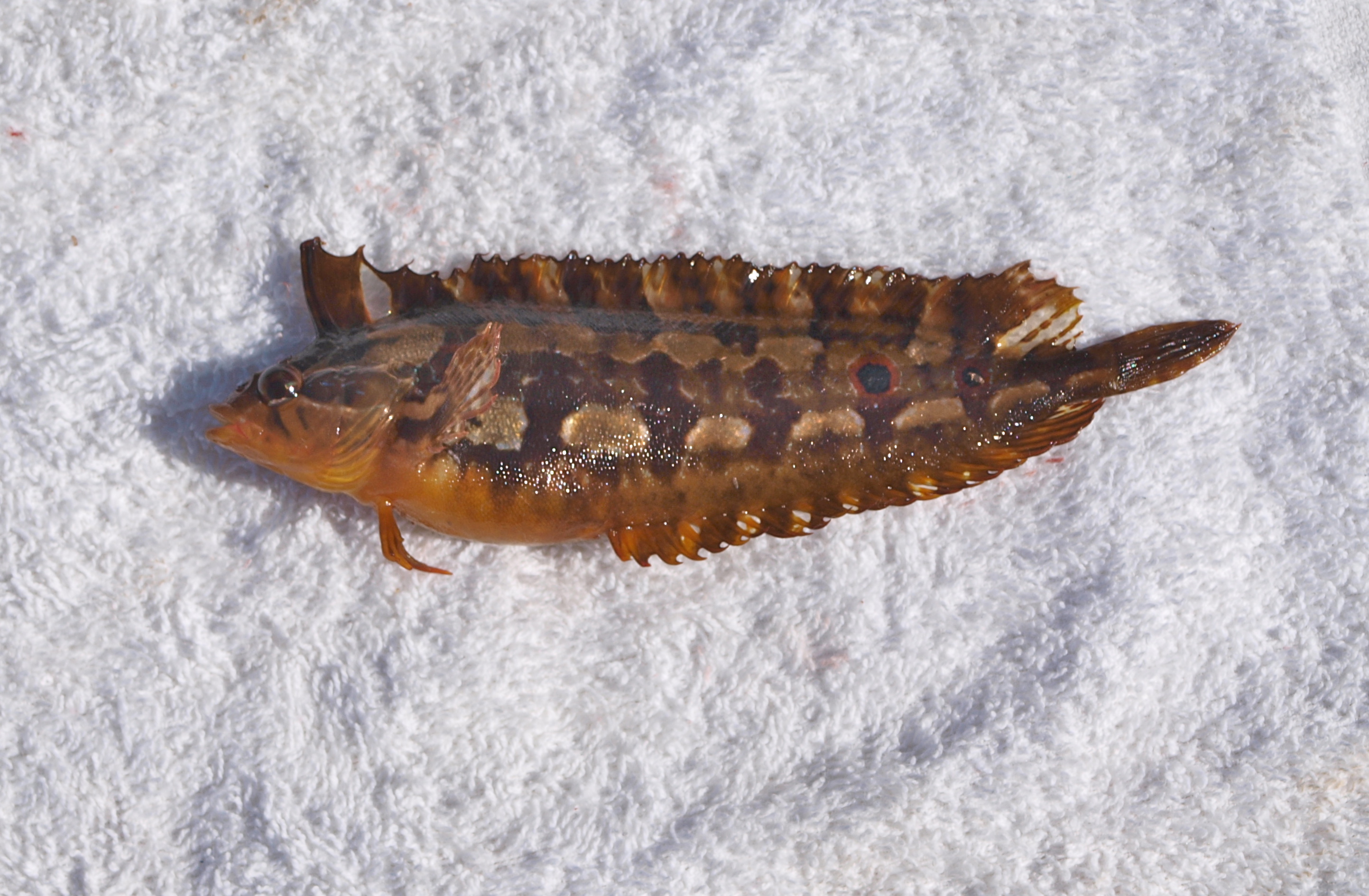
Crevice kelpfish
Frozen market shrimp are one of the main baits used at the Mole in part because they are available in Avalon. They can be good bait for a number of species but don’t use a whole shrimp unless you’re seeking the biggest fish. Cut a piece of shrimp to match the size of your hook. It will work fine and help the expensive shrimp last a lot longer.
Frozen peas (not canned peas) are the surprise bait used by locals and knowledgeable pier rats. Their popularity is due to opaleye, which seem to have adopted peas as a favorite food. However, peas are also used as chum at the Mole and readily gobbled up by most species. Over time the fish have grown fond of the peas and they are now a successful bait for many other species—halfmoon, blacksmith, perch, senorita, rock wrasse, and, surprisingly, even bass and mackerel. Occasionally a sheephead or even an ocean whitefish will be caught using the peas. Peas are available at markets in Avalon. If using peas keep them in a cooler; you do not want the peas to be frozen but you do want them to stay fresh and not dry out.
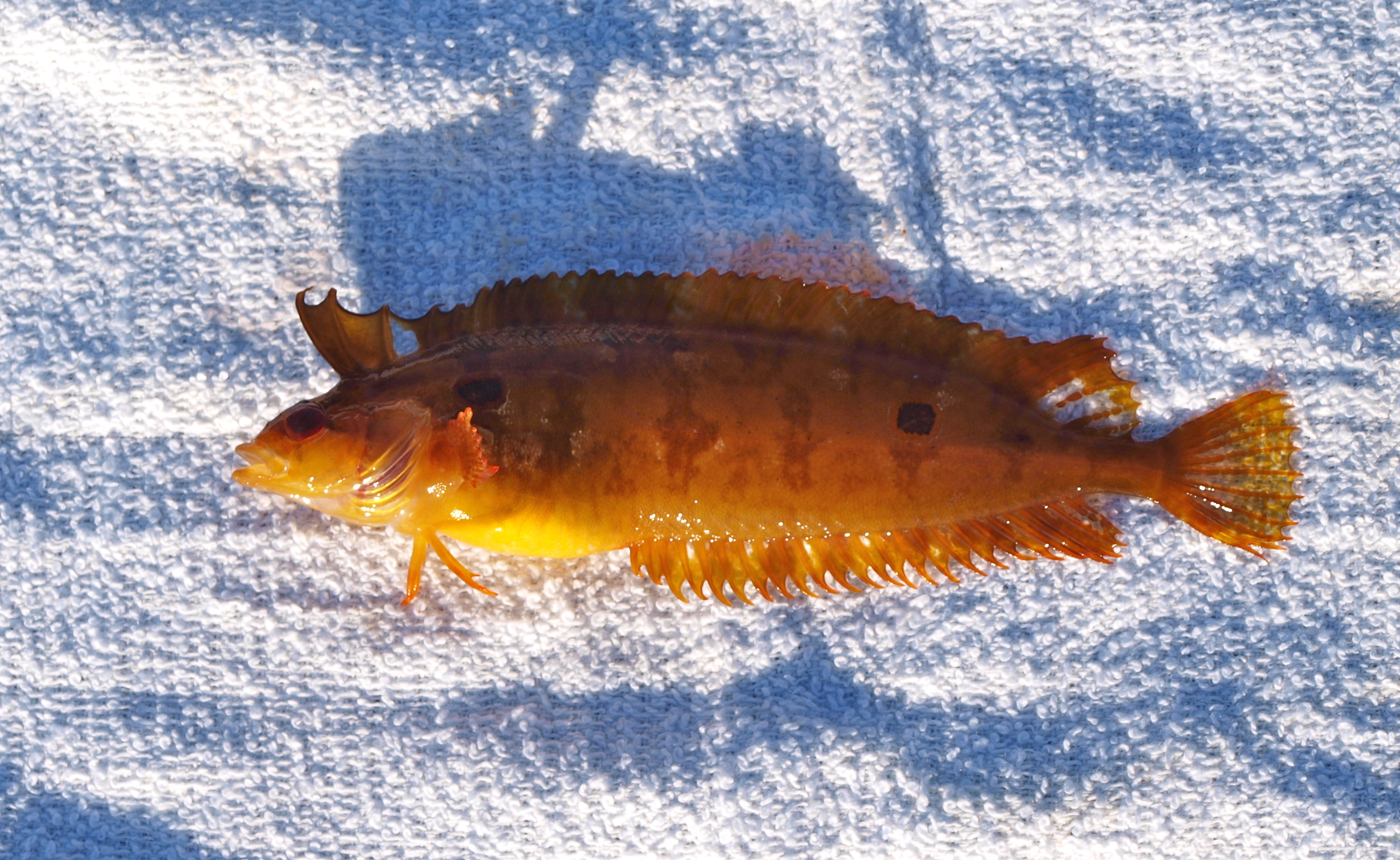
Striped kelpfish
Frozen or live mussels can be brought from the mainland. They are effective on the same species as the worms but the tough muscle of the mussels will stay on a hook and last longer than a worm. Use a small piece of the muscle, just large enough to cover the hook leaving the barb free to hook the fish. As for the soft flesh, you can either tie it to the hook with thread (which will not last long with Avalon’s fish) or put it in a cloth sack or a piece of nylon. If simply put on a hook the mussel will be gone in seconds.
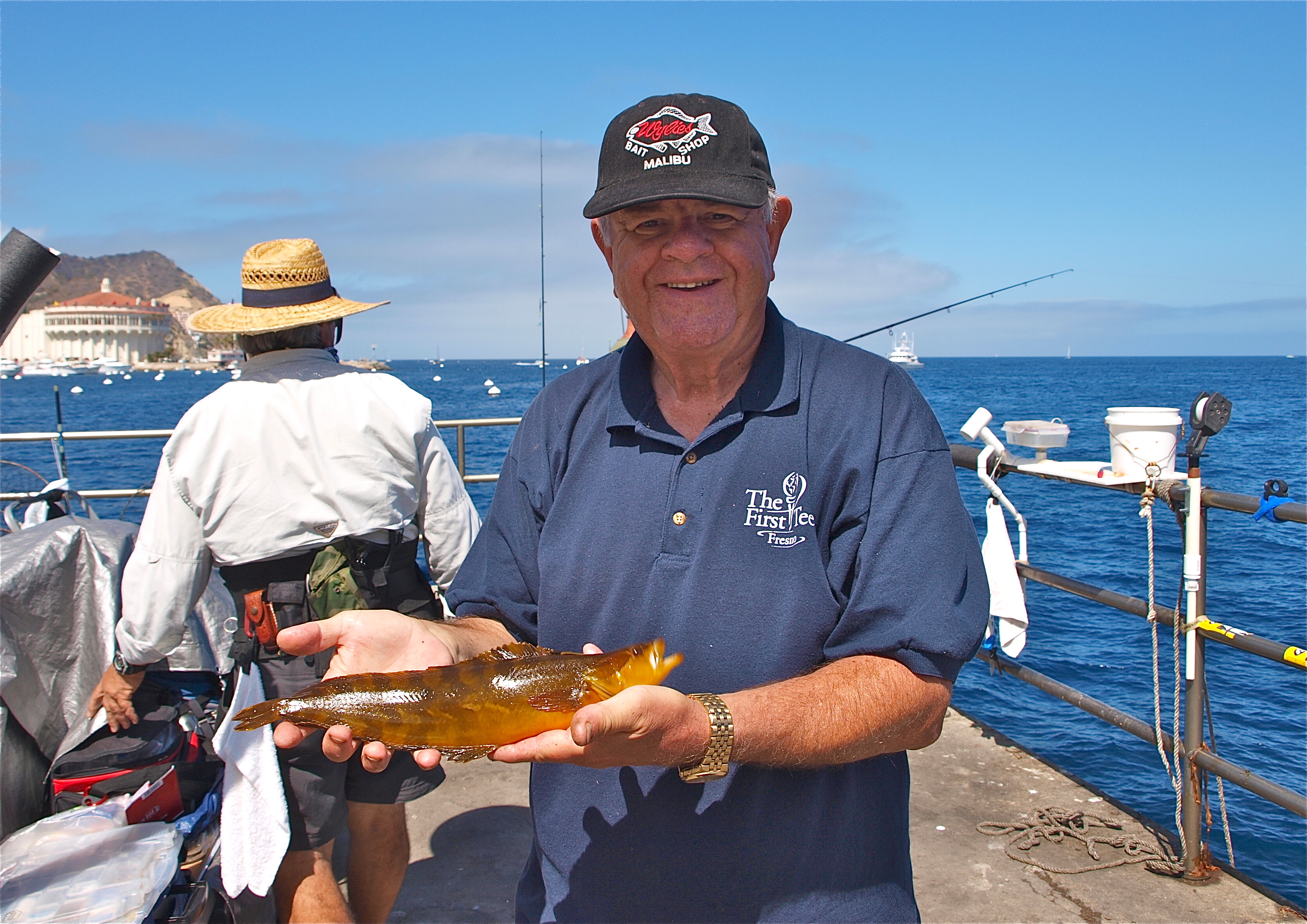
KJ, a not so giant giant kelpfish, and a crowded Mole
Frozen squid is generally available in Avalon. The result is heavy usage by anglers but tests over the years at the Mole show it to be inferior bait for most of the species. Strips of squid will catch bass, sculpin (scorpionfish), and some sheephead during the day but is most successful at night when it will yield up bass, rockfish, scorpionfish, sharays and moray eels. The squid will also work as bait when the pelagic species are around, especially Pacific mackerel and jack mackerel; both can be taken on strips of squid. The advantage to squid is that it is tough and can withstand the attacks of the small fish. It will also stay on your hook if you decide on a long cast (unlike some baits). Hopefully it will stay on the hook until a large fish decides to grab it.
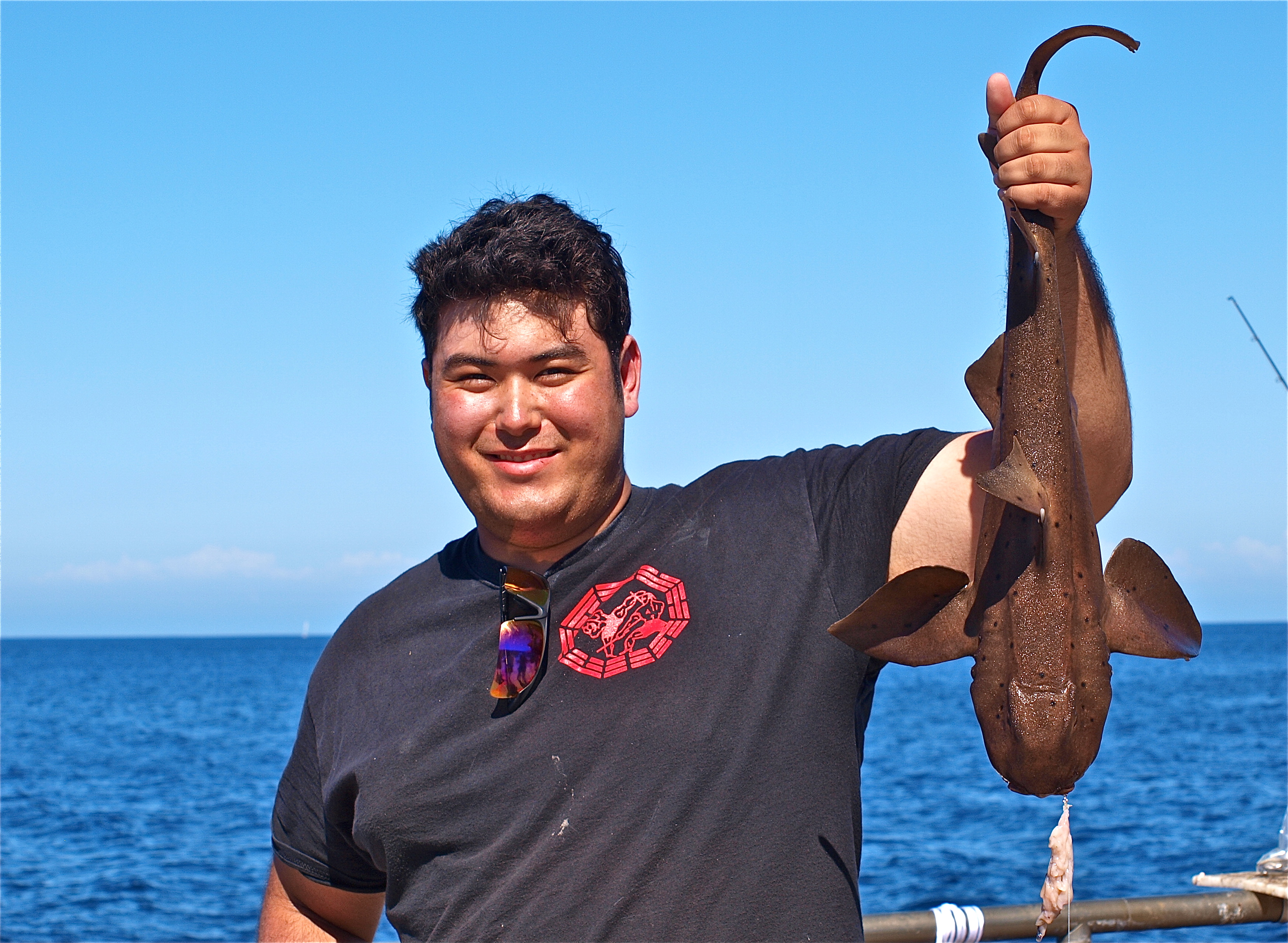
Horn shark caught by Kyle Pease on squid
Once in a blue moon you may be able to snag some live squid at night (or even buy some from a squid boat). If you’re lucky enough to get some, and can keep them alive, they are the primo bait for white seabass and yellowtail that may be hanging around the Mole.
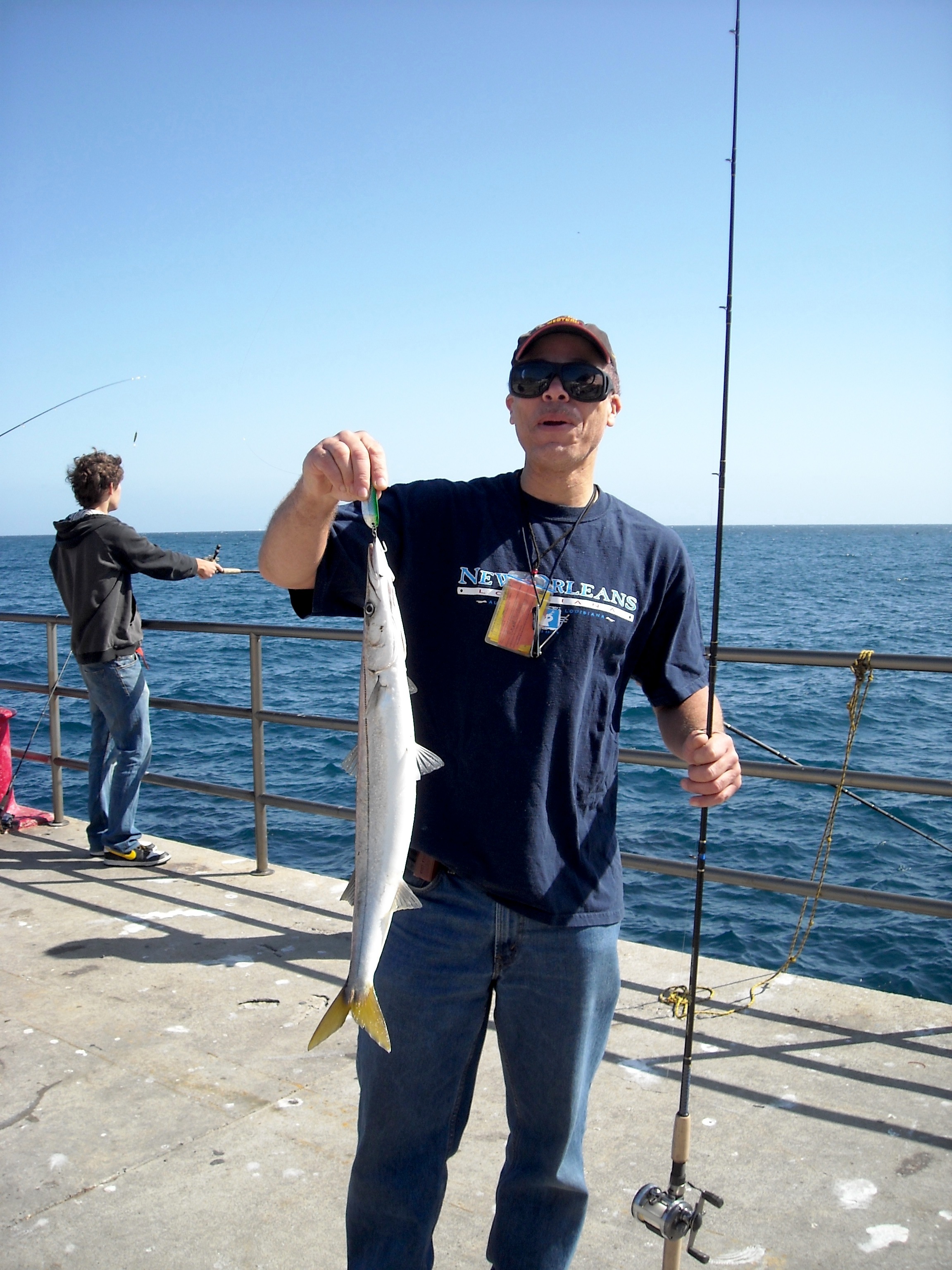
Redfish (Robert Gardner) and a barracuda
Anchovies make good bait for the kelp bass and can also yield a few rockfish and moray eel. The problem is that most whole anchovies or pieces of anchovy will be shredded within minutes (or seconds) by the smaller fish. Anchovies are simply too soft (although salted anchovies will last a little longer). They are best used at night when several of the Mole species—senorita, rock wrasse, and sheephead in particular, go to sleep. Anchovies are another bait generally available at the island’s bait shops.
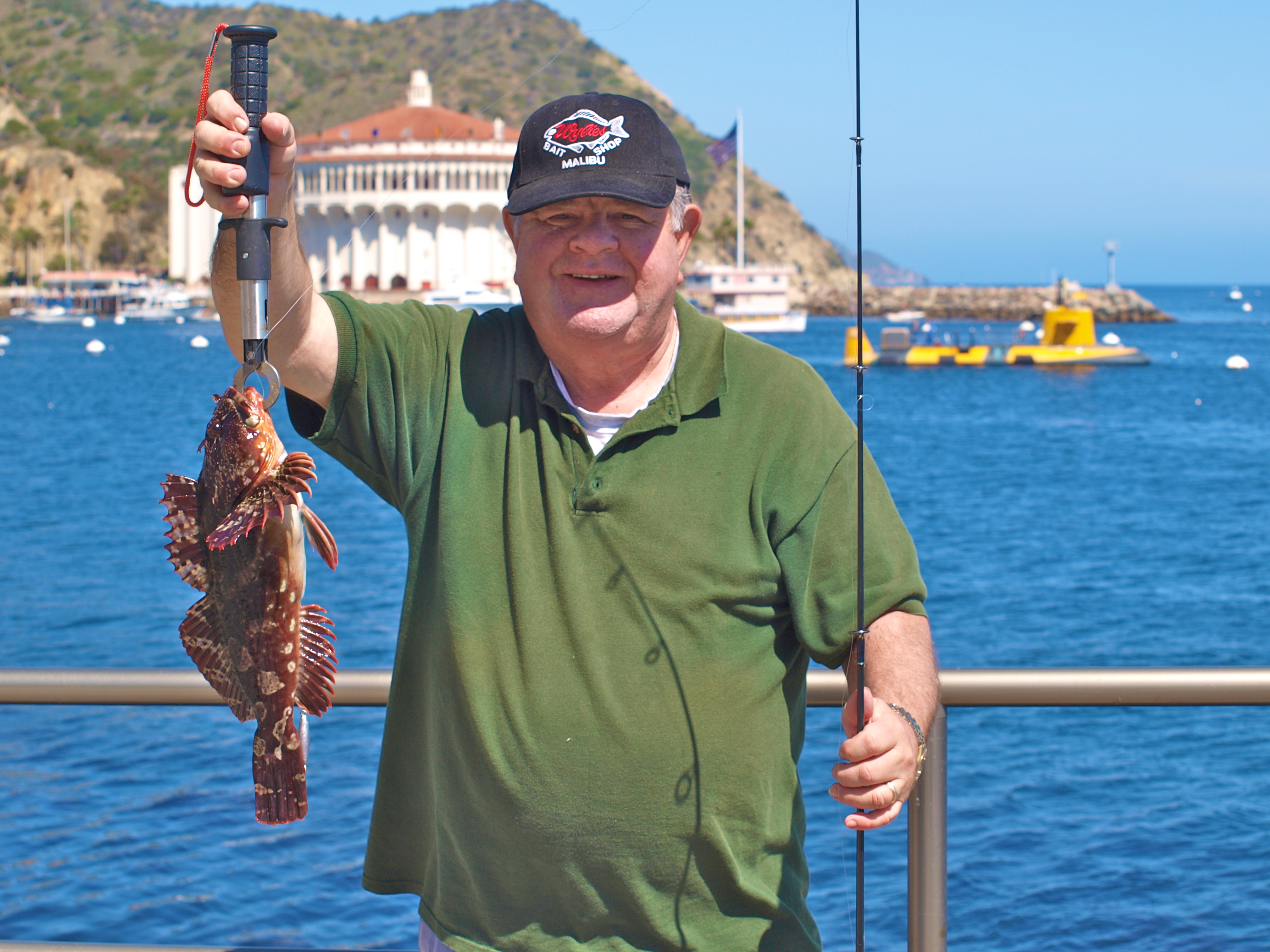
KJ and a cabezon
Mackerel is an alternative to anchovies. It is tougher and can often survive the onslaught from the smaller species, at least for a period of time, and since it’s an oily fish also is a good attractant for several species including bass, other mackerel (if they are around), rockfish, and sharks. Mackerel is sometimes available at Island bait shops.
Moss is another bait you will have to bring from the mainland. A few shops in the LA area carry moss; most do not. You can get your own off of jetty rocks or from underneath slips and docks in harbors.
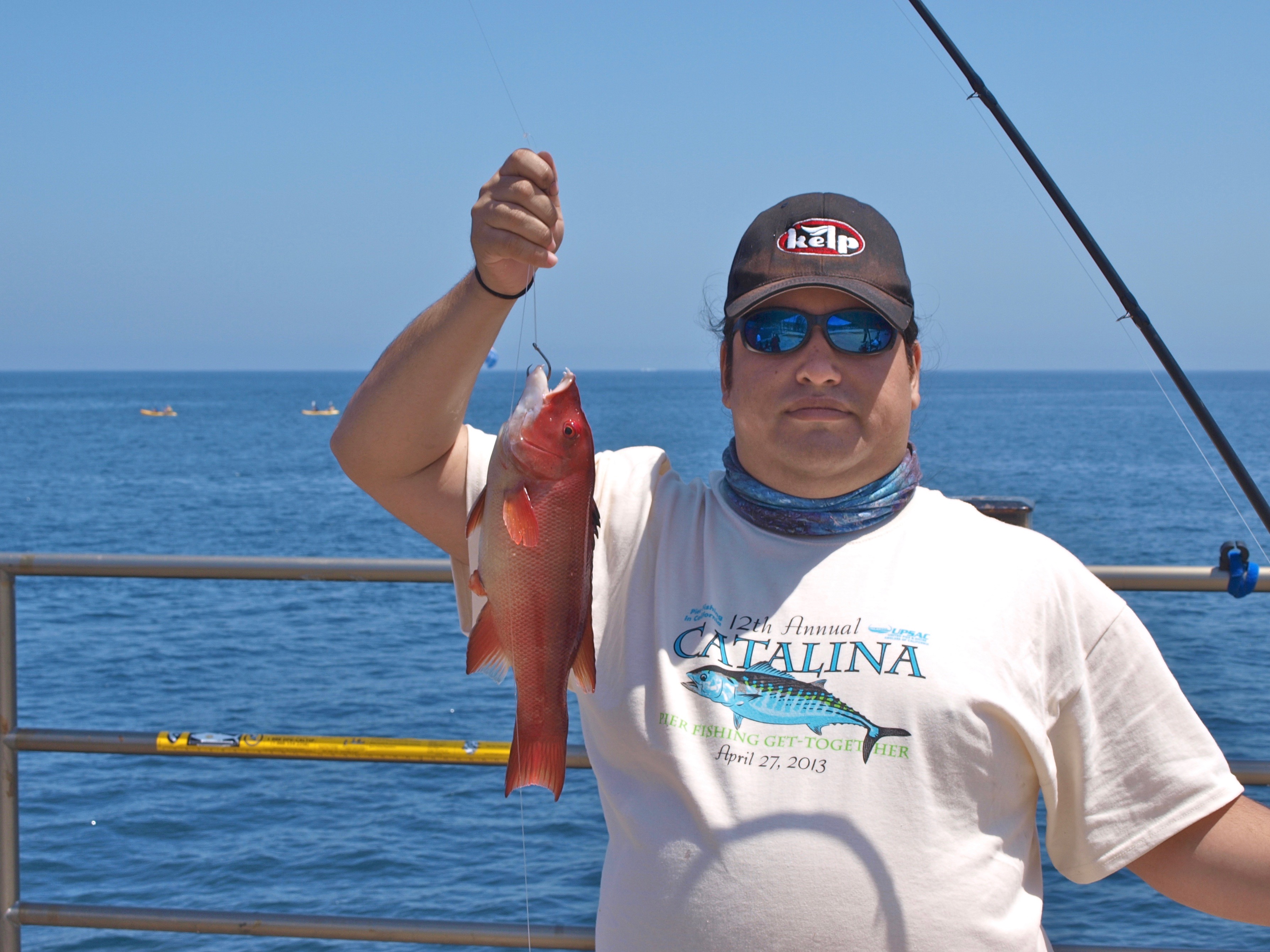
Sheephead caught by PFIC member Redkorn
A word of caution! Remember that there is no live bait and limited frozen bait (usually anchovies, squid, and shrimp) on the island. Pier rats generally stock up on bait at a mainland bait shop, stick it in a cooler, and bring it with them. Tourists though who get the urge to “go fishin’” can find bait. The main bait and tackle shop is High Tide Traders on Crescent Street (not too far from the entrance of the Green Pleasure Pier) while some bait is seasonally available (generally during the summer) at Joe’s Rent-A-Boat (mid-way on the Green Pleasure Pier) and Rosie’s (at the end of the pier) on the weekends. Frozen shrimp is also usually available at the Vons Market in Avalon.
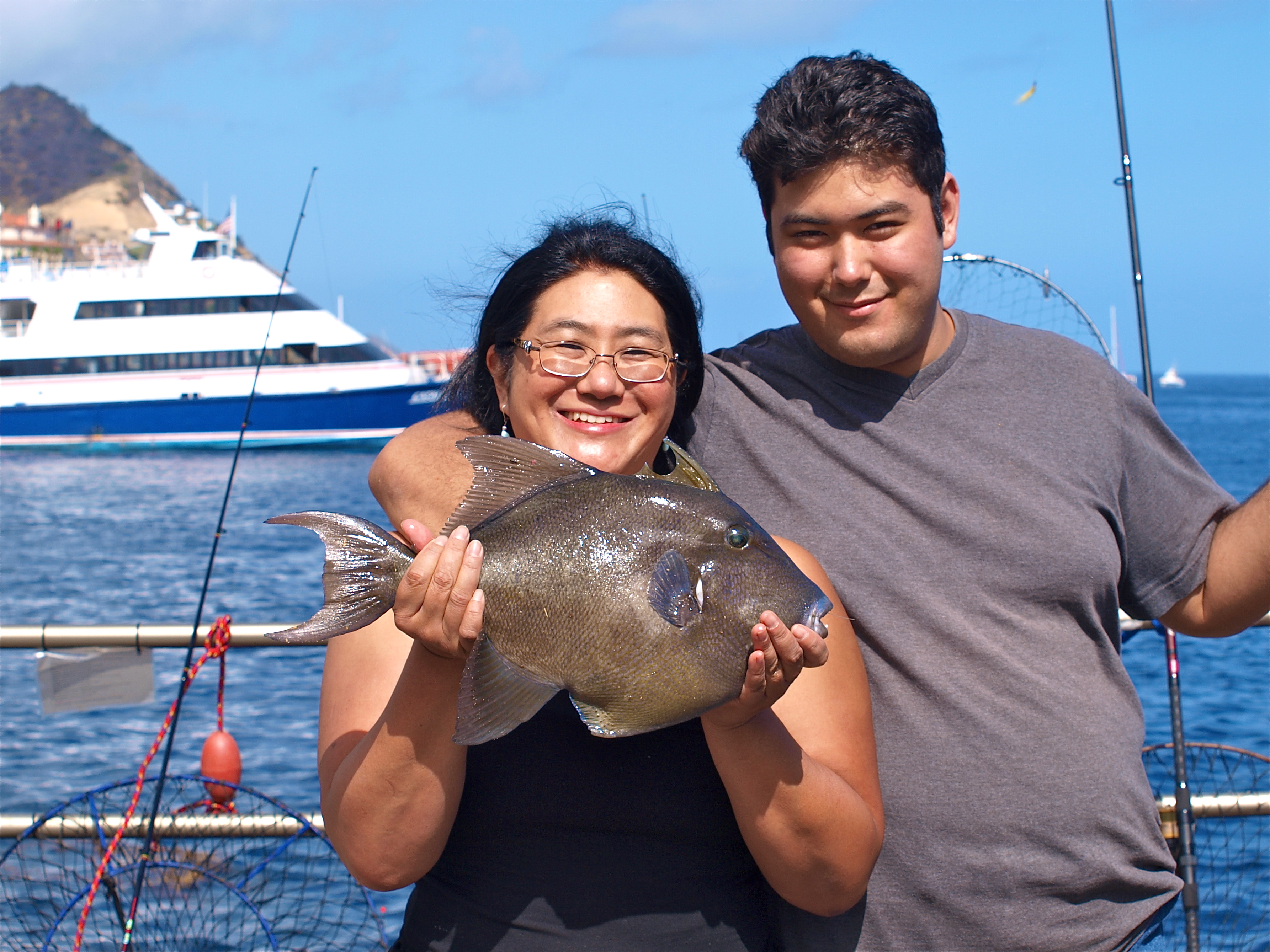
Rita, her son Kyle, and her triggerfish
- Opaleye Rigs —One of the most sought after species at the Mole is opaleye. The hard fighting and attractive fish are found pretty much year round in schools numbering from a few individuals to dozens to what at times seems like hundreds of fish. People will peer down into the water, spot the greenish-colored fish with the two distinctive white spots on their back and be somewhat amazed by their size. True they are somewhat enlarged when viewed from above but they also tend to be larger than the fish they commonly swim with, the halfmoon and blacksmith. The opaleye will average one to three pounds with an occasional lunker-size fish reaching the 4-5 pound weight.
Opaleye live largely on algae—and various organisms that live on algae. I catch opaleye every trip to the Mole and catch them on my high/low rigs. Typically I fish bait mid-depth using ghost shrimp, worms, peas or pieces of market shrimp. Given the non-vegetarian mix of baits I probably do not catch as many opaleye as if I were concentrating on them. However, given my search for variety I’m usually satisfied to catch the occasional opaleye.
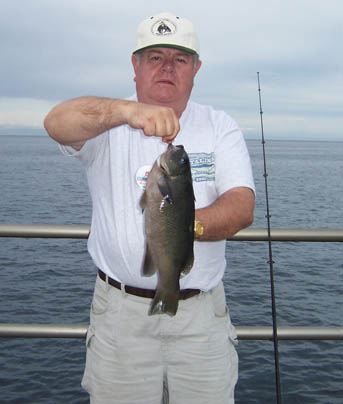
KJ and an opaleye
Then there are the “pros.” The opaleye attract a steady group of anglers who come over from the mainland just to fish for opaleye. Sometimes they come in a group and stay a few days but many times it’s just a few people and they come in the morning and leave at night. It seems a pricey proposition considering the cost of the ferry but it shows the high esteem that opaleye engender among anglers.
These opaleye “pros” bring special tackle, bait, and the know-how to fill a cooler with fish (sometimes following the law and sometimes breaking it). And though I typically stick to my high/low rigging, I’m watching—and learning—from these pros.
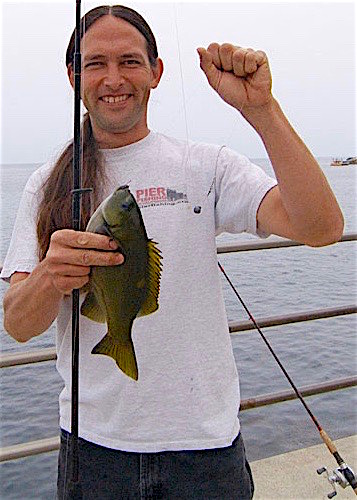
Jimbojack and an oplaeye
Their rigging isn’t complicated, a long, sensitive rod that records every bite, light 6-10 pound test line (usually fluorocarbon), a slip float, and a long, 4-6 foot-leader. The leader terminates in a single small hook. Some people do not use sinkers but most add a small split-shot or rubber core (aka rubber grip) sinker about 6-12 inches above the hook.
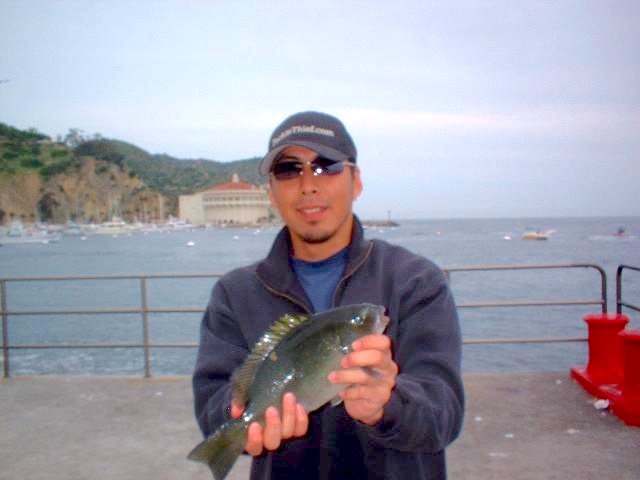
Tom and an opaleye
People disagree on the hooks, some suggest a Baitholder hook no bigger than size 8 down to a size 10 or even 12. Some anglers prefer circle hooks and one angler mentioned his use of Eagle Claw circle hooks model 1702 in sizes 14 and 16 (but there are many brands). Brand and type isn’t as important as size. Considering that you usually are only using a single pea it’s easy to see that a small hook is mandatory.
One final thought regards chumming. Most of the guys who concentrate on opaleye chum whether simply throwing out a handful of peas or using a more complex concoction. Some people suggest using peas mixed with moist bread crumbs, some people suggest cooked oatmeal mixed with cat food, some have even suggested (in jest?) using cooked Kraft macaroni and cheese; use your imaginatio
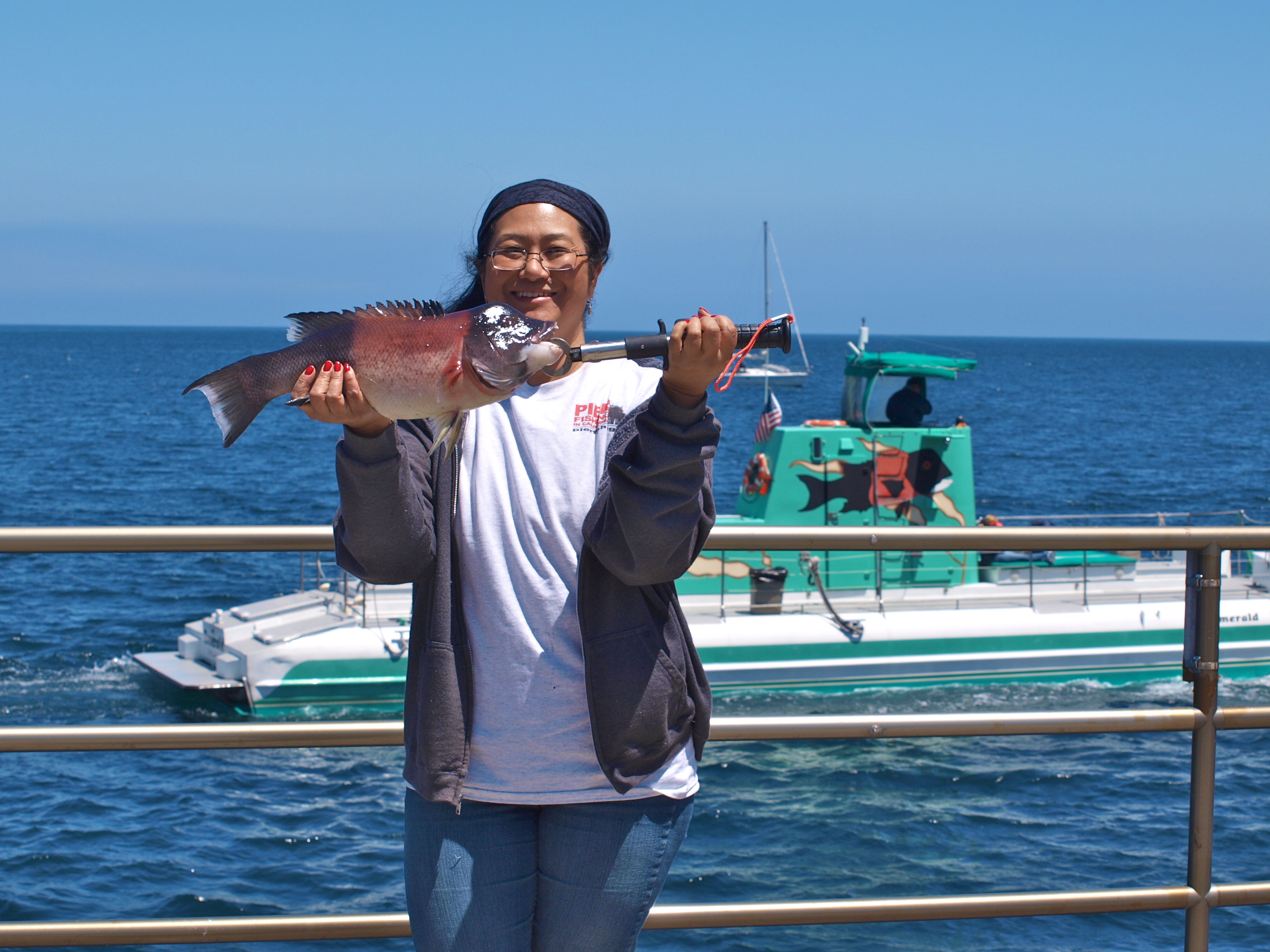
Rita and a sheephead
- Bonito Rigs —Bonito are one of the hardest fighting fish in the sea and about the closest to big game fishing that many pier anglers will see, especially if large 6-8 pound fish start to show up (most are 1-4 pounds). Luckily, the Mole is one of the best places in SoCal to catch bonito when they decide to invade local waters (essentially during, and for a few years after, warm-water El Niñoconditions). My records have shown bonito at the Mole on about 2/3 of my visits.
Catching bonito is fun but does require a different rig. For years the most common bonito rig was a “splasher rig” that would create a disturbance in the water attracting the bonito. The “splasher” varied over the years. When I first started fishing in the ‘60s people used a large circular piece of cork with a torpedo sinker in the middle or they used a wooden dowel. Later the “Cast-a-Bubble” was developed and it became the rig of choice. People who didn’t have such a rig concocted their own rigs using rubber balls and even golf balls. They all seemed to work to some degree. The “splasher” was attached to the line and a 3-4 foot leader was attached from the splasher to a “bonito feather” trailing behind. Feather colors varied with chartreuse and white, green and white, or blue and white seeming most popular.
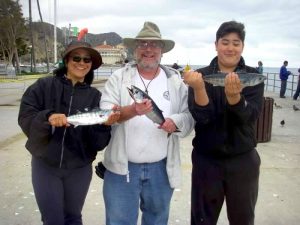
A trio of bonito caught by a trio of PFIC regulars—Rita, Ross, and Kyle
Recent years though have seen more and more anglers using a variety of spoons—Megabaits, Kastmasters, Krocodiles, and even buzz bombs—and all work to various degrees.
A couple of posts to the Pier Fishing In California message board from PFIC “experts” deserve a special read.
The first is by a dear friend, James Liu, aka gyozadude or simply GDude. James attended every PFIC/UPSAC Get Together at Avalon from the initial event in 2002 to 2013 when he unfortunately passed. He didn’t care much for bait fishing but loved to catch bonito and became one of the experts. Given his brainpower (he had a couple of PHD’s in nuclear physics) he also enjoyed analyzing situations and offering solutions—including his thoughts on how to catch bonito:
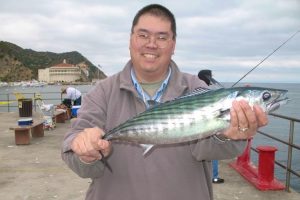
James Liu aka GDude aka Gyozadude with a bonito he caught at the Mole in 2009
Date: April 8, 2008
To: PFIC Message Board
From: gyozadude
Subject: Bonito fishing at the Cabrillo Mole, Avalon, Catalina Island
If you’re coming to Catalina and want to catch bonito, here are some tips:
Gear to bring: Get an 8–10 ft. spinning rod with a mod-fast action, and 12–20 lb. test line. Try to avoid a full surf rod as the butt section may be too long for good under-hand casting. I like to use braid as it seems to have less memory and casts farther.
Bring some metal spoons, in the 1–3 oz. range. Kroc spoons in chrome with a splash of color works. Also an in-line golf-ball with two small screw-in framing loops works if tied to a 5 ft. leader and streamer or Hoochie or glow grub. The golf ball is just a bit denser than water so it sinks slowly, and will create a splash if you retrieve it quickly. My favourite lure has to be a size 4 Buzzbomb. A popular lure up in B.C. for salmon, the Buzzbomb flutters when jerked and released and catches all sorts of fish. The Buzzbomb is about 1.75 oz. and casts far, plus sinks fairly quickly. Due to its pulsing hydrodynamics, however, the lure puts out a huge alert under water. So unlike the golf ball rig that generates the most flash just at the surface, the Buzzbomb draws out fish from deeper waters… Chrome or holographic finishes are ideal.
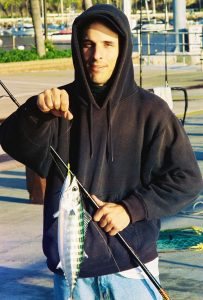
SteveO and a bonito at the Mole
Location: Best location I think for bonito is the Cabrillo Mole. You can often spot them at a distance offshore attacking schools of baitfish. The water dances wildly on the surface. But even when there is no surface activity, there are schooling bonito that may be sub-surface, around 6–10 ft. deep.
How far you need to cast varies. Sometimes they’re in close. More often, they’re out beyond 30–50 yds. As the Mole only allows for underhand casting, we get best results using an 8–10 ft. spinning rod held vertically downward. 10 ft. seems ideal for me. The extra length allows me to clear the structure and swing inboard and under the Mole in a pendulum motion, then quickly pull back on the butt section, which lifts the tip and shoots the lure out quite a ways.
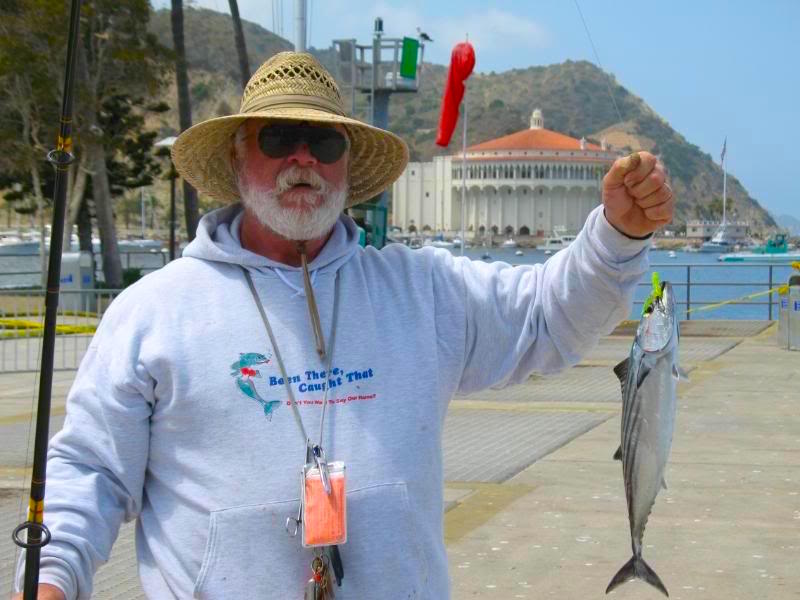
Santa (Mike Spence) and a bonito
Useful tips: Be careful during underhand casting so as not to smash rods against the concrete Mole understructure. This can chip ceramic guides. I recommend a Berkley or Abu made rod or custom rod that uses either the new flex ring memory metal titanium guides or Berkley SS304 type guides which have no ceramic ring inside but just a hardened TiCh or TiNitride coated metal ring.
The kelp grows thick in front of the Mole and bonito will tangle up in it. Try to keep lines tight and fish from diving into the kelp if possible. Braid can help in these cases if you hook up because the thin, tough line can cut somewhat through the foliage. Best tactic is to be quick and keep the fish’s head up and out of the water.
If the bonito seem to disappear and stop hitting, often, they’re still there. Just cast further, and let the lure sink to about 10 ft. and work your lure. Bonito are attracted to the surface often because of baitfish. But otherwise, in bright sunlight, they will stay deeper.
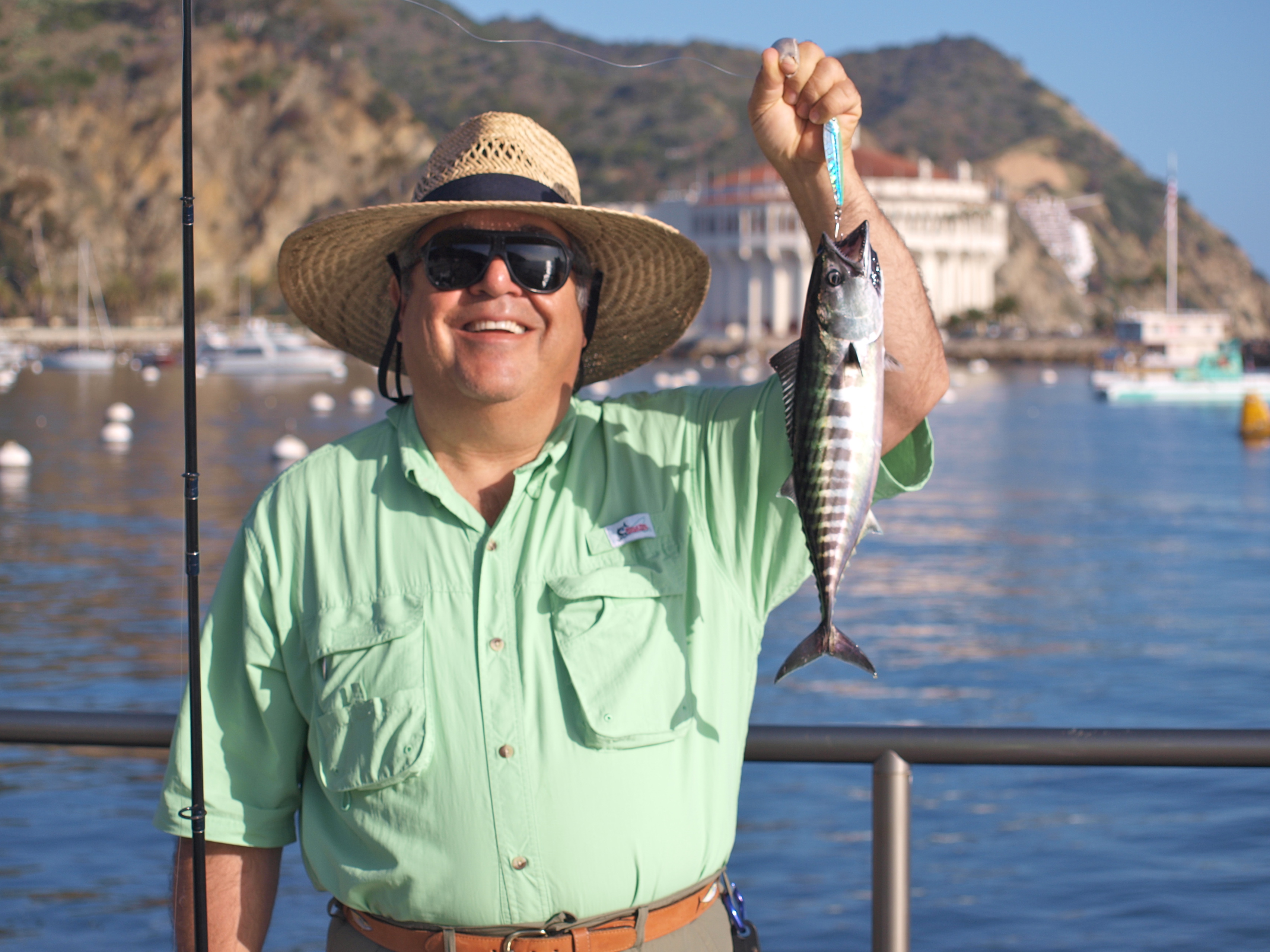
Bonito caught by Mahigeer (Hashem Nahid)
Vary the speed of the retrieve and depth to find where the fish are and then work that section for 10 minutes or until the hits stop and then move on. If the bonito are out there, they won’t waste time chasing food, and they are picky. If there are no hits, change positions and cast some more.
When a bonito hits, often, you won’t hook up. Crank up the slack quickly, and continue to retrieve. Bonito will give chase and often smack a lure multiple times until hooked.
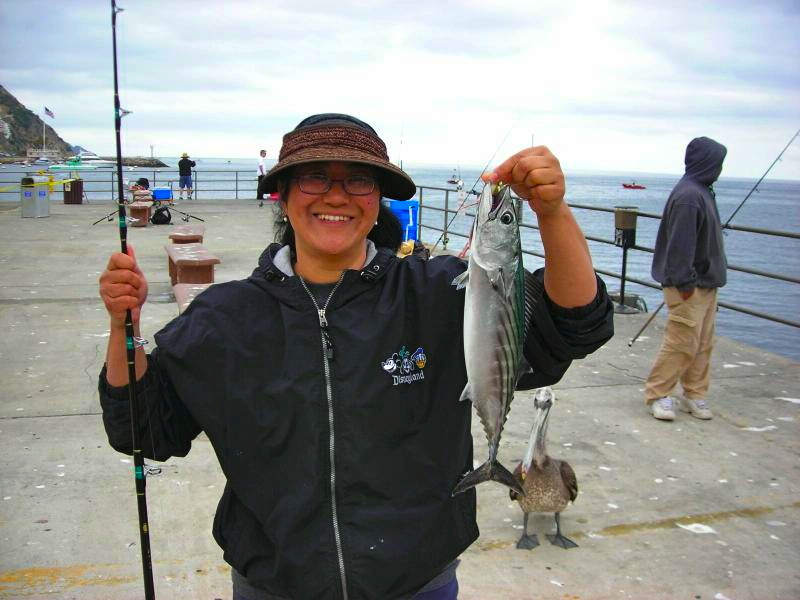
Rita, a bonito, and a pelican that wants Rita’s bonito
If you plan to have kids working rods and fighting bonito, you may want to go with 8 lb. line and a tether to the rod just in case the kids let go and fish wants to pull the rod into the water.
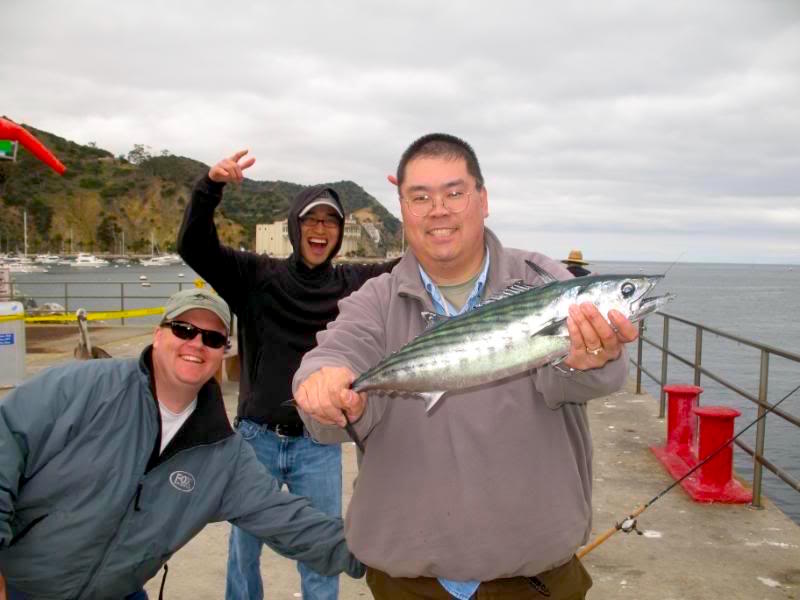
GDude (James Liu), a bonito, and PFIC members Baitfish (Adam) and kelpangler (Eugene)
The second post is by long time PFIC member Scott Geerds aka Scooterfish. Scott was one of the original members of PFIC dating back to the late 1990s and though he moved to Louisiana he managed to attend the PFIC/UPSAC Get Togethers from 2007 until 2010. He too was seeking out the bonito and fished for little else. He quickly gained respect as anexpert on bonito and posted the following:
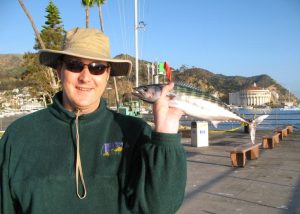
Scott Geerds (Scooterfish) with one of the smaller bonito he caught at the Mole in 2009
Date: April 24, 2008
To: PFIC Message Board
From: Scooterfish
Subject: Catalina bonito rigging
Some folks at Catalina were interested in details about the bonito rig I was using at Catalina, so here they are, starting with the terminal end…
Lure — ¼ oz. jig head dressed with a 4-inch Saltwater Assassin “Sea Shad” in the “Space Guppy” pattern (Chartreuse with salt + pepper flaked clear). Not the most durable plastic by a long shot (1 per landed fish), but very effective with great action. I like using a ¼ oz. head because it keeps the lure ~6” underwater even when retrieving “bonito fast.” Tail action of the Sea Shad is frantic, even at lower speeds and on the fall.

Leader — 5+ feet of 20-lb P-line CFX fluorocarbon leader. I’ve used this stuff for quite a few years in the 15-30-lb. test and have never had it fail me. Works well with my Uni knots.
Splasher — 3” Magnum (1-1/8 oz.) Flexcoat “Launcher” casting float. There are larger sizes of this float, but this size casts best for me with this rod. The larger sizes seem awkward and have too much wind resistance, and the lighter sizes are too light to get distance… *Distance casting was less important this year as the bonito were cruising primarily just outside the kelp, and inside the harbor. On Sunday I caught a few smaller sized bonito on long casts, but the rest of the week they were close in. Thursday afternoon they were cruising the Green Pleasure Pier and the harbor and technically could have been caught with a handline!
Launcher configuration
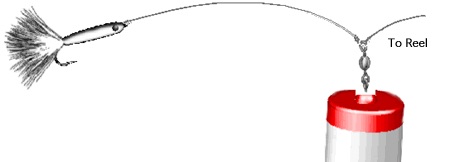
These are different than most floats in how they connect. Both mainline and leader are attached to the same point, giving the splasher erratic action.
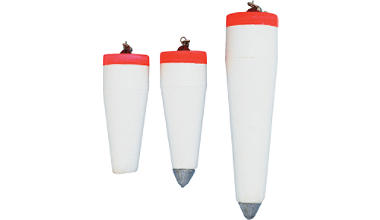
I use the one in the middle, 3″ Magnum, weighing 1 1/8oz.
Mainline — ~270 yds 20-lb PowerPro. Old reliable! Casts far, sensitive, strong. Brought a spare spool with 30-lb PP, but never needed it. FWIW I had zero break-offs this year from kelp, fish, or bad casts!
Rod — 11’ G-Loomis SUR1324s (Fast Action ½-3 oz. lure, 15-30-lb. line). Same rod as last year, and same rod I use primarily for Jack Crevalle and Redfish here in Louisiana. Light, strong and fast. Allows me to easily load up under the pier for a pretty effective underhand cast.
Reel — Shimano Sustain 4000fe. The drag on this reel got a pretty good workout this year, and did not disappoint. Spool lip is definitely smoother than the Stradic, although I did not notice any big difference in casting distance.
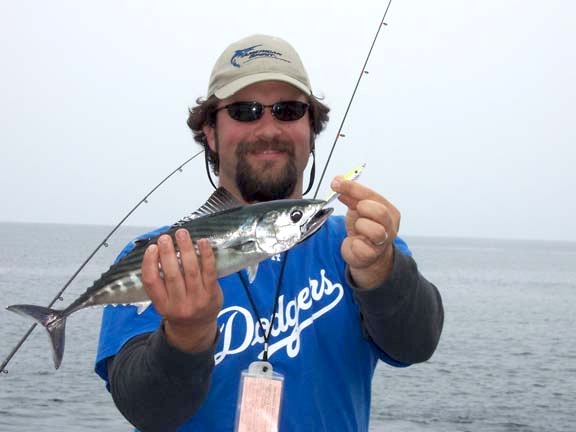
DompfaBen (Ben Acker) and a bonito
Date: May 1, 2010
To: PFIC Message Board
From: Scooterfish
Subject: Bonito fishing, rig and technique notes from Catalina 2010
This is a summary of my bonito fishing notes from Catalina this year. Hopefully this adds some more useful information to the PFIC archives for future visitors to the island, and those who are obsessed with targeting these awesome fish!
There were two environmental factors that I believe directly affected fishing at the Catalina event this year for bonito. It was generally more overcast, usually for the first half of the day, and windier with a light chop on the water (with the exception of Friday). Wednesday the weather was very windy, with a huge swell, which stirred up the water quite a bit and seemed to put off the bite for pelagics for about a day and a half. We were also faced with a situation where the anchovy that are usually present around the island (and usually available at the bait shops frozen) were reportedly nowhere to be found. Anchovy happen to be the primary food source for Sarda Chiliensis (Pacific Bonito), closely followed by squid…
Our usual routine at Catalina in years past has consisted of spotting “boils” (fish working on the surface), and repetitive casting to cover as much water as possible when the fish are not showing. Most of us utilized “splasher rigs.” A splasher rig is a top-water rig that utilizes a weighted float (cast-a-bubble, Launcher floats or drilled golf balls) with a leader of 4-8 feet (preferable good fluorocarbon). At the business end of the rig there are a variety of options that will work (and you should keep a good selection of these in your tackle box!). Lures for a splasher rig can be a simple as a couple of rubber bands tied to a bare hook, fancy flies and feathers, and even small plastics. I’m sure a squid strip would do well on this rig also, although I’ve never tried it.
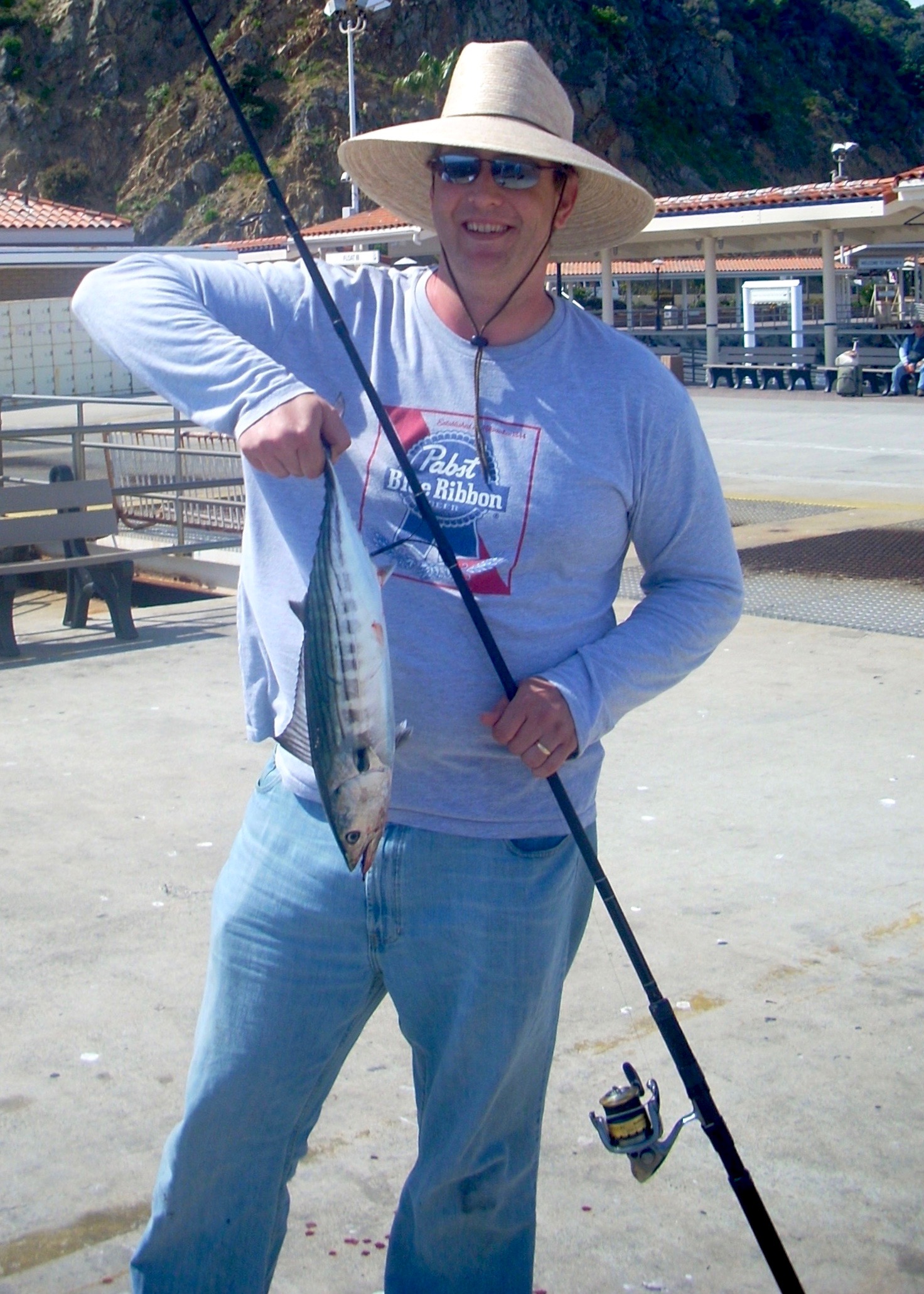
Scooterfish (Scott Geerds) and a bonito
The most popular (and effective in my opinion) color for bonito lures is chartreuse, while white, olive green and other colors can be effective at times also. All of these colors will benefit greatly when combined with a good bit of silver flash or chrome.
About a month or so prior to the event Hashem had visited Catalina and posted about the technique that was most effective at the time. This rig is very similar to the splasher rig, but the float is replaced with a 1-3 oz. torpedo sinker. I stocked up on 1-3 oz. torpedo sinkers and found a Bass Pro Shop version that includes an integrated inline swivel on both ends marketed as a trolling sinker. These proved to be indispensable at Catalina this year. This rig casts farther than a splasher, can cover the entire water column, and is much easier to work in the water. It also is more flexible as far as lure options. I was able to use this rig with flies, plastics with jigheads, and even a 3 1/2” X-rap with the middle hook removed (caught a good bonito on that one!).
When casting a rig with a longer leader, braided line and a weight in between, I find it necessary to slightly modify my casting style and leader. If you attempt to cast this rig overhand, it will foul almost every time because the weight will shoot straight out, the leader will straighten behind it (parallel to the braid mainline) and then spin around the mainline causing a tangle. This is a worse problem if you use thinner diameter leader material (like 10-15-lb). I had my best results using P-Line CFX 25-lb fluorocarbon, which is a bit thicker and stiffer than the 15-lb version I usually use. This makes it far more resistant to wrapping around the mainline, and easier to free up if it fouls.
I modified my casting style to a semi-sidearm (maybe 45 degrees from vertical), with a sweeping follow through down and to the left (I am a right hand caster). When casting this way, the weight flies forward first leaving the rod with a straight trajectory about 2 feet to your right. The leader and fly will follow in line with the weight. The follow through part of the cast holds the mainline off to the left for a second so that it is not parallel to the leader during the initial flight of the cast when speeds are high and fouling/wrapping is more likely… This casting technique worked really well when casting nearly weightless flies. If you use plastics with a light leadhead, or heavier flies with lead eyes, the follow through part of the cast becomes less important.
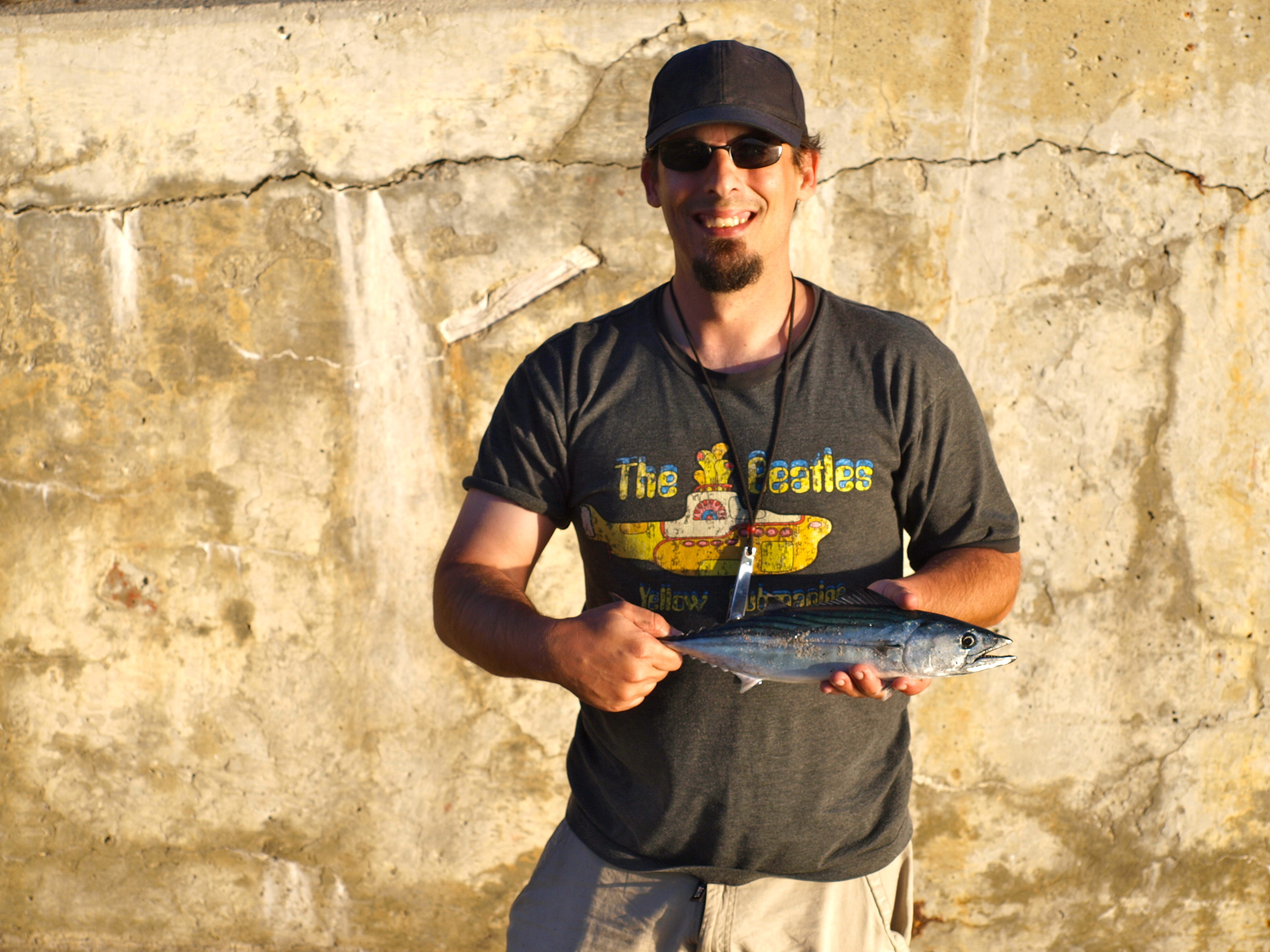
SteveO and a bonito
On each and every cast, as the rig is about to hit the water, I touch my finger to the mainline to slow down the weight, and the fly or lure will shoot forward ahead of the weight as it splashes down. I follow this with two quick and firm jerks of the rod to straighten out the leader. This is where the swivel equipped weights really shined. A couple of jerks on the rod almost always cleared the line for a good retrieve. On rare occasions, the leader would wrap a few times and stay that way throughout the retrieve. Most times you can pull the rig out of the water, jig it lightly a couple of times and it would resolve itself, ready for the next cast. This is a very easy rig to cast when you use a 1oz torpedo with a ¼ oz. leadhead and 4” plastic. This has opened up my fishing options for just about everywhere I fish! A ¼ oz. leadhead with plastic on this rig can be cast long, long distances and will cover much more water than the leadhead alone. The Rapala X-rap behind a 2 oz. torpedo can easily be thrown 90+ yards (this could make a killer striper rig for some spots).
You can fish this rig surface, shallow, deep, fast, slow, dead drop, etc. We had quite a few hits on the dead drop. Just cast out, straighten the line, and wait. Or stop for 5-10 seconds mid-retrieve. A very, very versatile rig that is as simple as can be!
The most effective lures this year were flashy chartreuse flies in #2 and #1 sizes. Clouser Minnows, Deceivers and Bunny flies all worked well. The interesting thing was that the more bloody, mangled and sparse the fly would get, the better it seemed to work. I knew that small sparse baits were effective, and many of the flies I brought had been trimmed down in advance to simulate a smaller, thinner profile bait. The flies seemed to hold up very well, with 10+ fish on one fly before it started to become ineffective. Most of the damage to my flies actually was not from the fish, but from grasping the shank of the hook with pliers for hook removal. For some reason the Jack Mackeral shredded flies far worse than the bonito, even though the bonito have visibly bigger teeth. I was also able to catch using the torpedo rig with a standard ¼ oz. leadhead and the Space Guppy 4” SWA plastics that I have had success with in years past. I tried the Rapala for a while, and landed one bonie on it, but that was more of an experiment to see if the rig was still castable with a hard jerkbait, and it is! I did try throwing tins/metal jigs this year for a brief time, but with no fish to show, so I concentrated on what worked. G-dude did manage a few on his smaller BuzzBomb I think
- Pelagics —Pelagic species are open-ocean water fish and the larger pelagics, such as tuna and billfish, are rarely found close to shore. However, some of the smaller and mid-sized species do migrate into inshore waters; included are jack mackerel, Pacific mackerel, Pacific sardine, Pacific bonito (discussed above), California barracuda and yellowtail. All can show a wide variance in numbers depending upon the ocean currents and water temperature (down during the La Niña cold-water years and up during the El Niño warm-water years).
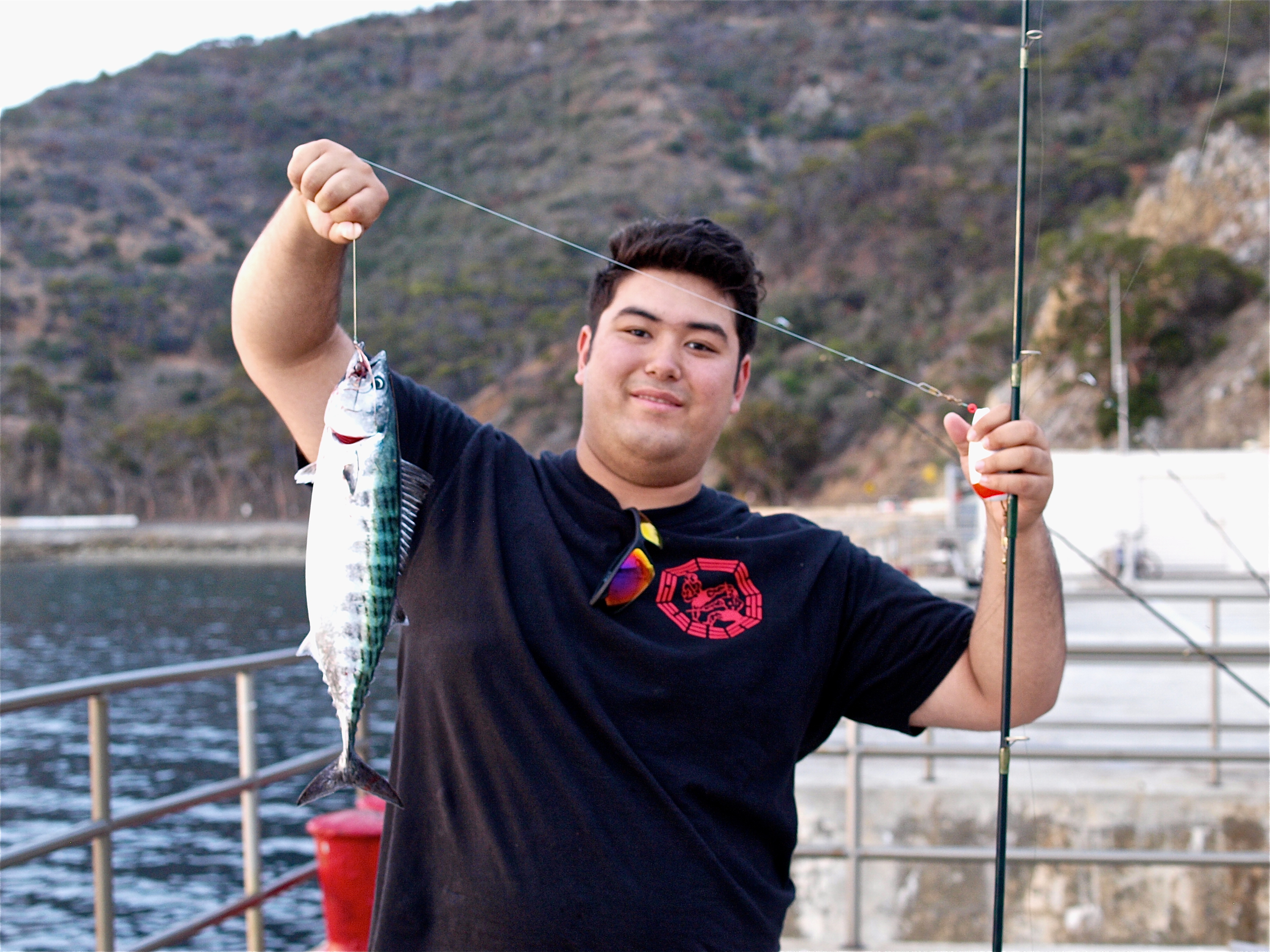
Kyle Pease with a bonito
Jack mackerel seem to be found at Avalon most of the year and some years their similar-looking cousins from the south, Mexican scad, also inhabit local waters. Pacific mackerel, although one of the main fish found at mainland piers, seem to be less common in Avalon. Nevertheless most years will see mackerel but usually not until the summer-fall months. Pacific sardines were showing up at Avalon in the early years of the new century but I have not seen a single sardine at Avalon since 2013. Given their recent overall drop in numbers in SoCal waters, it’s perhaps expected.
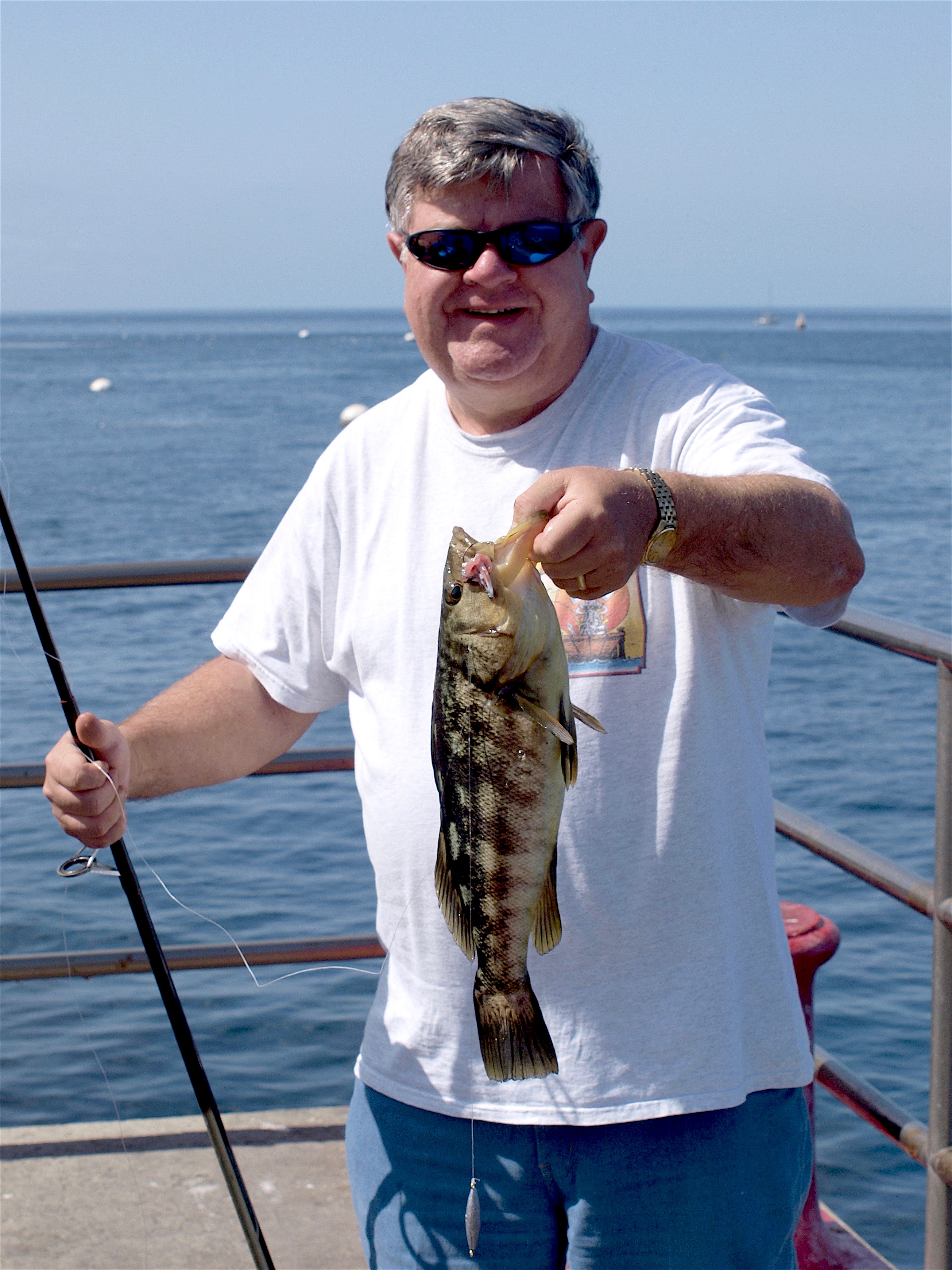
KJ and a kelp bass
All of these fish inhabit mid to top-water zones. A high/low held a few feet below the water’s surface can catch both jack mackerel and Pacific mackerel if they are present.
The jack mackerel have proven to hit on most of the listed baits, everything from worms to peas, and since most are fairly small 6-10 inch fish, small hooks are best.
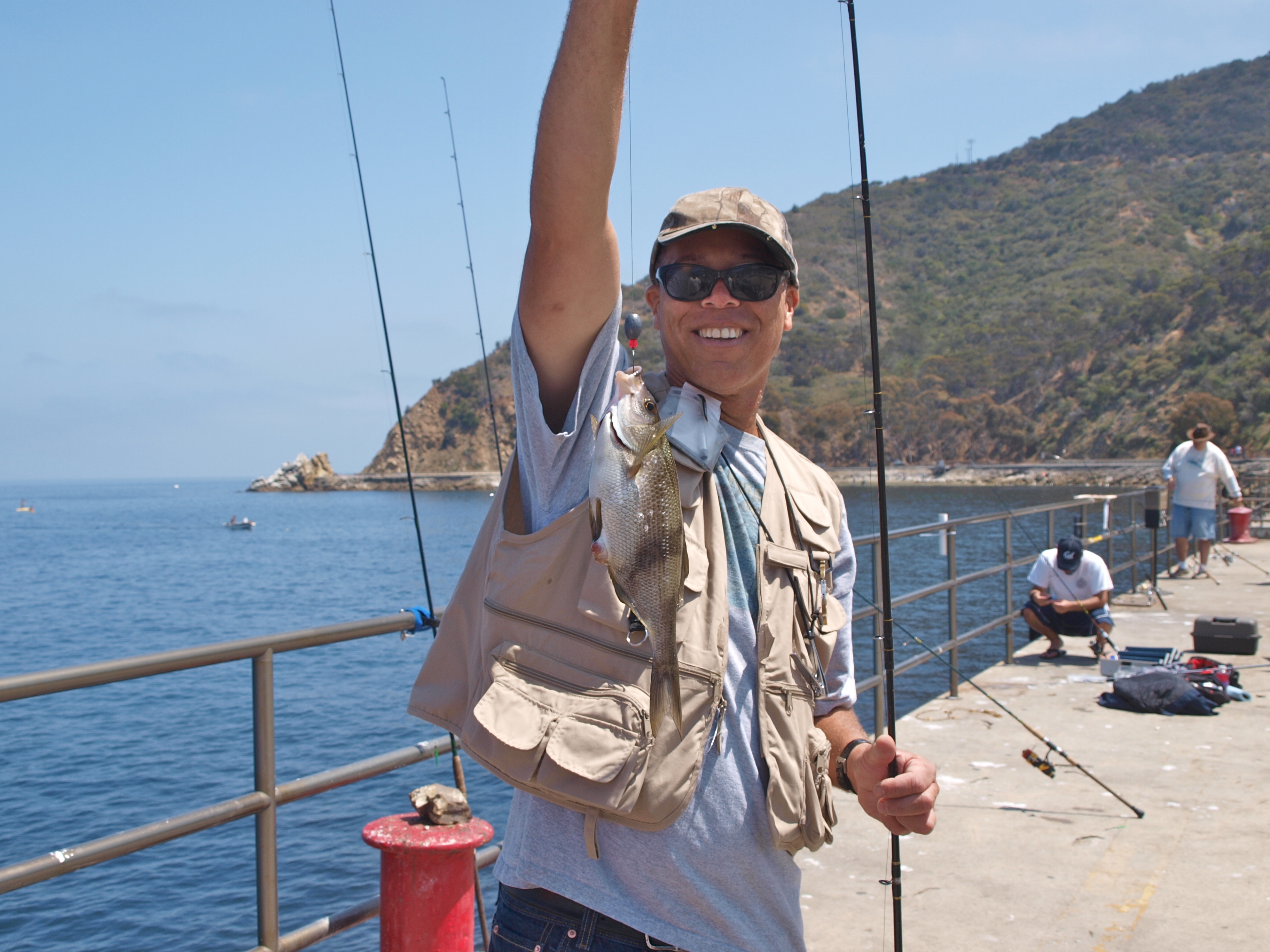
Redfish (Robert Gardner) with a pileperch
Generally the Pacific mackerel will hit best on a small strip of squid or a bloody piece of mackerel and as a general rule the mackerel prefer to show up two times a day—early morning and early evening into the night. Many times I’ve seen pier anglers in the morning go fishless while nearby anglers who arrived an hour or so earlier had a full bucket of mackerel. Or, I see people leave a pier fishless while as soon as the sun drops the macks are in full mac-attack mode.
Nighttime fishing for the mackerel can be exciting. At night you’ll see various rigs, either people using bait or Sabiki-type bait rigs fished under a glow-stick (although 3-6 mackerel twisting up a Lucky Lura/Sabiki leader isn’t so lucky—it often results in the loss of the $2-3 leader). Often when the macs are hitting, glow sticks will be headed every which way and you will need to keep track of which line is yours so that it isn’t tangled with a neighbor’s line. It can be a little crazy at times but fun. But, a high/low baited with a piece of mackerel and fished under a glow stick is just as much fun and rarely means a loss of rigging (and remember that bringing in a Sabiki with 4-6 mackerel through the kelp at the Mole is no easy task).
Summer to fall months will also see some barracuda, some during the day and some at night. The best bet to catch them is generally a gold- or silver-colored spoon like a Kastmaster or Krocodile but Megabaits also get a fair share.
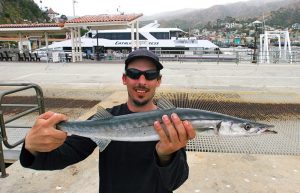
PFIC regular Steve with a barracuda taken in 2009
Most years will also see some yellowtail show up, usually in the August-October months, and most will be the smaller firecracker-size fish. This can change during the warm-water years when more fish will show up, the run can start earlier in the summer, and larger fish may also visit the pier. As example, during the El Niño conditions in 2015 there was an extended run of yellows in September, mostly firecrackers in size but also some of the larger “tanker” size fish. Most of the yellowtail were caught on live bait fished under a float of some type with “Spanish jacks” (jack mackerel) being the best bait. A few were also hooked on lures—spoons such as Megabaits and even soft plastic baits such as Big Hammers and Fish Traps. One of the keys if you do hook a yellowtail is to keep it out of the kelp. Keep a net handy and use it as soon as the fish tires and is near the pier.
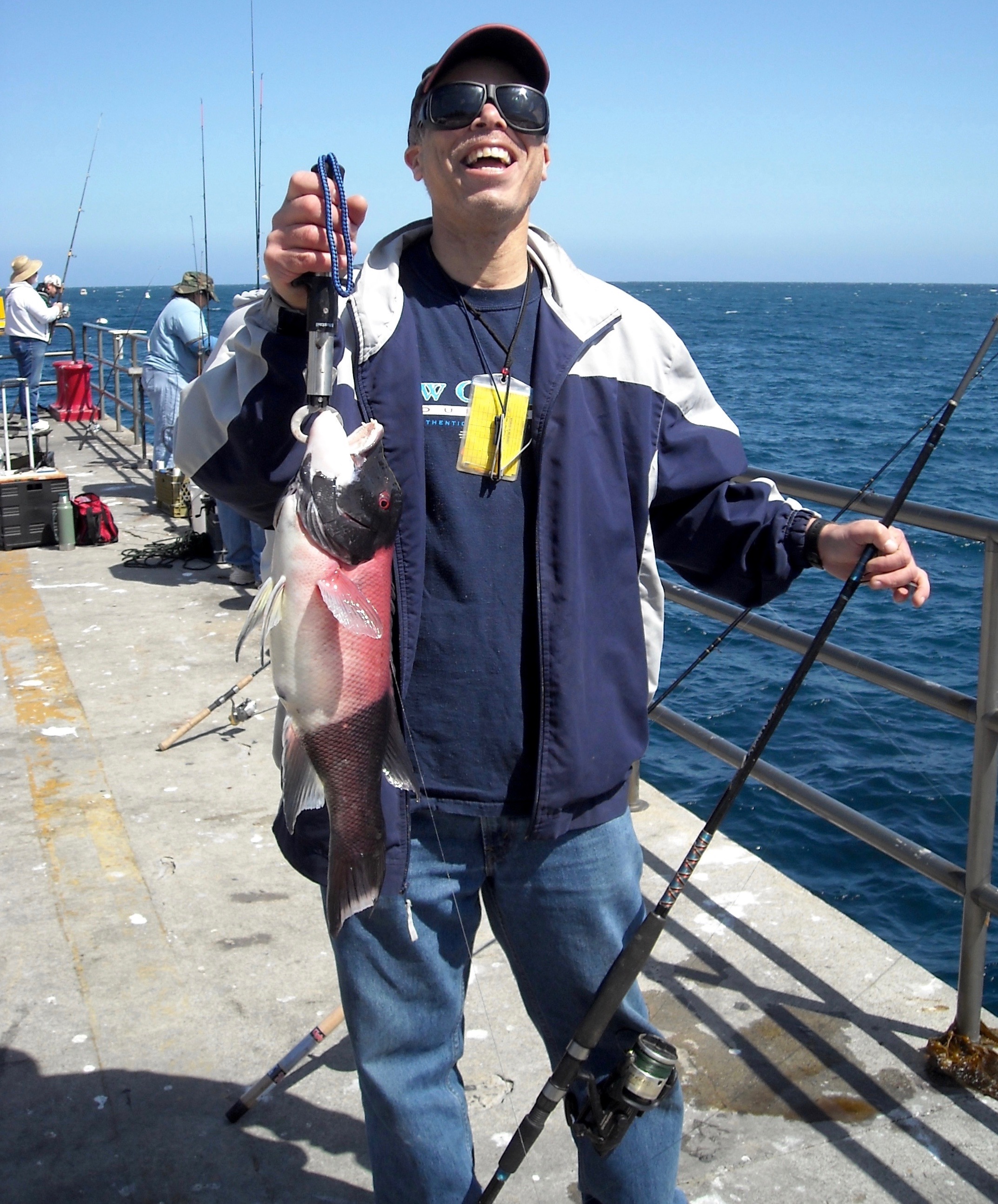
Redfish (Robert Gardner) and a sheephead
- Artificial Lures — Due perhaps to the kelp, most anglers do not use artificial lures at the Mole. However, a few locals seem to come out each night in pursuit of kelp (calico) bass and soft plastics such as Big Hammers, Fish Traps, and even Berkley Power Sand Worms seem to get a few hits and sometimes these are big fish.
Since I am not an expert at using such lures, I yield to the advice of another PFIC angler—DaveMcD. For a period of time he was stationed on San Clemente Island and while there he often fished at the Navy pier at Wilson Cove, a pier with very similar conditions as the Mole.
In one message he said, “I recommended 4” and 6” swimbaits, 3” and 5” curltails, in colors such as Red Shad, Rainbow Trout, Chartruese, Pumpkinseed, and Golden Brownbait; these work well around the kelp (as well as open water) for calicos, yellowtail, an occasional sheephead, and white seabass. Krocodile spoons 4-6” models, and Tady 45 irons (green and yellow combo seems best).” In another message he said “I used a second pole with 10-lb line to cast 4-inch, Red Shad color, Bass Assassin curltails that I rigged weedless with a ¼ oz. bullet sinker, and some Mustad, size 1, worm hooks that are blue and have the double 90 degree angles near the eye. I put the angle part so the hook shank comes out on the back of the Assassin (and lies flush on the outside of the back) and then poke the point back through so the point lies tucked up between the two belly flaps of the Assassin. This made it extremely weedless for dragging through the kelp and at first I wondered if this would affect the hooking ability, but the bass proved this didn’t hinder them at all. I cast out into the weeds trying to hit the holes and let it sink as far as it would, and then a very slow sort of yo-yo retrieve. The line would lie on top of the floating kelp strands, so I would bring the lure up until it would go over the next kelp strand, and then let it fall again into the next hole. Worked great, got two calicos about 3+ pounds each and a third about 1 1/2 pounds, all while watching a beautiful orange and rose sunset over the Pacific.”
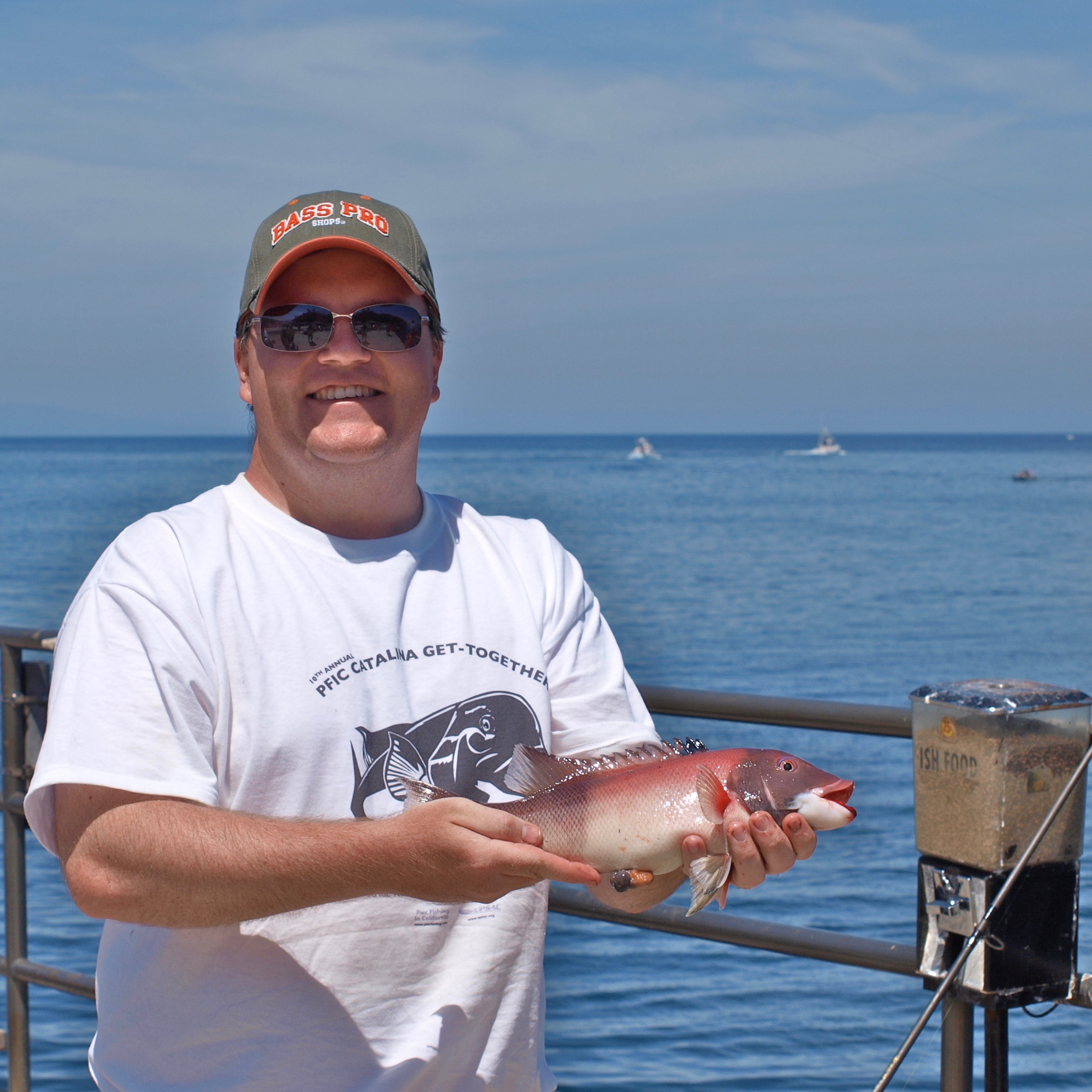
Baitfish (Adam Cassidy) and a sheephead
- Fishing at Night —Fish tend to fall into one of three categories, those primarily active during the day (diurnal), those most active at night (nocturnal), and those most active at twilight—dawn and dusk (crepuscular).
Having said that, the rules are not absolute, a primarily nighttime species may show up during the day and a primarily daytime species may show up at night. As example, opaleye and black seaperch are supposed daytime species but I have caught both at the Mole at night; treefish that are considered a nighttime species are caught frequently during the day at the Mole.
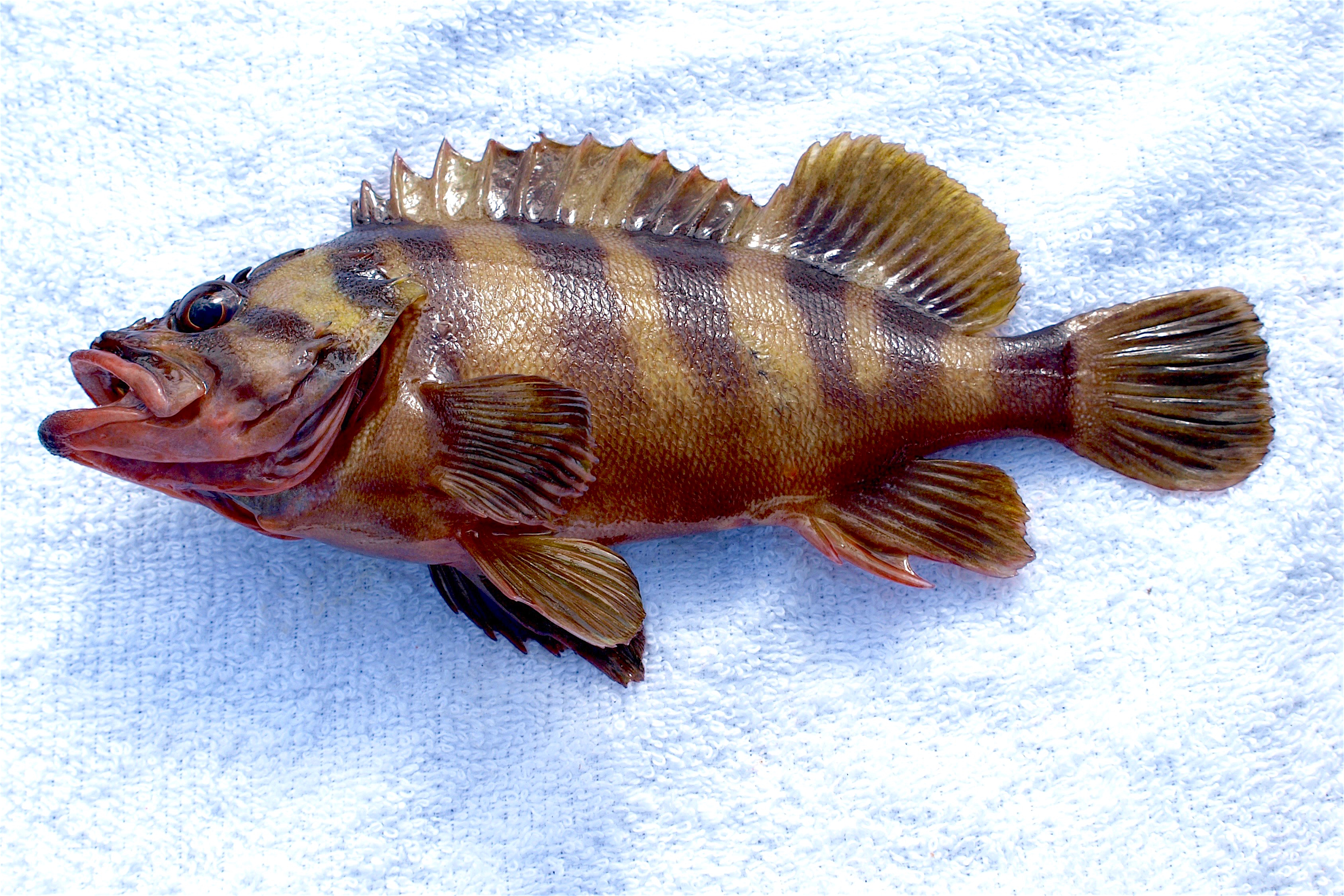
Treefish
Nevertheless, nighttime action at the Mole is quite different and tends to confirm the difference between the daytime and nighttime species. The overall affect is that nighttime action at the Mole is typically slower than during the day. At the same time, you’ll encounter some species rarely seen during the day and also encounter some larger specimens of species seen during the day.
- Diurnal Species — The decrease in action at night is primarily due to several resident species being diurnal meaning they are active during the day and sleep at night. Included in this mix of fish are senorita, rock wrasse and sheephead and since both senorita and rock wrasse are constantly attacking bait, you’ll be getting less bites. Some of the fish, especially the senorita, actually bury themselves in sand at night with just their heads sticking out. They apparently head to bed about twenty minutes before sunset and reappear, ready to eat (and start attacking bait), about twenty minutes after sunrise. Since I’ve never seen any of them wearing a watch I am not quite sure how they manage this 20-minute routine, but that’s the scene reported by the marine biologists.
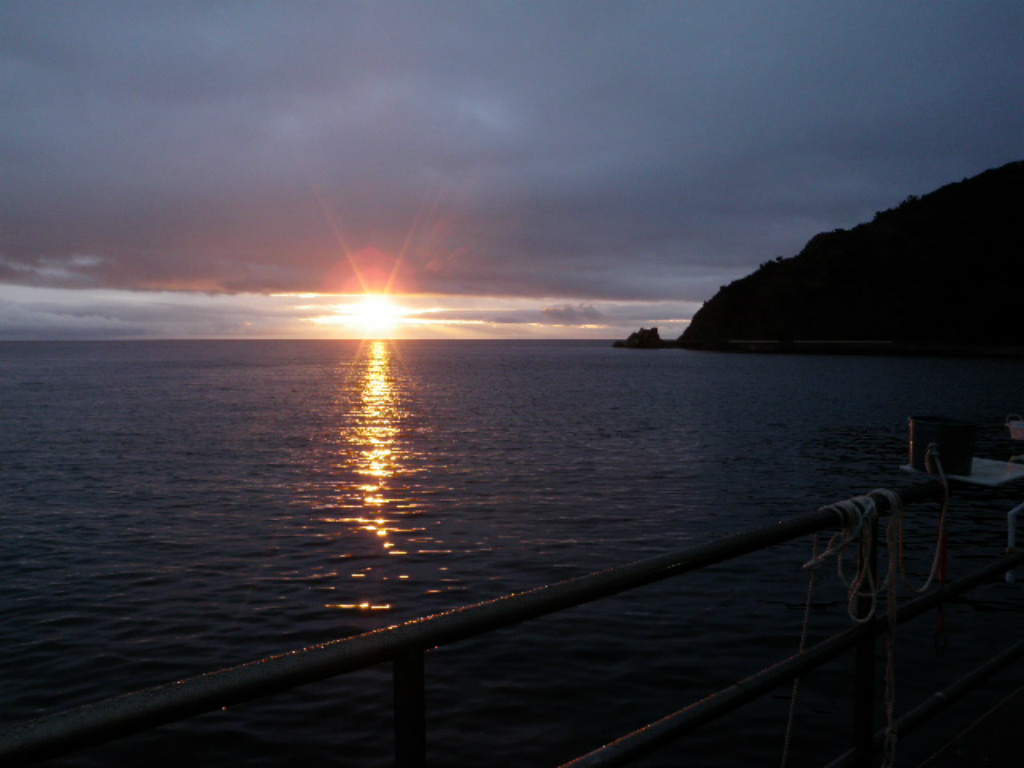
Lovely nocturnal view from the Mole by Mahigeer (Hashem Nahid)
• Nocturnal Species — As for the species caught at night, most common will be kelp (calico) bass and the nocturnal hours really seem to see a lot more of the BIG kelp bass. Studies have shown that juvenile kelp bass primarily feed on small organisms during the day and shelter amid vegetation at night. Sub-adults primarily feed on crustaceans living near the bottom during the day and though they may feed at night it’s usually only over sandy areas. Adult bass are more piscivorous in nature feeding on other fish (and just about whatever else they can grab) and are especially active at night; sub-adults are primarily diurnal while adults are more nocturnal.
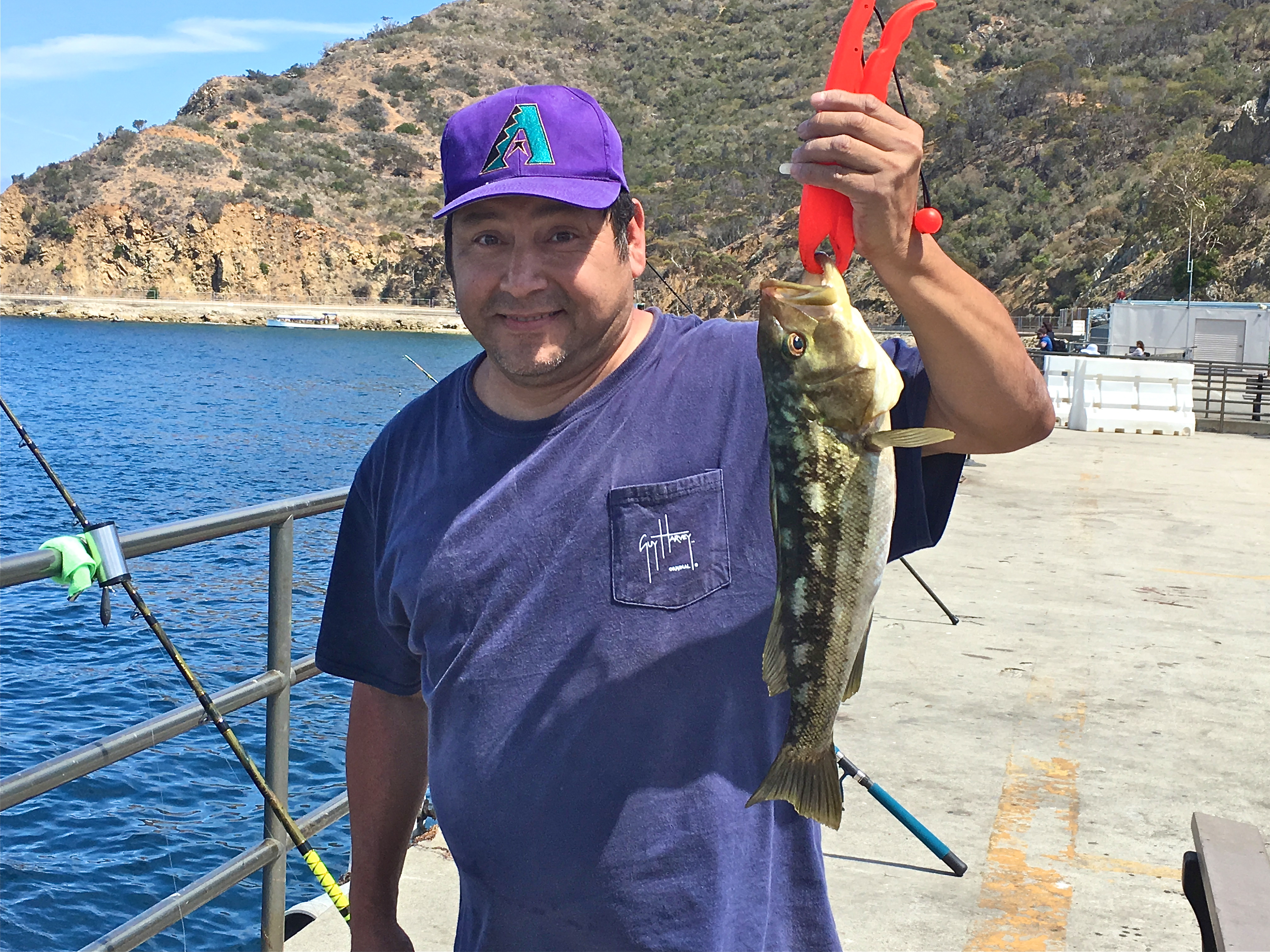
This good-sized kelp bass hit during the day but more of the big bass hit at night
Nighttime hours also sees quite a few scorpionfish. Although they are considered a nocturnal fish, a few are caught during the day. Nighttime hours though will see far more.
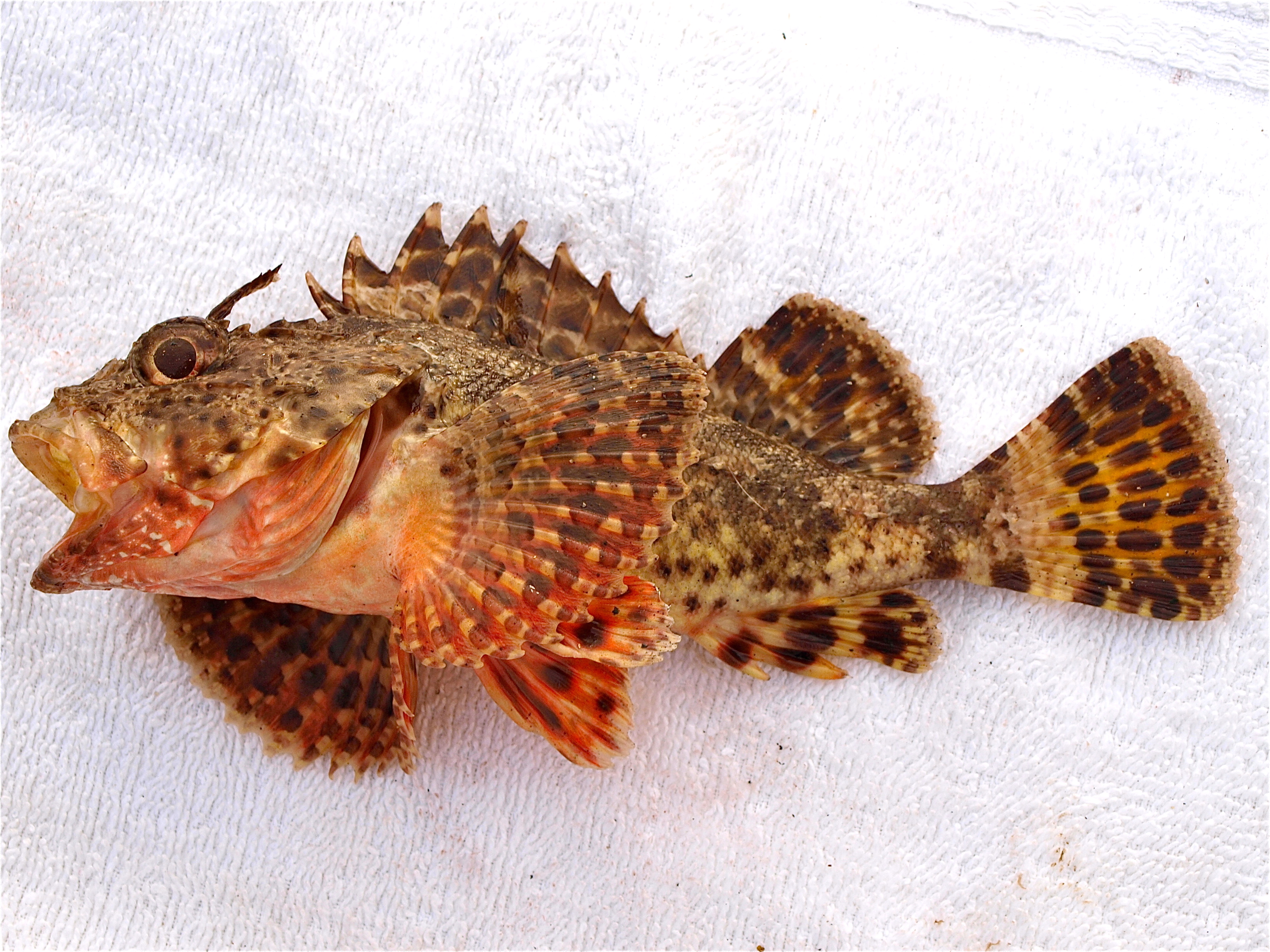
Several species rockfish are noted primarily as nocturnal, nighttime species. Included here are several that rarely show up during the day—kelp rockfish, olive rockfish and brown rockfish. Although not considered a nocturnal species, the only grass rockfish I have caught or seen at the Mole was during the night. Treefish are considered to be primarily nocturnal but some are also caught during the day.
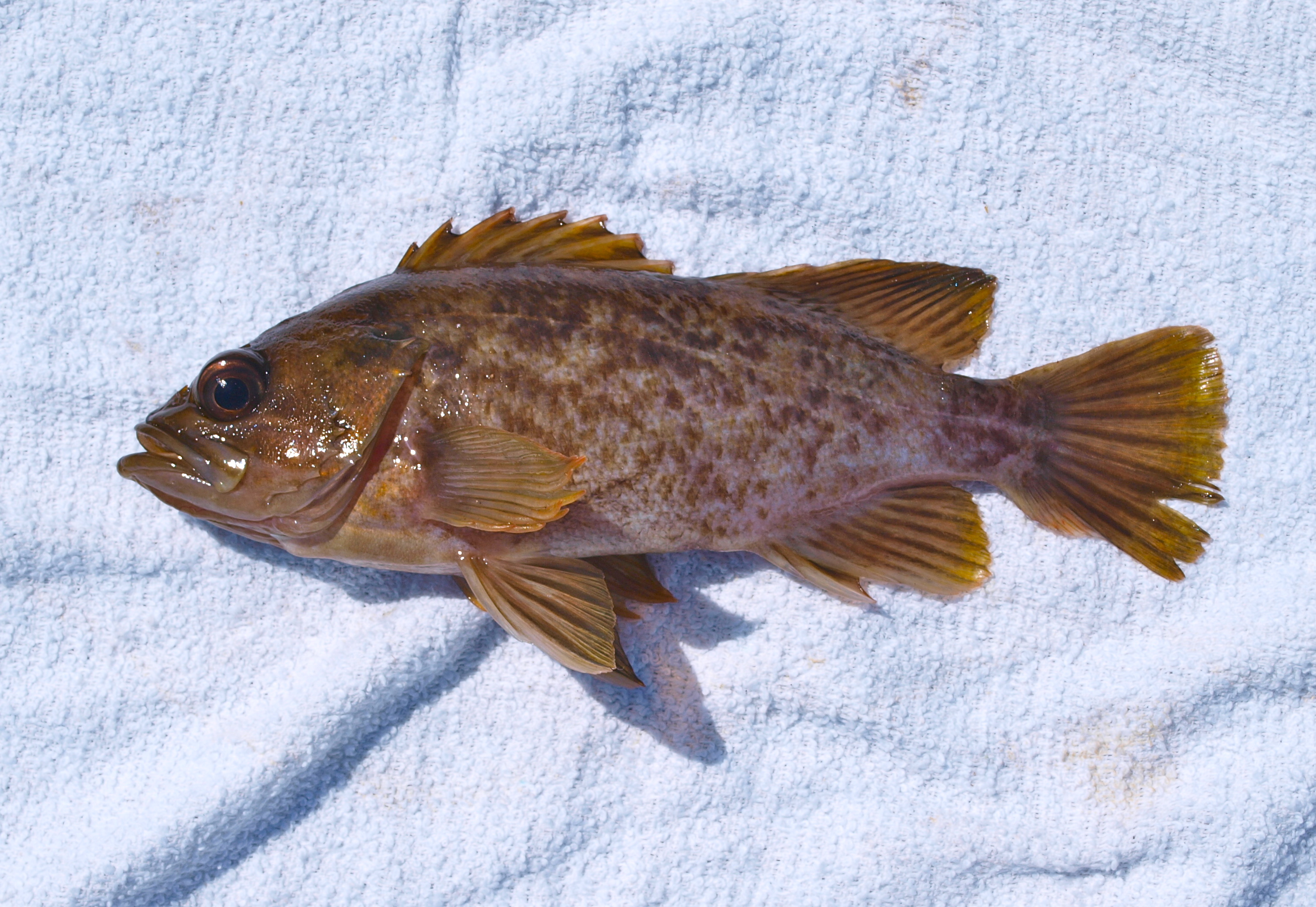
Rockfish
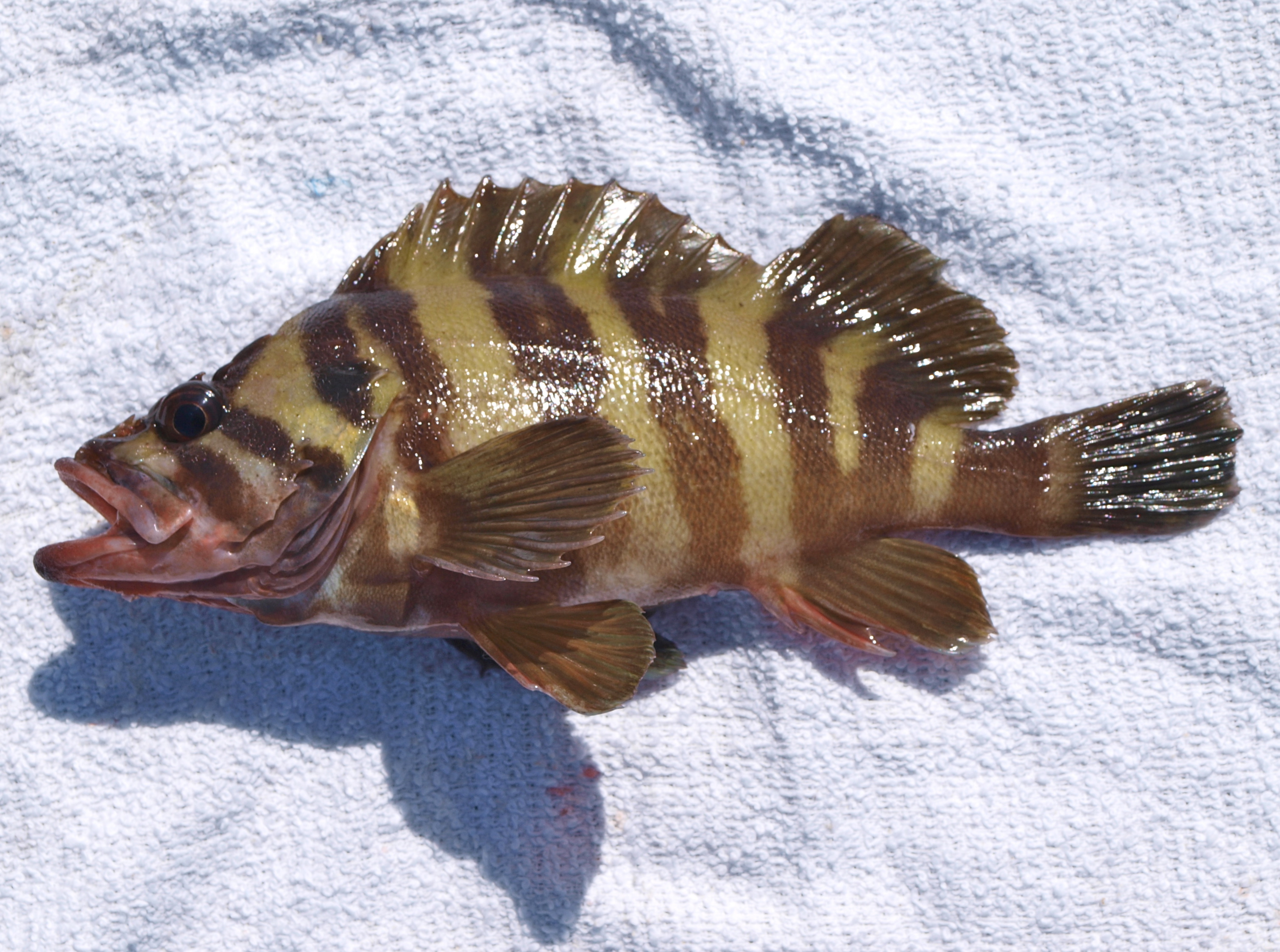
Treefish are easily recognized by their yellow color, stripes and pink lips. A nickname is lipstick fish.
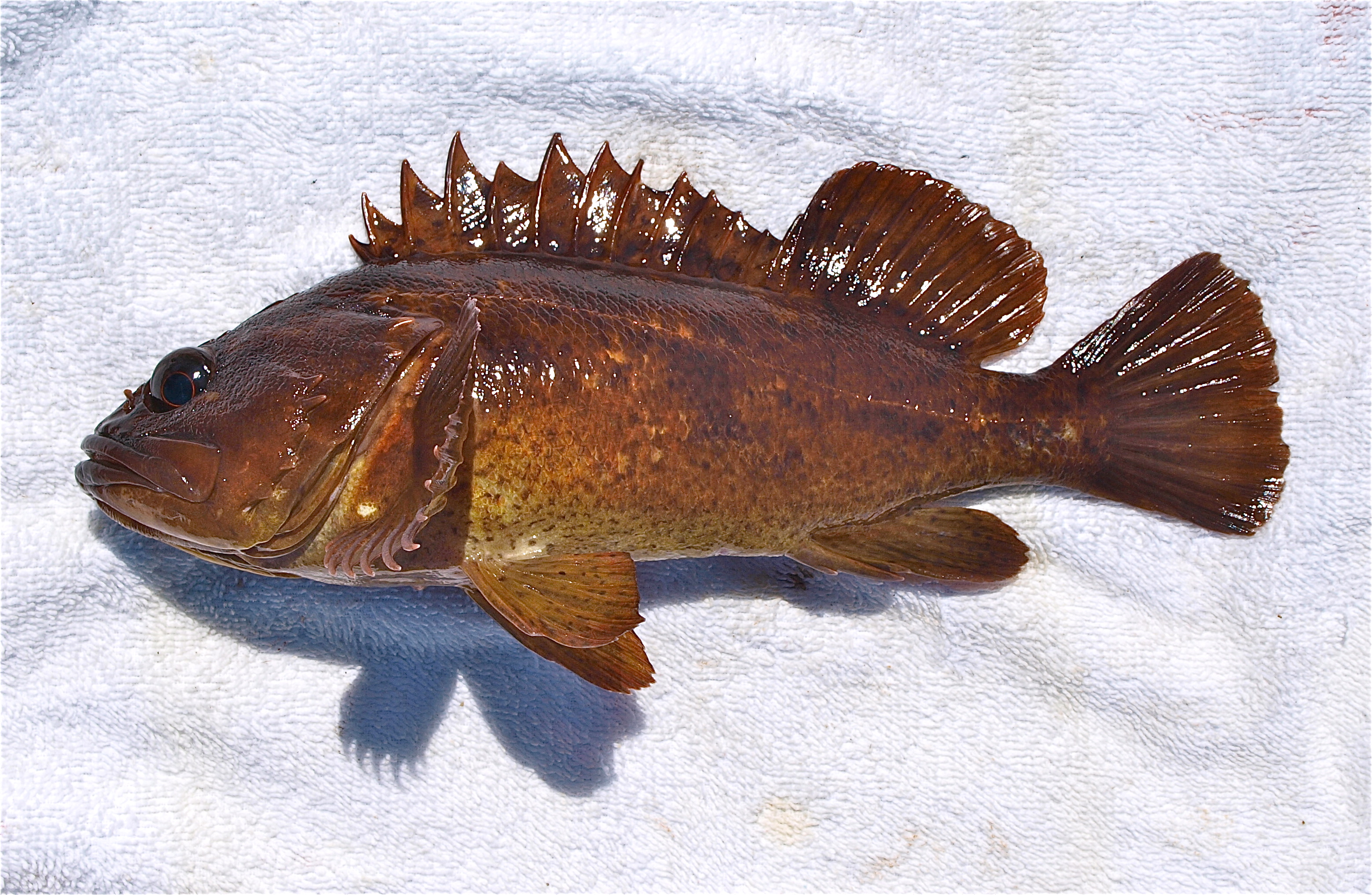
Rockfish
Another species rarely encountered during the day but frequently common at night are salema, a big-eyed fish seemingly made for nighttime action. Since the salema travel in schools, when you catch one you will almost always catch more.
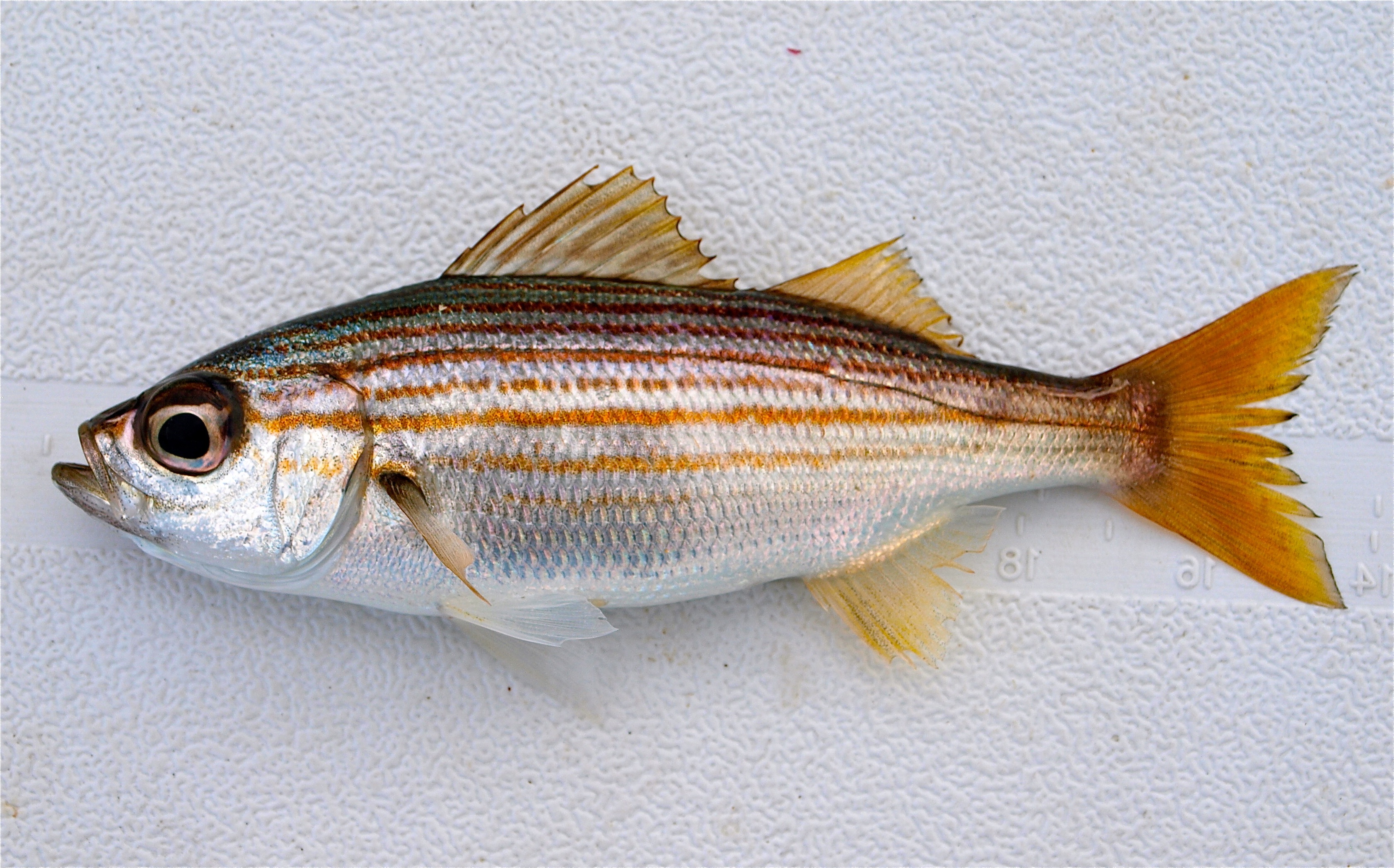
Salema
Moray eel are another mainly nighttime fish albeit we’ve seen several caught during the day. At night they leave their caves and crevices in search of food and you never know when one might grab your bait.
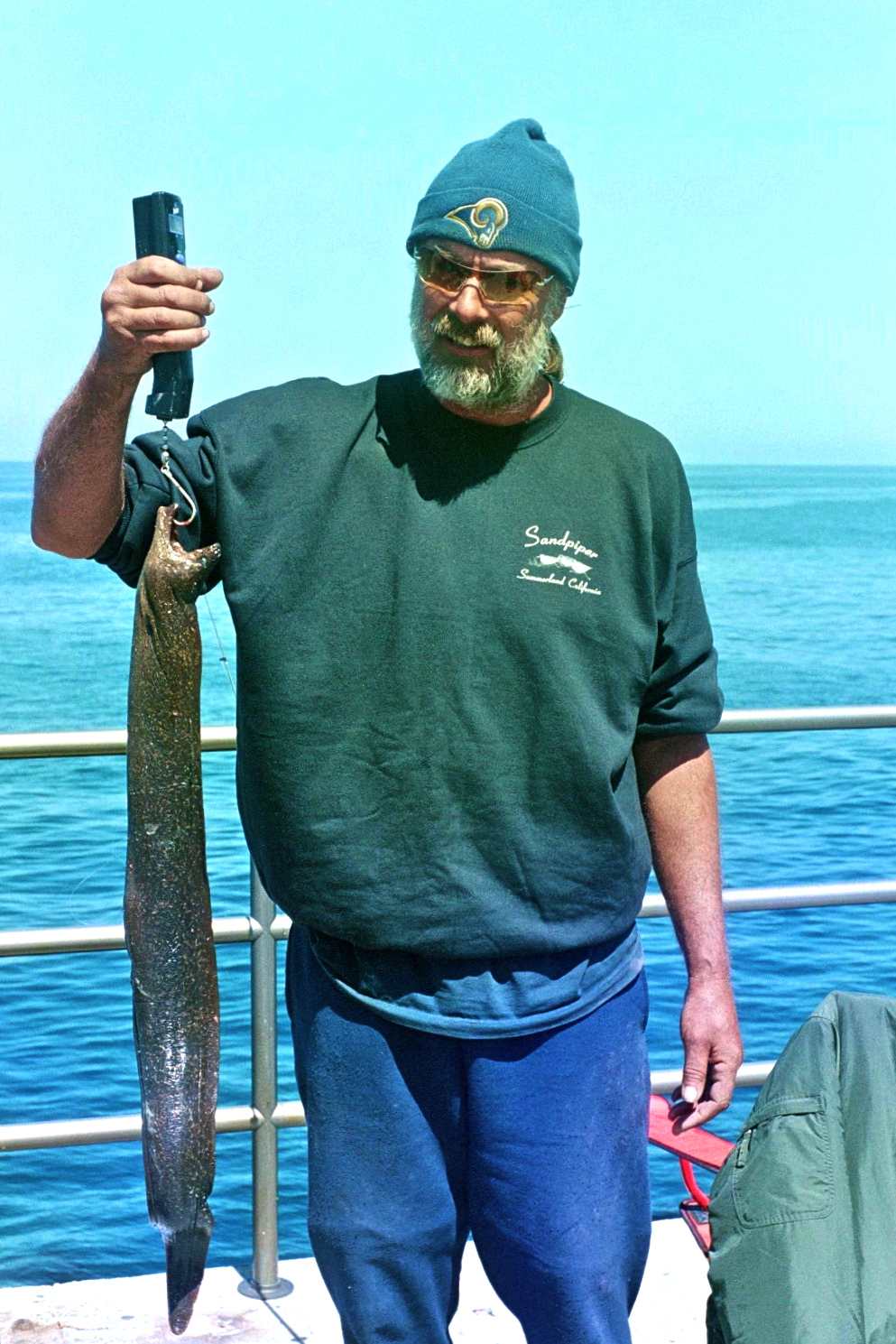
Moray eel
Both sharks and rays are noted nocturnal species and nighttime action may include a few sharays. However, the number here usually is fairly low with the most common—horn sharks, swell sharks and bat rays, making only occasional appearances.
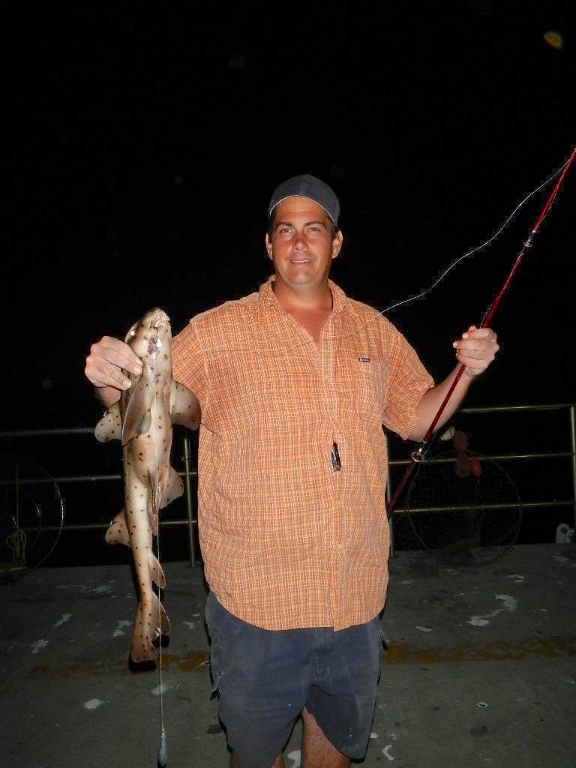
Horn shark caught at night by Burger
- Crepuscular Species —The primary crepuscular (dawn and dusk) species is probably Pacific bonito. They are famous for making a run right at daybreak and then again as the sun is setting. They are not at the Mole every year but when present the locals know to hit the Mole early and late.
A second crepuscular species is Pacific mackerel—with a difference. When present, and again it is not every month or even every year, they are noted for morning and late afternoon “mac attacks” when they seem to hit anything thrown in the water. The difference with bonito is that you rarely see a bonito caught at night. Mackerel though will often hang around after sunset and attack non-stop for several hours.
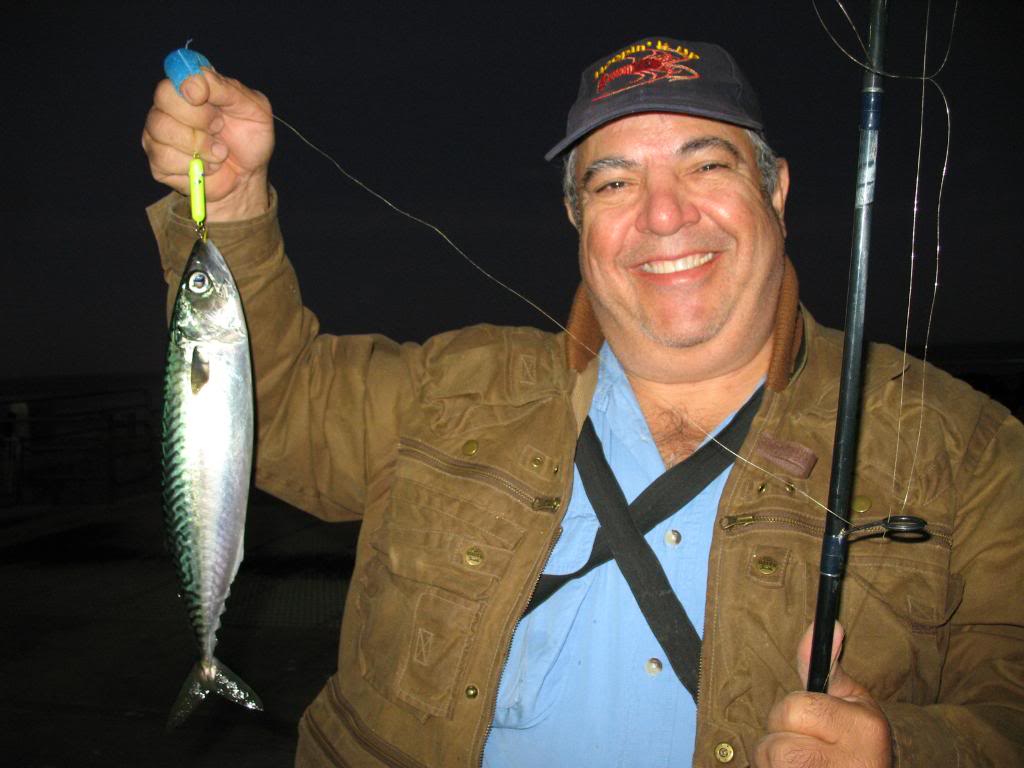
Mahigeer (Hashem Nahid) and a Pacific mackerel
- Crustaceans —There was a time when the Mole was the best places along the coast for pier rats to hoop net for spiny lobsters (far better than any mainland pier). Locals would be out at the Mole during lobster season and anglers would make the trip over from the mainland just for the lobsters. Then the Marine Life Protection Act came along! After many, many tumultuous meetings it was decided that the Mole would remain open for anglers to catch fish. But, it would be closed to lobster. For a couple of years the boundary lines were set incorrectly and locals continued to seek out the spiny lobster but eventually the lines were fixed. Today, it’s illegal to target or keep lobsters at the Mole. You can still hoop for lobsters at the Green Pleasure Pier.
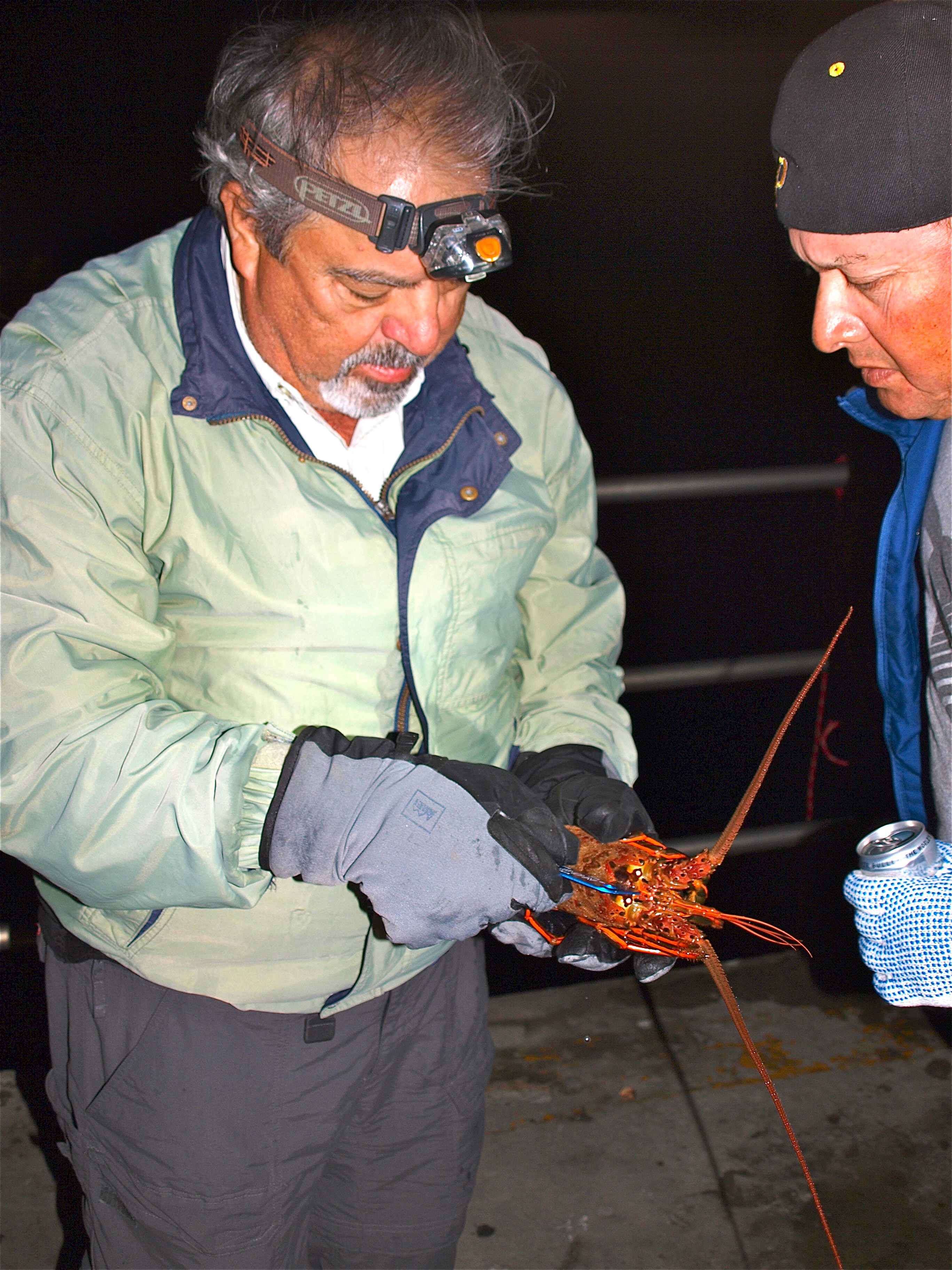
Mahigeer (Hashem Nahid) measuring a lobster
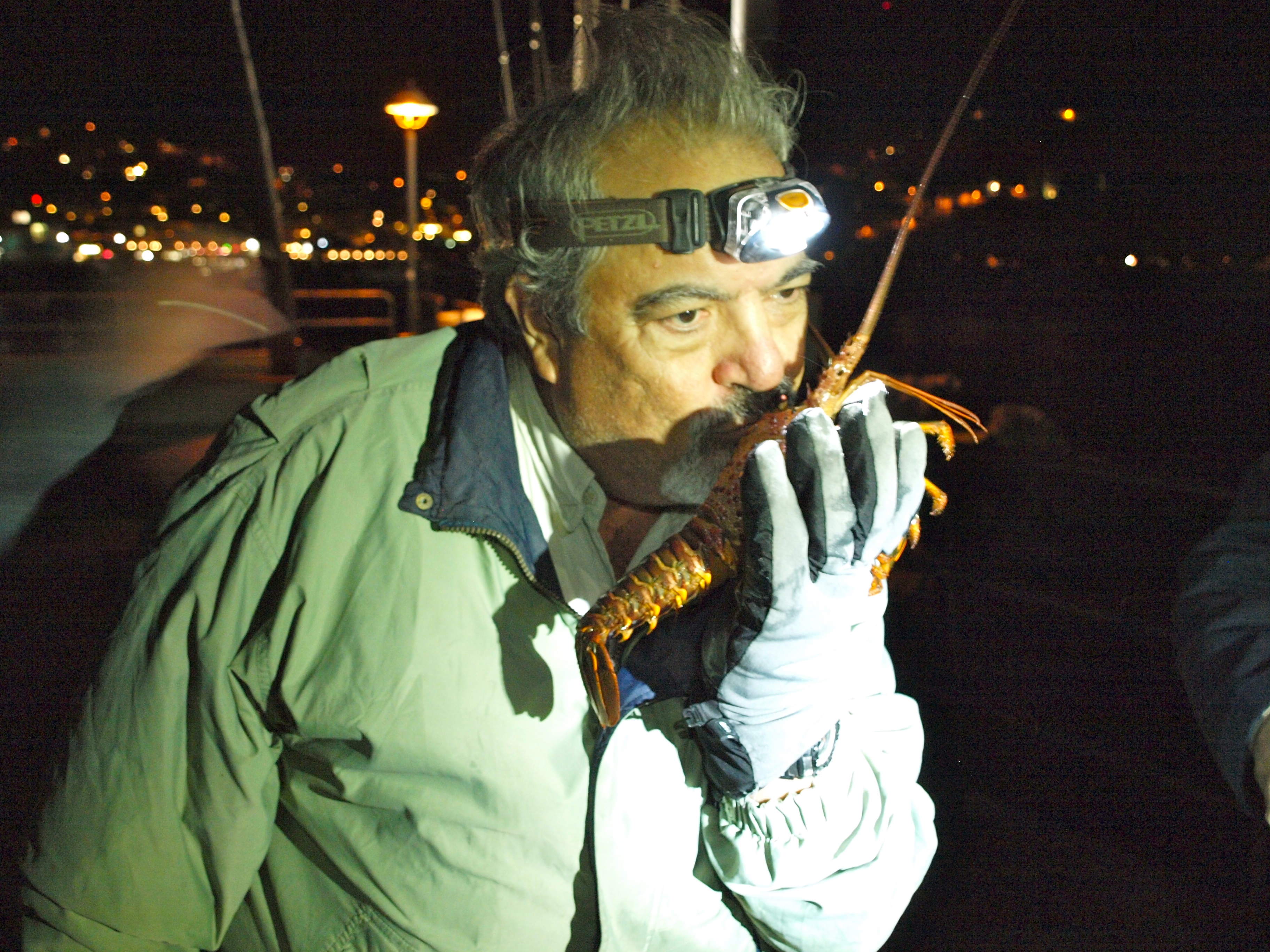
Mahigeer: Too small, adios amigo — and adios amigo to hoopin’ on the Mole.
When it was possible to hoop at the Mole you could fish a little, hoop a little, fish a little, hoop a little … and bring home a nice variety for the Mrs. Those days are gone! However, no one told the lobsters. It is fairly common to see a lobster or two pulled up on a fishing line during the day at the Mole and it’s very common at night. But remember—lobsters are illegal at the Mole; it’s as simple as that.
You occasionally may also see a large spider crab aka sheep crab grab a bait (although they are much more common at the Green Pleasure Pier) but they too are illegal at the Mole.
Potpourri — Perhaps More Than You May Want To Know About The Cabrillo Mole
<*}}}}}}}}}>< — Can it get get cold in this earthly paradise? Yep! Two long PFIC Message Board posts and versions of the same trip with slightly different perspectives!
Date: March 11, 2010; To: PFIC Message Board; From: Mahigeer; Subject: An Epic Fishing Marathon at Catalina With The Skipper
Skipper Jones was going to be in Los Angeles for the Fred Hall Show on Saturday and Sunday, so I suggested he join me for one more marathon fishing/hooping at Catalina. This was my last opportunity to go one more time before March 17th, when the lobster season for the law-obeying anglers came to an end. It was accepted. I loaded and did all of the packing before and after the sessions of the FHS.
Come Monday morning we made one stop at the Paul’s Bait and Tackle in San Pedro for some ghost shrimp and then we were at the terminal by 7:30 a.m., carts loaded and waiting for the ticket office to open. Due to a dredging operation at the Long Beach terminal, we had to go from and come back to the San Pedro Terminal. It was OK, since I had not seen that place yet.
Upon arriving at the island around 10:00 am, Skipper noticed that the big floating dock in front of the Green Pleasure Pier was gone along with the bunch of ropes. There was lots of fishing space and no one fishing.
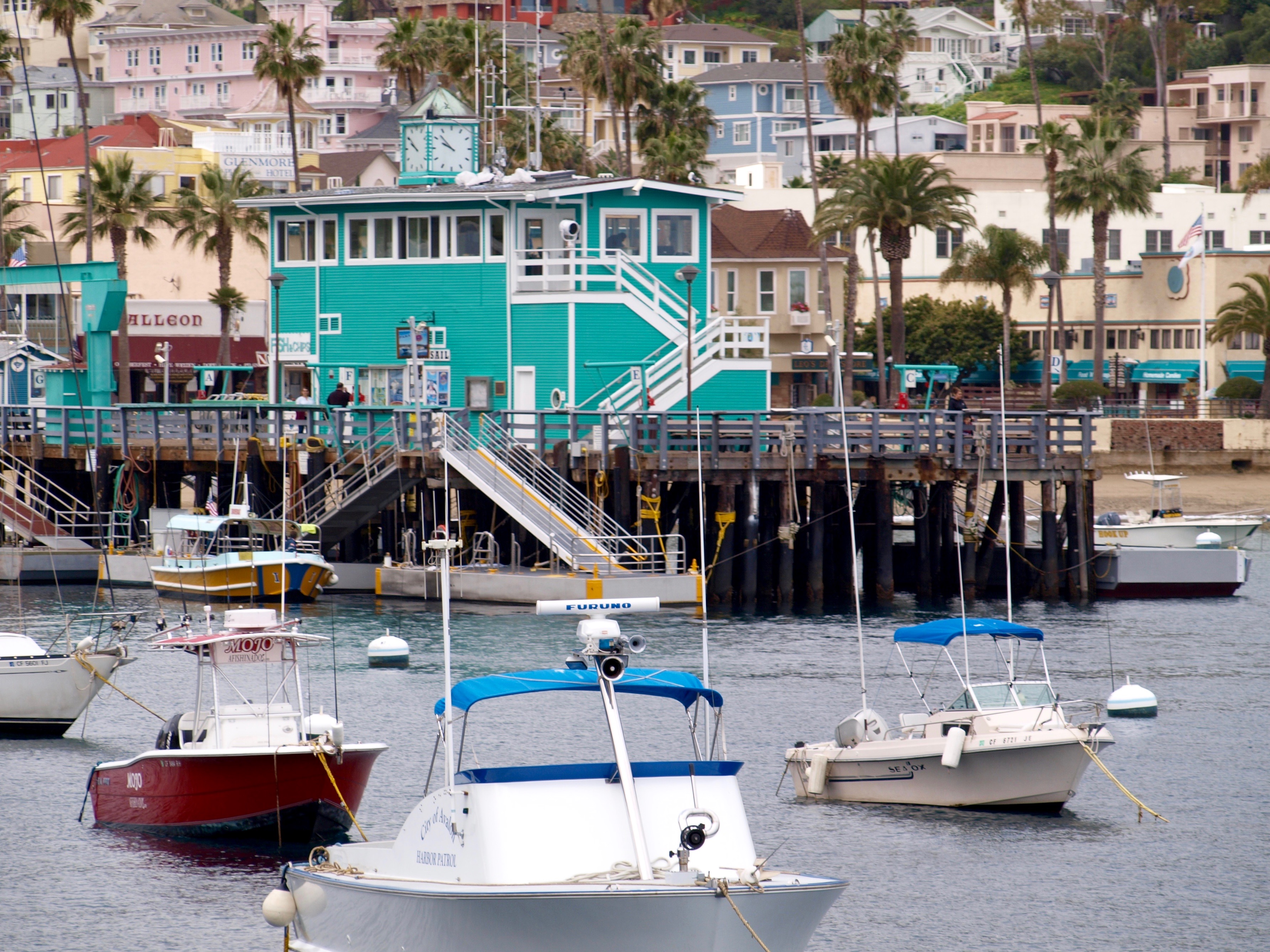
The Green Pleasure Pier minus the float that’s installed at the end during the summer season
We saw three other fishermen at the pier the whole time we were there and each maybe fished for ½ hr. or so. Talk about elbow room at the railing! We had decided to fish the GPP first and then setup camp, if you will, at the Mole for hooping and fishing later.
I put one net in the water to see if there are any day-crawling lobsters at that pier. There were none. Due to lack of space, I didn’t take my opaleye (20-foot-telescopic) setup and tackle. However, after seeing the huge opaleye swimming around, I setup a float rig and started with moss as bait. No takers. Then I switched to frozen peas. The fish would come to the bait and just turn around. Very frustrating. Then I started to modify the rig. First I switched to a Fluorocarbon leader, three times the length of the previous leader. Then I moved the spilt shot sinkers higher, so the bait would move more freely.
The first cast after rework produced a fat opaleye. Minutes later there was another one. Then the bite died on opaleye. They are very finicky fish. We did catch a lot of Spanish mackerel though. We released all. We should have kept them for lobster bait. I thought the large bonito from the previous trip would be sufficient bait but it was not. More on that later.
Around 4:00 p.m., we packed and moved to the Mole. I did not want to spend another trip living on submarine sandwiches but the Skipper somehow found out the Buffalo Nickel Restaurant delivers pizza. Hot pizza at the Mole sounded great and they had a two large meat lover’s special on sale. They only deliver after 5:00 pm. so when the time came we got the pizza and enjoyed freshly made hot pizza.
I was casting two different rigs for bonito: a torpedo sinker/bucktail and a cast-a-bubble and rubber band lure. The torpedo got a good hit and a hookup. Fish on! I did a give and take with the fish and suddenly it’s off. I am reasonably sure that it was the seal that was hanging around. A short time later, the #20 P-Line CXX leader, comes back in chewed. That was the only hook up with a possible bonito of the trip.
As the sun was going down, I set up my nets while Skipper was cutting the previously mentioned bonito for bait. The first hour or so it was no bugs. This was not good. Not even short ones. Last time out I had two legal bugs and one short one in a net about 20 min. after the net went into the water.
Eventually the short ones came up. Then a legal, then short, then legal in the mix throughout the night. Interesting enough, the worst the sea got the bigger the bugs became. One last pull before the sunrise, and there was a legal one.
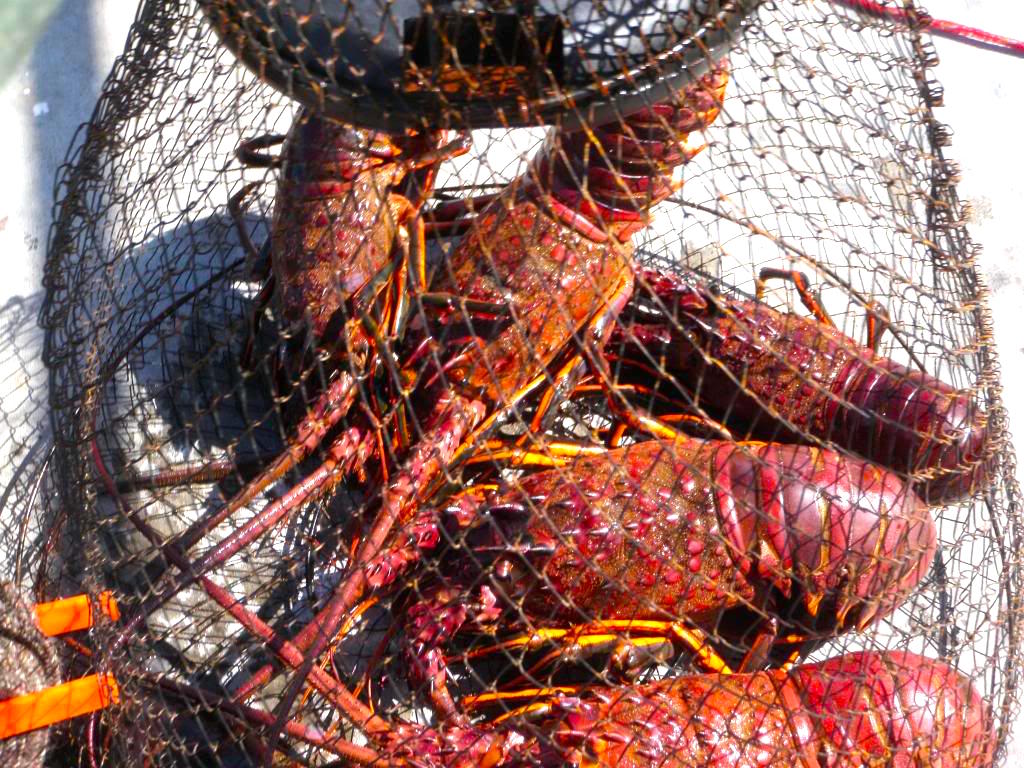
I stayed awake and only took catnaps from time to time between pulls. Skipper got some sleep (I will let him post about his adventure), and around 2:00 a.m., he woke up. He was very cold, so I sat him next to my heater. The hot soup was ready for consumption and it tasted great. Later we shared hot coffee at our “Hobo” camp.
He later decided to go after eel, but the wind started to pick up and it was not bearable beyond the protection of the building we were using as a wind block.
Around 4 am, the Harbor Patrol came and raised the second red warning flag. I kept on pulling nets all night long till sunrise at which time I washed the nets and we put away the nets and packed the “Hobo” camp.
Toward the morning, due to the number of visitors to the net for sushi, I was running out of bait. If we had only kept the Spanish mackerel! Not as good as bonito, but better than nothing. I started to put sardine, squid, or whatever bait looking stuff I had in some small nets and in the bait boxes.
As the sun came up, once again I tried both bonito rigs. No takers. I switched between bait and lure fishing while Skipper kept pulling in opaleye after opaleye.
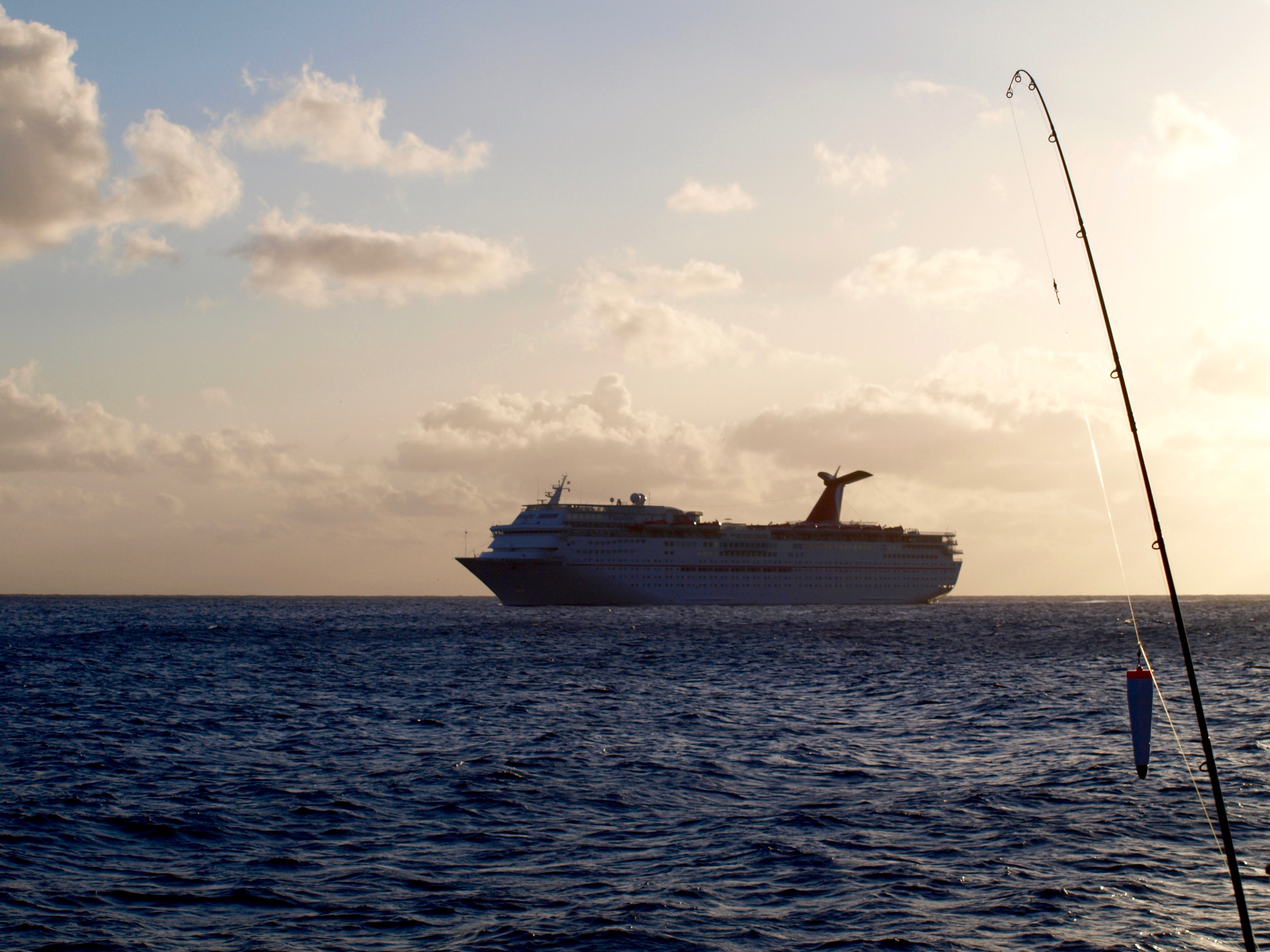
When I went to get a cup of coffee and breakfast from the small snack shop at the Mole, I was told that they might not open since no boats were coming in. SAY WHAT? I went to the Catalina Express ticket office across from the snack shop and sure enough they did not know if any boat were coming to take people back from the island. We were scheduled for the 7:30 p.m. departure.
I called the Hermosa Hotel, and Ms. Mindy, the manager, reserved a room for us. Later at check-in, due to our past loyalty, she gave us two rooms for the price of one. We got some much needed sleep. God bless her. She was looking forward to our April Get Together.
Now we were not in a hurry to pack, since we were staying overnight. We moved back to the GPP, and I went to get the room keys. I made a pit stop for some fish and chips and glass of brew. Skipper continued fishing and kept getting Spanish mackerel. Later we had a light dinner at the Antonio’s restaurant where we hang out during our trips. If I am going to be stranded any place, what a better place than Avalon on Santa Catalina Island.
Next day (Wednesday) we packed, had our normal delicious breakfast at Jacks, and went to the head of the line for the 11:45 boat. No more Mr. nice guy. We were told that the 8:00 am boat had been crowded and that our boat was going to be the last one out for that day.
The trip going back was rough even though we were on a catamaran. The captain went parallel to the island as much as possible to use the island as a shield. We saw extremely beautiful rock formations and emerald blue water and some extremely good looking fishing spots on shore.
This one was one for the books. Windy, cold, getting stranded, staying up for 30 hours, lots of fish, productive hooping and more. Not something I can do often, but next season I will be doing it again, health permitting. The End.
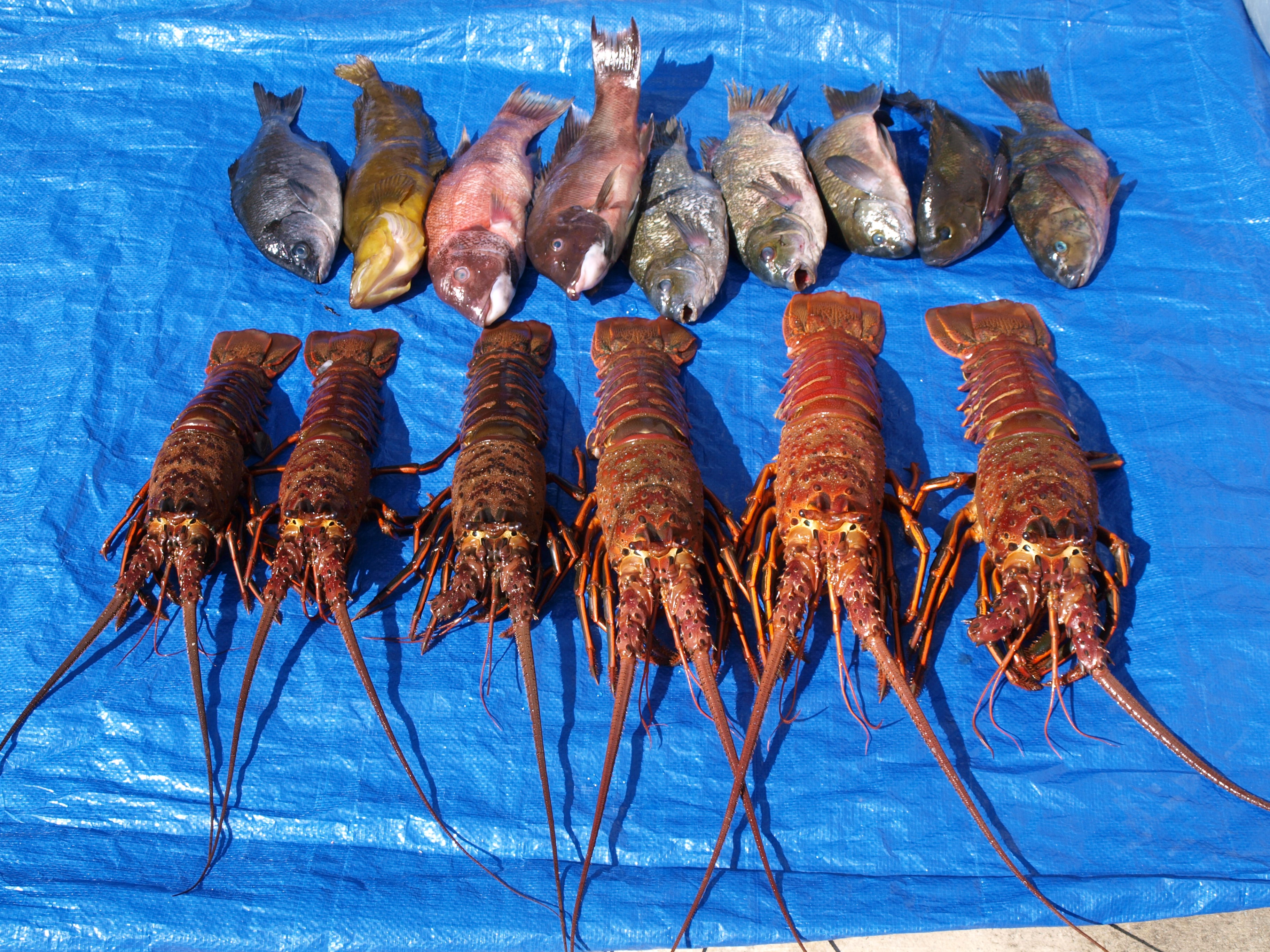
A nice mix of lobster and fish following an eventful trip
Date: March 12, 2010; To: Pier Fishing In California Message Board; From: Ken Jones; Subject: A cold and windy night at Avalon
It seemed fairly simple, why not spend a couple of days at Catalina following the Fred Hall Fishing Show in Long Beach? Hashem had been making some trips over to Catalina during the winter in pursuit of Panulirus interruptus aka bugs or California spiny lobster. It was going to be a very long and tiring weekend but why not? In many ways it could be a precursor to the Catalina Get Together in April; you know, kind of getting the blood ready for the big event… The plan was to head over early Monday morning, spend mid-day fishing at the Green Pleasure Pier, and then move over to the Mole for an all-night fish and lobster fest.
Upon arrival we moved to the Green Pleasure Pier where we found the fish off their feed. The normally over-abundant kelp bass were virtually absent from the pier and many of the normal species were not biting. In fact, the water looked empty of fish, a rare sight at the pier. The one exception was Spanish mackerel (jack mackerel) that would flock to the top of the water when peas where thrown out. The only thing they seemed to want was peas. Not worms, not pieces of shrimp, not strips of baitfish or squid, not lures or Sabikis; the preference was peas—and carrots. Hashem had brought a package of frozen peas and carrots and surprisingly the fish were hitting on both. They peas were attacked first but then the fish moved to the carrots. Luckily we had picked up some ghost shrimp and they were attracting some sheephead. Four and a half hours of desultory action brought me 25 fish: 10 jack mackerel, 5 sheephead, 3 jacksmelt, 3 rock wrasse, 2 senorita, 1 opaleye and 1 garibaldi.
At 3:15 we moved to the Mole where, as expected, the fishing was slower than the GPP though with a slightly more diverse group of fish. The fishing was also scheduled to slow at sundown when many of the island’s species go to sleep for the night (including sheephead). But there are some fish to be had even after the sun is swallowed up by Mother Ocean (including rockfish and the big-eyed salema). While Hashem was setting up his lobster traps I continued to do some fishing though the temperature was dropping and I was getting just a little chilly. It was interesting to see what worked best at night and strips of squid, and pieces of market shrimp, proved best.
Hashem had said it could be cold. His instructions: bring layers of clothing, bring Long John’s, bring gloves, and bring a woolen cap. Easy for him to say; I had brought gloves but mistakenly left them back in my car on the mainland; I did not own a pair of Long John’s and figured it wasn’t worth spending the money on a new pair (do I hear the word cheap? I’ve got Welsh heritage instead of Scotch, but still am a penny pincher at times). But the temperature was dropping into the low ‘50s, the wind continued to pick up (and would reach a rate of over 30 mph), and the wind chill factor dropped into the ‘20s. In addition, the doctor had just given me some new medicine AND I had absolutely NO energy.
At 10 p.m. I stopped fishing; I was just too cold and tired. Five hours at the Mole and all it had produced was 26 fish: 8 salema, 7 kelp bass, 2 kelp rockfish, 2 sheephead, 2 opaleye, 2 jack mackerel, 1 halfmoon, 1 senorita and 1 blacksmith. Not bad but not great and the majority were caught before the Sun took its nap.
Hashem had said be prepared but I was the one who did not follow the 7 P’s and I paid the price. When the wind really picked up (double red flags were blowing) we moved over behind the buildings for a little protection from the wind. Or, I should say I did because Hashem kept busy checking his traps every twenty minutes or so. I finally decided to sit down and Hashem suggested taking a nap. I tried! But on the bench I was freezing cold, I was shaking uncontrollably and cold to the bone, tendons, and capillaries. I was dreaming of the homeless and my sympathy changed to empathy. Worse, I was thinking what the doctor would say if I ran into any problems. It was a night for Vincent Peale’s Power of Positive Thinking. It might have been a good night for those thoughts but my body and brain just wouldn’t cooperate.
I finally fell asleep and somehow stretched together enough 20-minute naps to total about four hours of sleep. Evidently it was a sleep that was worrisome to Hashem. He said when I way laying on my left side I was quiet as a mouse (pier rat?) and he wasn’t sure that I was breathing. However, when I turned over to get my face to the building I was as quiet as a baby (a baby walrus that is). Bellowing like one of those gnarled old bull sea lions that control a huge harem. Last time I looked I didn’t have a harem.
Finally at about 2 a.m., I awoke, and I actually felt somewhat refreshed, even if still very cold. Luckily Hashem had brought some coffee and a pot and soon we had some hot Joe (which helped me break the doctor’s prohibition against caffeine) and some hot soup. Those items were winners at 3:30 a.m. and felt oh so good. Thank you, thank you, thank you Hashem! I decided to give fishing a try again at 4:30 but after the wind blew my hat into the Pacific I decided to let the wind calm a little, or at least I hoped it would. No more fishing that night but some good company and anticipation for the coming dawn. As for Hashem, his lobster quest had started out slow but the windiest time and roughest seas actually produced a plethora of the creepy crawlers. He caught about 30 of the achelate crustaceans, although “only” six were keeper-size bugs (and they were BIG keepers). He said it was his best night ever.
Around a quarter to six the Sun starts to peak over the mainland hills and I was never so glad to see Mr. Sol and his warming rays. Although the wind had abated somewhat, it was still fairly strong. It was going to be hard fishing unless we found a spot with better cover.
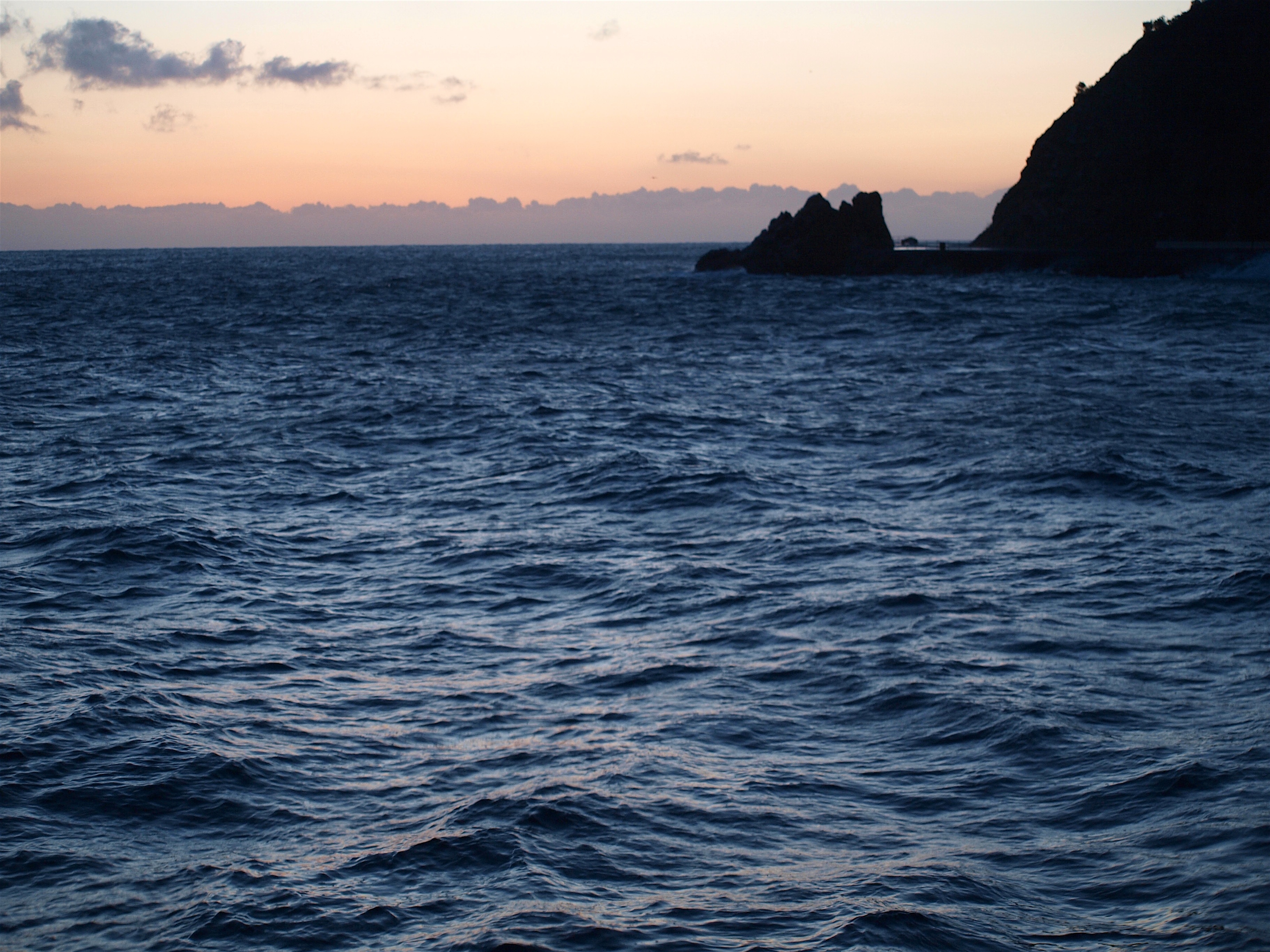
A lovely dawn looking from the Mole toward Lovers Cove and Rocky Point
However, first light often means bonito out on the Mole and a good opaleye bite out at the corner. The opaleye did show up and produced some excellent fishing for part of an hour but the bonito never did show. I caught a half dozen opaleye and a variety of other fish but finally we both decided for some cover from the wind. Although the wind had shown a slight reduction in intensity early in the morning, the fury returned and we moved the equipment down behind the buildings near the cove that I wanted to check out.
Luckily the south end of the Mole is behind buildings and the more I studied the very far end, the area by the shore, the more I became convinced that it might yield a moray eel, the fish I’ve been seeking out this past year. That small cove at the end of the Mole looked promising—an area abutting a rocky shoreline with numerous holes.
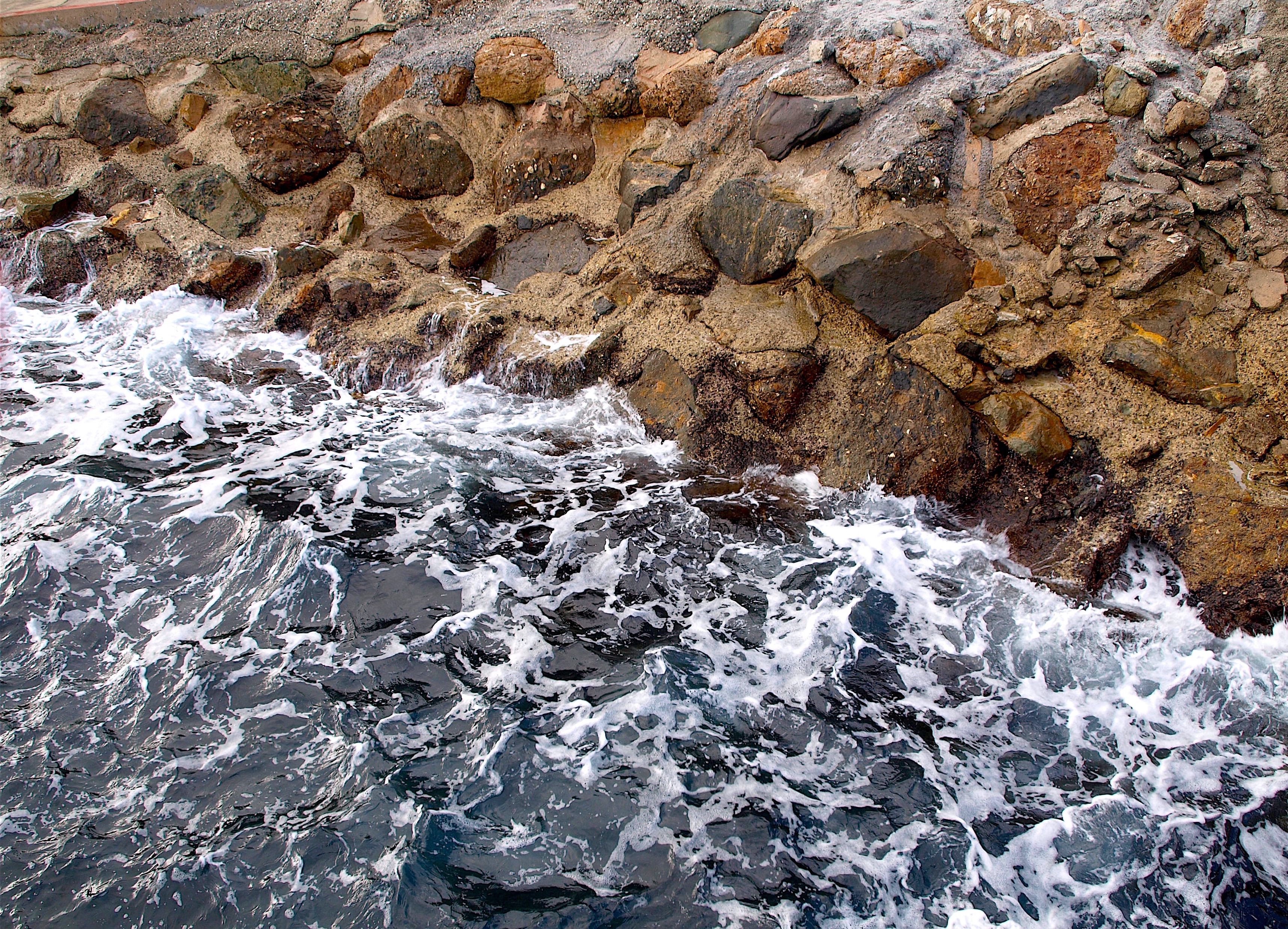
Soon I was dropping a single bait down into a rocky area filled with holes and crevices and soon had a few taps that gave promise. Like other piers that extend over rocks in inshore areas, the hard thing to do is avoid tangling sinker or hooks in the crevices that contain the fish. At low tide you can see the holes and promising areas and get an idea what you want to do. But given the waves and surge it isn’t easy to keep your rigs from being lost. What you have to do is feel the rocks, the difference between kelp-grabs and fish, when to pull and when to let the let the rig be free. You want the sinker lightly resting on the bottom and you have to be prepared for every strike.
As I was fishing I thought over how many times I have done this and how easy it would be to lose some rigs (and you almost always lose at least a few). But I could feel what was happening to the sinker. I wondered what would happen if you shut your eyes and forced yourself to feel the bottom; I tried it and I even seemed to feel the bottom better. I’m not suggesting you always close your eyes when fishing but it may not be a bad idea to practice closing the eyes at times and seeing if you can better feel and visualize the bottom? Just a thought!
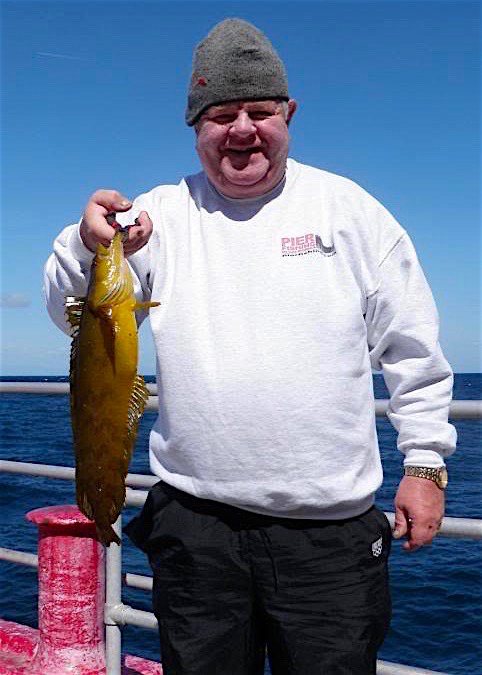
A good-sized giant kelpfish — and astill cold KJ with several layers of clothing.
No matter my success in keeping the sinker out of a crevice, the area did not produce a moray. I did manage a few fish including a large 16 1/8-inch giant kelpfish that was a good size fish for the species. The nets had been put away by this time and Hashem had joined in the fishing. We continued to fish through the morning but the bite was fairly slow and surprisingly the wind had started to increase.
Hashem wandered over to the Ferry office to confirm our reservations and when he returned he said, “do you want the good news first or the bad news?” The bad news was that all ferries were cancelled for the day and we were stuck on the island. The good news was that we were stuck in Catalina. We would have to get a motel, figure out a way to keep our fish and lobsters on ice, and be forced to spend an additional day fishing at Catalina—oh no! Once more we moved to the Green Pleasure Pier and its fish but now we were both really tired and stopped early.
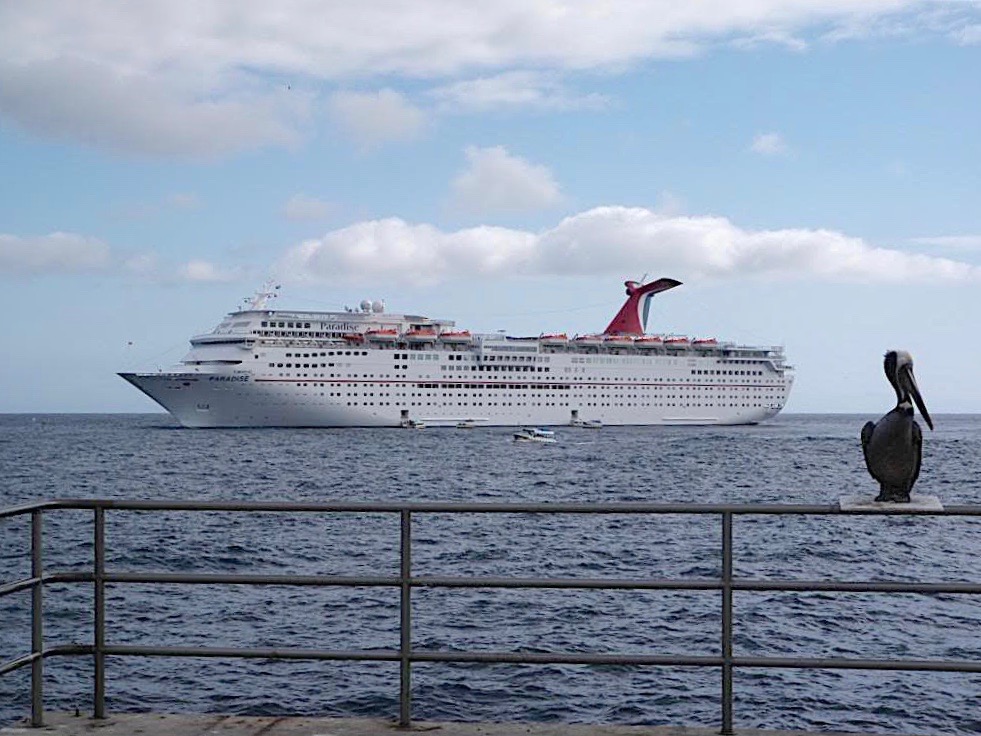
The next morning seemed to be beautiful. There was slight breeze, a big cruise ship was sitting just out from the Mole, and we expected an uneventful ferry ride back to the mainland. It WAS beautiful at 7 a.m. but by 8:30 conditions were starting to change. The wind was picking up and the single red flag of the early morning was changed into another two-flag warning.
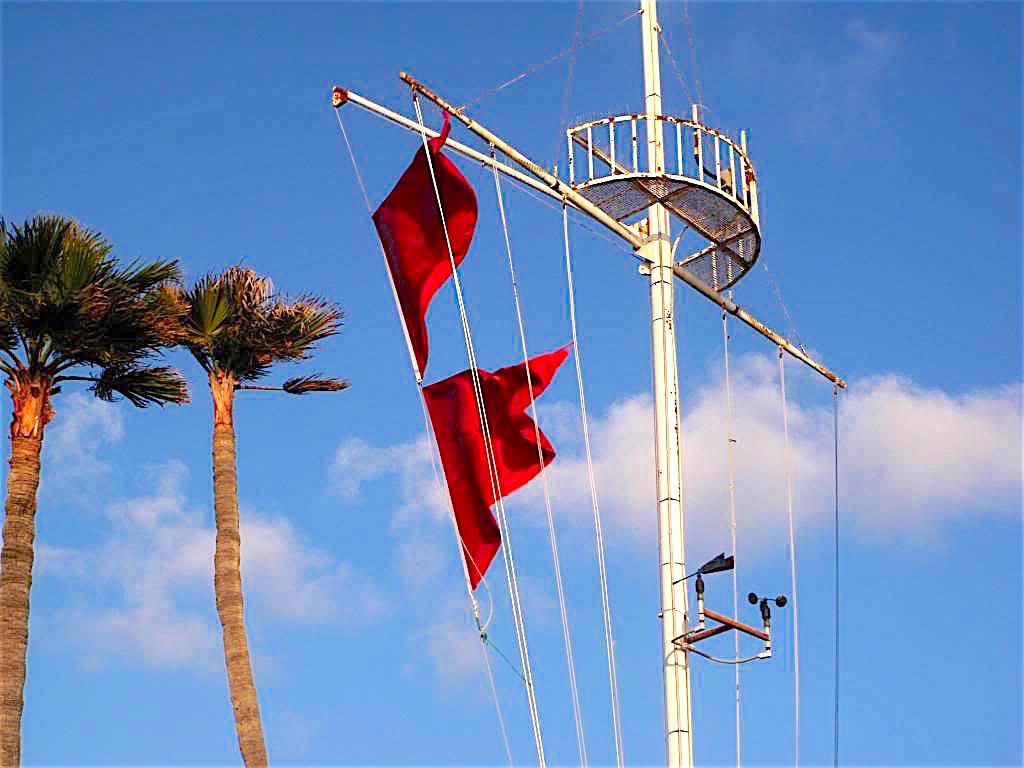
It was a two-flag morning meaning the wind was picking up and the ocean would be rough
We had skipped the 8 a.m. ferry and instead chose the 11:30 departure time. Turned out it would be the last boat back to San Pedro for the day and it would be a bumpy ride home.
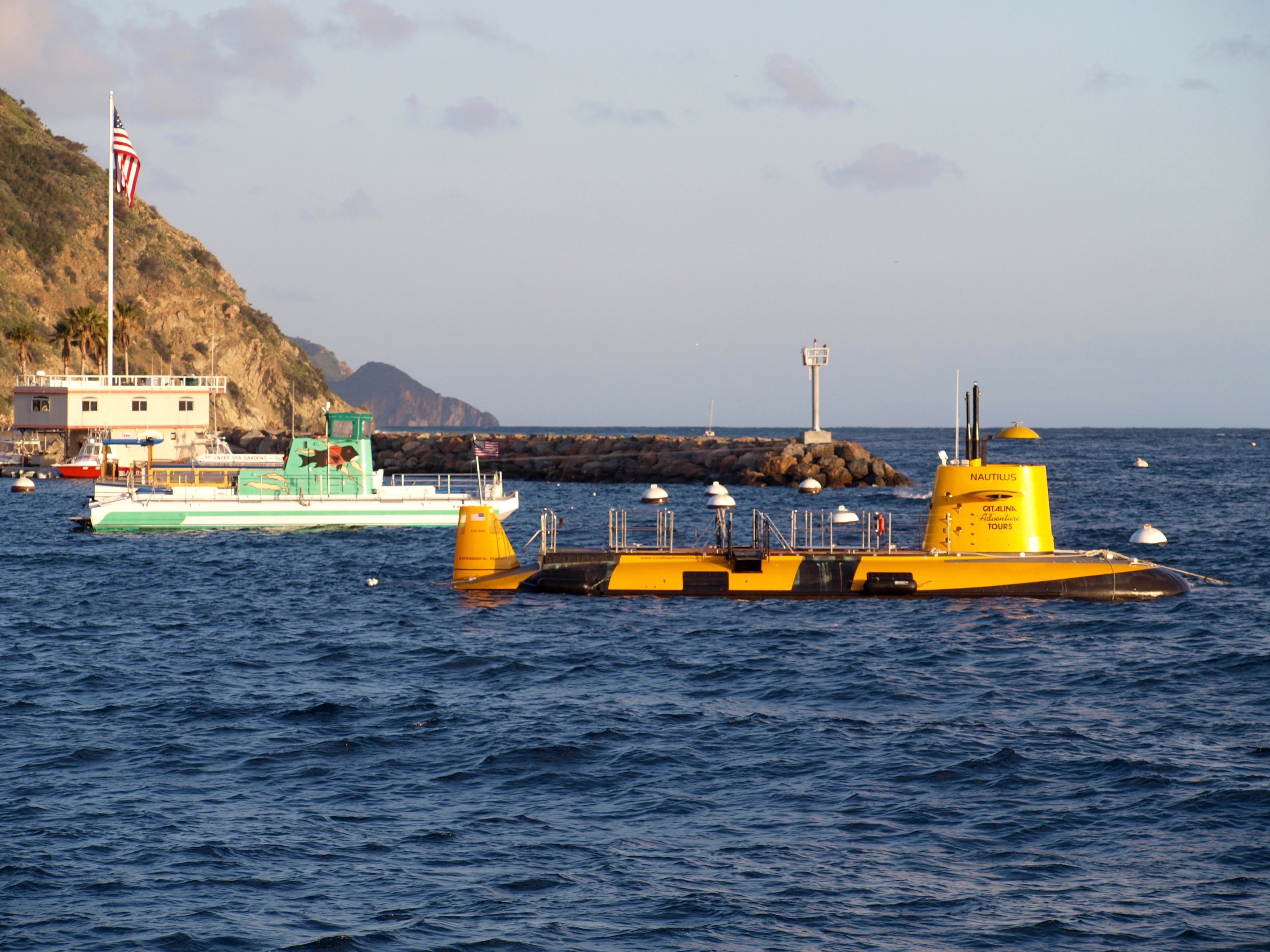
The local fleet was grounded
As for the fishing, we opted out that last morning. Although I normally would have been up early to fish, everything was packed away and I simply felt no need to add another hour of fishing to the itinerary. Although the fishing was fairly slow, I had caught an even 100 fish on the trip and most were decent-size fish. It was time to relax and go home.
<*}}}}}}}}}>< — Most people want to follow the rules; some do not care. The following note was sent to me by one of the PFIC regulars in 2016. The story concerned giant (black) sea bass ,a protected and illegal species that is seen quite often at Catalina.
Date: 11/22/2016 — There was an angler who was on the same boat as me that had heavy duty setup. He told me that he was targeting black sea bass. He knew it was illegal to keep, yet he was targeting them. He hooked and brought one to the rocks. Using a gaff to hook his mouth he brought fish close enough to remove the hook and released the fish. By this time the fish was exhausted and floating belly side up… It was not doing too well and it was not able to turn itself.
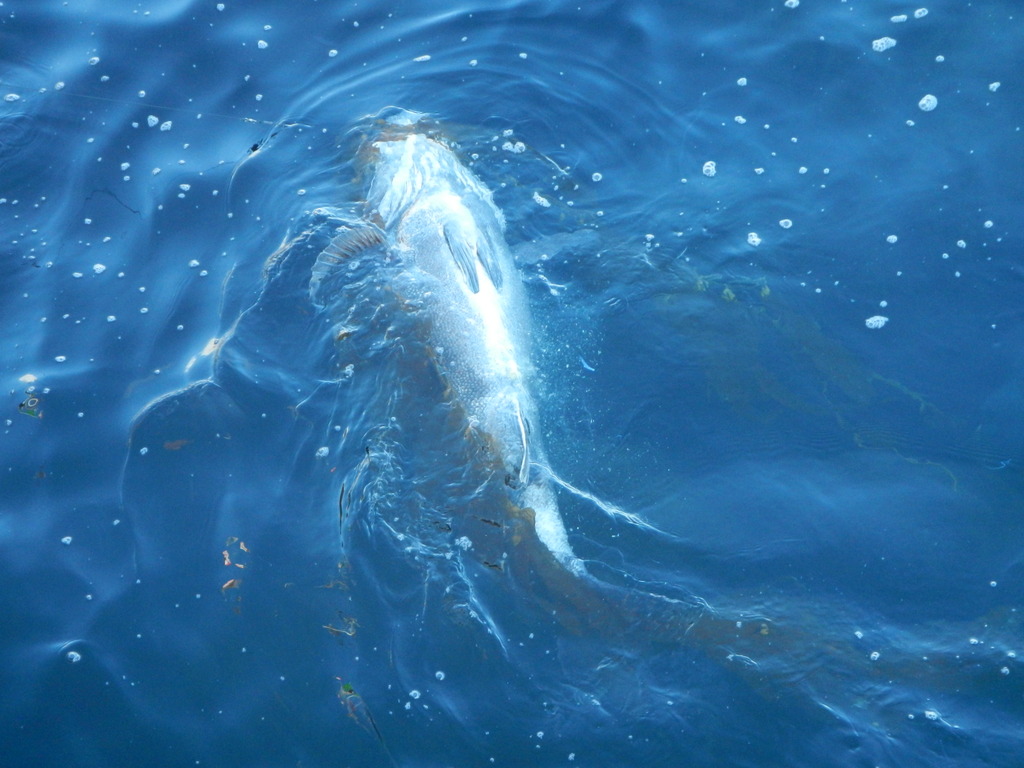
A Good Samaritan local was at Mole witnessing the release of the fish and the fish not being able to turn itself, took a boat and grabbed its tail and turned it right side up. The fish did a powerful kick and swam away. The angler continued fishing for them all day. Only one was “landed.” Next day I had to clean after him the trash that he had left and a filthy cutting board.
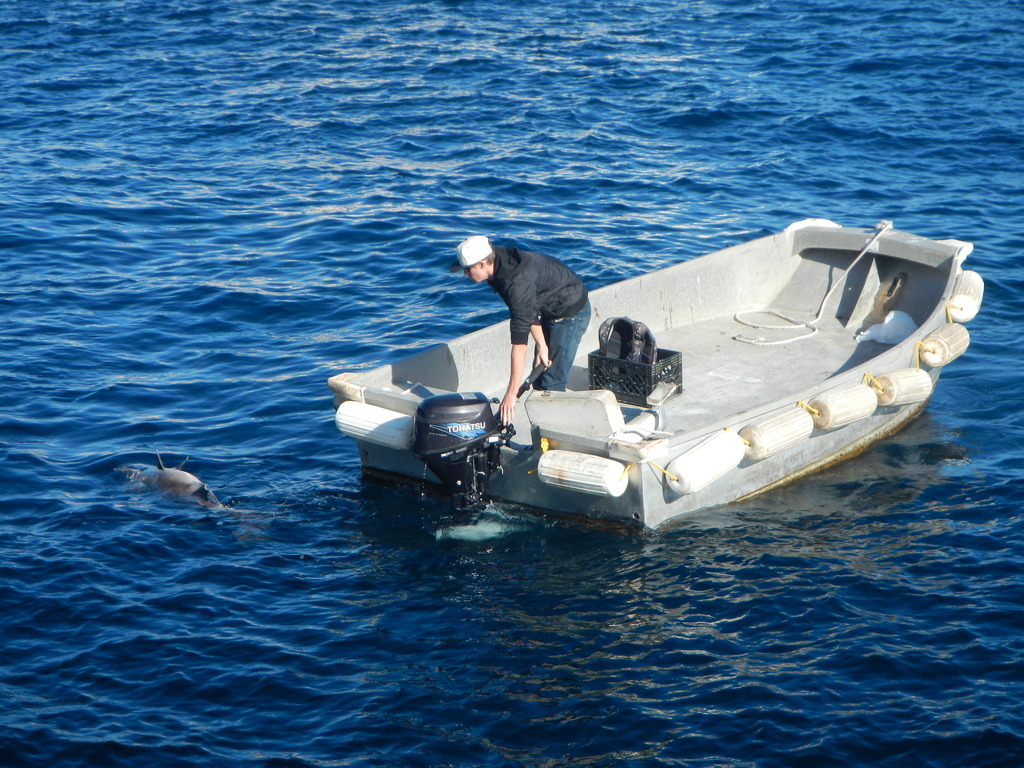
There is never a lack of dumb, imbecilic, shortsighted anglers who give a bad name to fishing and who make it really hard on those anglers who do try to be ethical anglers. A pox on this angler and others like him. [In addition, I’ve now been told the angler makes regular treks to Avalon to seek out the giant sea bass. Why are the wardens of the Fish and Wildlife Department or Harbor Patrol unable to stop him?]
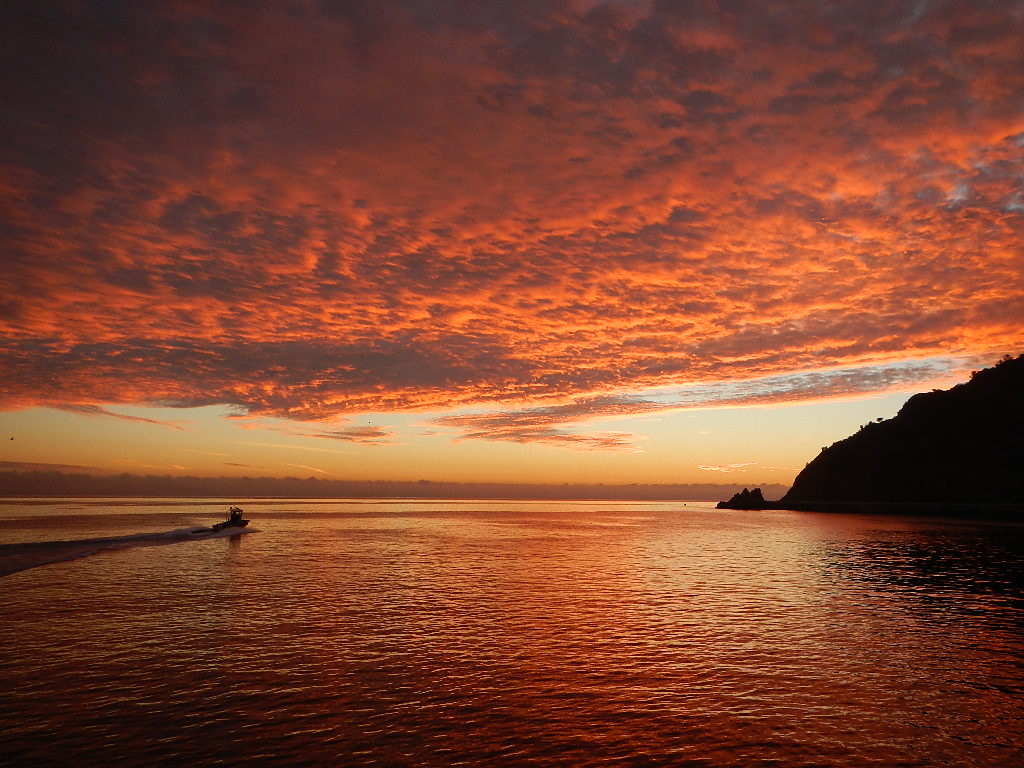
A beautiful sunset picture from the Mole taken by Mahigeer (Hashem Nahid)
<*}}}}}}}}}>< — Raymond Chandler, creator of the famous detective Philip Marlowe (the main character in several of his books), was known for his colorful, unique and non-stop descriptions of people, places and things. In Farewell, My Lovely, he had Marlowe describe a colorfully dressed character: “he looked about as inconspicuous as a tarantula on a slice of angel food.” The same could be said of garibaldi.
When you get off the ferry that brings you from the mainland to Avalon one of the first things you may see in the crystal-clear water by the landing dock are those tarantulas, I mean garibaldi. They’re Catalina’s gold fish and California’s state marine fish (golden trout get the freshwater honor). It seems fitting for the golden state.
You’ll see Garibaldi at the Mole and basically everywhere around the harbor. They’re illegal to keep but you will almost inevitably hook a few when you’re fishing for the other assorted species that make up the inshore mix. They’re pugnacious, hard fighting, territorial, and often good-sized, but handle them with care and gently return them to the water. Almost everyone considers them a special species to be protected and the thought isn’t new. The following appeared in the local newspaper nearly a hundred years ago.
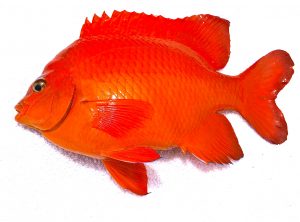
The Finny Bachelor — E. Cortisso
I know a little garden
Beneath a green-gold sea
Where bright, bronze plants are growin’
And grow so gracefully
Amidst their undulations
A flash of gold I spied;
And in and out the waving
Kelp it seemed to hide.
It was a little gold-fish
Who lived there all alone,
In this most lovely garden
In the Bay of Avalon.
Day after day I find him
Alone in his domains;
He darts, then lingers, to and fro,
And in his garden reigns.
I see that he is happy,
And that—his praise’ to One,
Who caused his life to happen
In the Bay of Avalon.
“Neath the music of the waters,
In his garden of the sea,
Long may that garden denizen
Enjoy immunity
Immunity from humans,
And maws of ev’ry gauge;
I want my little goldfish
To pass away from age!
—Catalina Islander, March 26, 1924
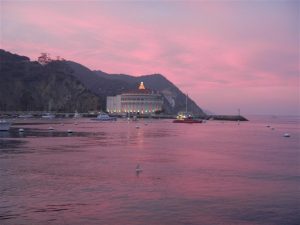
The Casino at Christmas time — Picture by Mahigeer (Hashem Nahid)
Cabrillo Mole Facts
Hours: The pier is open 24 hours a day.
Facilities: Tackle and bait is available a short way away at the Green Pleasure Pier. Lights and restrooms are found on the Mole. A snack bar is adjacent to the ticket office.
Handicapped Facilities: Handicapped restroom facilities; railings are 42 inches high. Some spots on the surface may not be good with regard to the wheels on wheel chairs.
Location: 34.14066900185003 N. Latitude, 119.19479370117188W. Longitude
How To Get There: Ferries to Avalon, Catalina Island, run on a regular schedule from San Pedro, Long Beach (the main location), Balboa and Dana Point. Once you get to Catalina you will be at the Mole since it is the site where you embark and disembark onto the ship that brought you to the island.
Management: City of Avalon.
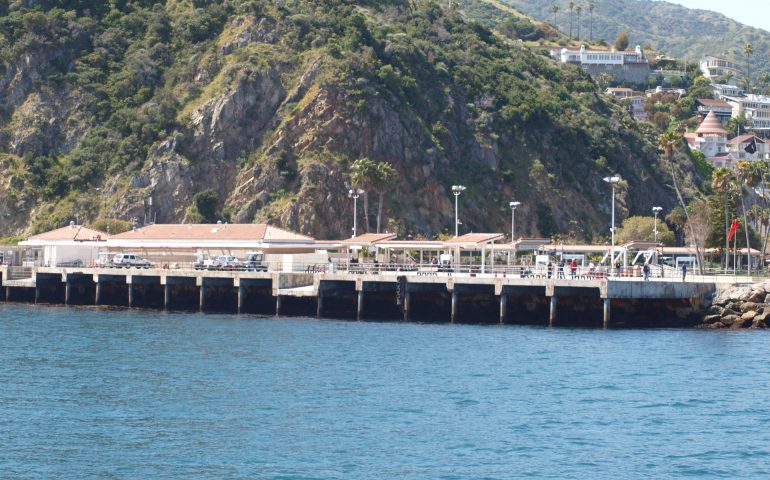
Mole is closed until december, unfortunately.
Hello Ken,
Thank you for putting together such a great collection of information about piers and pier fishing. I’ve learnt a lot.
I have a quick question: which month is best to go fishing at Cabrillo mole pier?
Thank you,
Han
[…] the festivities winding down, we went fishing at Cabrillo Mole. It was a major highlight of the boys’ trip to Catalina. They got to fish with grandpa and […]
Visit ij.start.canon to set up your Canon printer with ease. The website provides step-by-step instructions for downloading and installing drivers, ensuring seamless connectivity. Get assistance for various models and troubleshooting tips to keep your printer running smoothly. Start your Canon printer journey at ij.start.canon today!
Convert your favorite YouTube to MP3 easily with our fast and free online tool. Download high-quality audio in seconds without ads or limits. Enjoy seamless conversion on any device. No software required—just paste the link and get your MP3 instantly. Try it now for unlimited downloads!
Canon offers the best printers concerning the quality, functionality, and software support globally. Canon printers are perfect for home and office use as they provide a different range of printers best suited for every occupational purpose. To check out the latest range of high-performance printers, visit ij.start.canon and get started.